1. “Buy in July to watch your gold stocks fly!” That’s a time-tested mantra from “Goldlion”, who picks the junior mining stocks for my Graceland Juniors newsletter.
2. Sadly, this is not July. It’s the month of May, and May is part of the soft demand season for gold. The strong demand season typically runs from August to February.
3. A lot of gold stock investors want gold stocks to roar higher now, but nothing happens before its time. Interestingly, gold’s strong season begins just as stock market crash season begins.
4. Crash season for the US stock market typically runs from August to October. As the business cycle matures, stock market crash season becomes more dangerous and the strong demand season for gold offers more potential reward.
5. Please click here now. Double-click to enlarge. The soft price action is seasonally expected and there’s short term technical weakness, but there’s nothing overly negative, let alone bearish, on this daily gold chart.
6. Please click here now. Double-click to enlarge this magnificent weekly gold chart. Like Ray Dalio, I’ve suggested the next crisis will be a US dollar crisis more than an economic growth crisis.
7. That’s mainly because Trump administration is pro-growth and pro-business, but it’s also continued to grow both the government debt and the overall size of the government, all in the name of “making citizens great”.
8. This approach to running the government has greatly strengthened the private sector economy while greatly weakening the ability of the government to fund its insane debt and size growth in even a mild economic downturn.
9. In the next downturn, I expect the American private sector to weather the storm reasonably well while the government is forced to print money to fund itself. The bottom line:
10. In the last downturn, QE was used to promote growth and it was deflationary. In the next downturn, QE will be used to make up for lacklustre demand for government bonds, and it will be extremely inflationary.
11. Please click here now. Like America’s Warren Buffett, India’s Rakesh “RJ” Jhunjhunwala likes to heap praise on his government leaders instead of calling them out as extortionists and bullies.
12. Having said that, RJ has the same outlook for the private sector of India that I do in the medium and long-term; a move back towards 8%-9% GDP growth, and then a long-term stay in the double-digits range.
13. This gargantuan growth will increase gold demand quite substantially, and it’s likely to happen as the US government begins devaluing the dollar to manage its outrageous spending and debt. That will trigger fresh fear trade buying in America.
14. Please click here now. Double-click to enlarge this spectacular bitcoin chart. I expect a flag pattern will form, and then bitcoin should roar to the $20,000 area highs.
15. Most investors try to make money by buying what is hot, and they tend to get emotional about it. Bitcoin is not hot. It’s warm.
16. I focus on asset classes more than market timing, although I do that too. Investors build the most wealth, and stay sane doing it, by reducing their focus on what is hot, and instead focusing on making sure they own a piece of the asset class action.
17. The US stock market is part of the global stock markets asset class. So are Chindian stock markets. So, I own some US, Indian, and Chinese stock markets asset class action and I recommend that all investors own some too. It’s that simple.
18. Bitcoin and related crypto currencies are the newest asset class. There’s a lot of silly debate about whether gold is better than bitcoin, or vice-versa. I take the stand that it doesn’t matter which is better. What matters is that both are asset classes and investors need to get involved if they want to get richer. Period.
19. Some analysts claim that bitcoin is already more widely used as a payment mechanism than Paypal. That may or may not be true. Regardless, in time I think crypto will become as widely used as most government fiat, and governments will eagerly tax it with an electronic money transaction tax.
20. My prediction is that bitcoin isn’t going away but governments will ultimately make the most money from it. Investors who want to make money with it, albeit less than the government “people helpers” will make, can check out my crypto/blockchain newsletter at www.gublockchain.com.
21. Please click here now. Double-click to enlarge. I’ll make another prediction, which is that in the current pullback, gold stocks will bottom before bullion does.
22. So far in this month of May, GDX is already showing solid strength relative to gold.
23. Note the dramatic decline in volume from February. Declining volume that accompanies a price decline is a sign of a very healthy market.
24. My Graceland “traffic lights” proprietary technical system indicates that a Friday close over $23 would see a lot of gold stocks begin a major rally. I’ll be watching gold stocks closely for signs of a bullish non-confirmation with bullion… to jump-start that rally!
Special Offer For Website Readers: Please send me an Email to freereports4@gracelandupdates.com and I’ll send you my free “Golden Mid Caps!” report. I highlight gold producers that are not too big and not too small that are trading in the $2 to $10 price range with significant upside price action possible!
Thanks!!
Stewart Thomson
Graceland Updates
https://gracelandjuniors.com
www.guswinger.com
Email:
stewart@gracelandupdates.com
stewart@gracelandjuniors.com
stewart@guswinger.com
Stewart Thomson is a retired Merrill Lynch broker. Stewart writes the Graceland Updates daily between 4am-7am. They are sent out around 8am-9am. The newsletter is attractively priced and the format is a unique numbered point form. Giving clarity of each point and saving valuable reading time.
Risks, Disclaimers, Legal
Stewart Thomson is no longer an investment advisor. The information provided by Stewart and Graceland Updates is for general information purposes only. Before taking any action on any investment, it is imperative that you consult with multiple properly licensed, experienced and qualified investment advisors and get numerous opinions before taking any action. Your minimum risk on any investment in the world is: 100% loss of all your money. You may be taking or preparing to take leveraged positions in investments and not know it, exposing yourself to unlimited risks. This is highly concerning if you are an investor in any derivatives products. There is an approx $700 trillion OTC Derivatives Iceberg with a tiny portion written off officially. The bottom line:
Are You Prepared?
The major gold miners’ stocks are drifting sideways with gold, their early-year momentum sapped by the recent stock-market euphoria. But they are more important than ever for prudently diversifying portfolios, a rare sector that surges when stock markets weaken. Their just-reported Q1’19 results reveal how gold miners are faring as a sector, and their current fundamentals are way better than bearish psychology implies.
The wild market action in Q4’18 again emphasized why investors shouldn’t overlook gold stocks. Every portfolio needs a 10% allocation in gold and its miners’ stocks. As the flagship S&P 500 broad-market stock index plunged 19.8% largely in that quarter to nearly enter a bear market, the leading gold-stock ETF rallied 11.4% higher in that span. That was a warning shot across the bow that these markets are changing.
Four times a year publicly-traded companies release treasure troves of valuable information in the form of quarterly reports. Required by the US Securities and Exchange Commission, these 10-Qs and 10-Ks contain the best fundamental data available to traders. They dispel all the sentiment distortions inevitably surrounding prevailing stock-price levels, revealing corporations’ underlying hard fundamental realities.
The definitive list of major gold-mining stocks to analyze comes from the world’s most-popular gold-stock investment vehicle, the GDX VanEck Vectors Gold Miners ETF. Launched way back in May 2006, it has an insurmountable first-mover lead. GDX’s net assets running $9.0b this week were a staggering 46.6x larger than the next-biggest 1x-long major-gold-miners ETF! GDX is effectively this sector’s blue-chip index.
It currently includes 46 component stocks, which are weighted in proportion to their market capitalizations. This list is dominated by the world’s largest gold miners, and their collective importance to this industry cannot be overstated. Every quarter I dive into the latest operating and financial results from GDX’s top 34 companies. That’s simply an arbitrary number that fits neatly into the tables below, but a commanding sample.
As of this week these elite gold miners accounted for fully 94.3% of GDX’s total weighting. Last quarter they combined to mine 274.4 metric tons of gold. That was 32.2% of the aggregate world total in Q1’19 according to the World Gold Council, which publishes comprehensive global gold supply-and-demand data quarterly. So for anyone deploying capital in gold or its miners’ stocks, watching GDX miners is imperative.
The largest primary gold miners dominating GDX’s ranks are scattered around the world. 20 of the top 34 mainly trade in US stock markets, 6 in Australia, 5 in Canada, 2 in China, and 1 in the United Kingdom. GDX’s geopolitical diversity is excellent for investors, but makes it more difficult to analyze and compare the biggest gold miners’ results. Financial-reporting requirements vary considerably from country to country.
In Australia, South Africa, and the UK, companies report in half-year increments instead of quarterly. The big gold miners often publish quarterly updates, but their data is limited. In cases where half-year data is all that was made available, I split it in half for a Q1 approximation. While Canada has quarterly reporting, the deadlines are looser than in the States. Some Canadian gold miners drag their feet in getting results out.
While it is challenging bringing all the quarterly data together for the diverse GDX-top-34 gold miners, analyzing it in the aggregate is essential to see how they are doing. So each quarter I wade through all available operational and financial reports and dump the data into a big spreadsheet for analysis. The highlights make it into these tables. Blank fields mean a company hadn’t reported that data as of this Wednesday.
The first couple columns of these tables show each GDX component’s symbol and weighting within this ETF as of this week. While most of these stocks trade on US exchanges, some symbols are listings from companies’ primary foreign stock exchanges. That’s followed by each gold miner’s Q1’19 production in ounces, which is mostly in pure-gold terms. That excludes byproduct metals often present in gold ore.
Those are usually silver and base metals like copper, which are valuable. They are sold to offset some of the considerable expenses of gold mining, lowering per-ounce costs and thus raising overall profitability. In cases where companies didn’t separate out gold and lumped all production into gold-equivalent ounces, those GEOs are included instead. Then production’s absolute year-over-year change from Q1’18 is shown.
Next comes gold miners’ most-important fundamental data for investors, cash costs and all-in sustaining costs per ounce mined. The latter directly drives profitability which ultimately determines stock prices. These key costs are also followed by YoY changes. Last but not least the annual changes are shown in operating cash flows generated, hard GAAP earnings, revenues, and cash on hand with a couple exceptions.
Percentage changes aren’t relevant or meaningful if data shifted from positive to negative or vice versa, or if derived from two negative numbers. So in those cases I included raw underlying data rather than weird or misleading percentage changes. Companies with symbols highlighted in light-blue have newly climbed into the elite ranks of GDX’s top 34 over this past year. This entire dataset together is quite valuable.
It offers a fantastic high-level read on how the major gold miners are faring fundamentally as an industry and individually. While the endless challenge of growing production continues to vex plenty of the world’s larger gold miners, they generally performed much better in Q1’19 than today’s low gold-stock prices reflect. Last quarter was also a big transition one as the recent gold-stock mega-mergers continued to settle out.
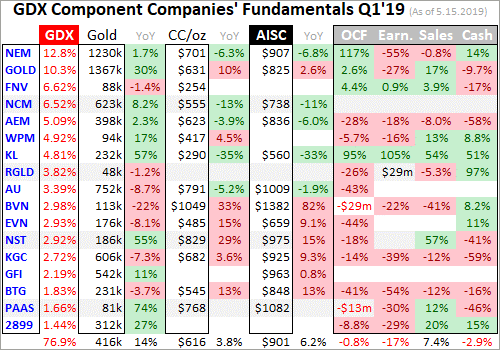
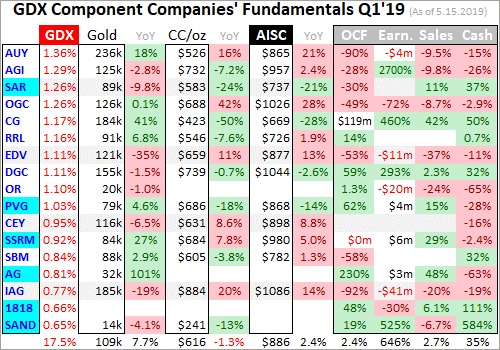
Production has always been the lifeblood of the gold-mining industry. Gold miners have no control over prevailing gold prices, their product sells for whatever the markets offer. Thus growing production is the only manageable way to boost revenues, leading to amplified gains in operating cash flows and profits. Higher output generates more capital to invest in expanding existing mines and building or buying new ones.
Gold-stock investors have long prized production growth above everything else, as it is inexorably linked to company growth and thus stock-price-appreciation potential. But for several years now the major gold miners have been struggling to grow production. Large economically-viable gold deposits are getting increasingly harder to find and more expensive to exploit, with the low-hanging fruit long since picked.
Gold miners’ exploration budgets have cratered since gold collapsed in Q2’13, plummeting 22.8%! That was the yellow metal’s worst quarter in an astounding 93 years, which devastated sentiment and scared investors away from this sector. Much less capital to explore shrank the pipeline of new finds to replace relentless depletion at existing mines. That left major gold miners just one viable option to grow their output.
They either have to buy existing mines and/or deposits from other companies, or acquire those outright. That’s unleashed a merger-and-acquisition wave that culminated in recent quarters. In September 2018 gold giant Barrick Gold announced it was merging with Randgold. Not to be outdone, in January 2019 the other gold behemoth Newmont Mining declared it was acquiring Goldcorp in another colossal mega-deal.
I wrote a whole essay analyzing these mega-mergers in mid-February, and believe they are bad for this sector for a variety of reasons. For our purposes today, Q1’19 was the first quarter fully reflecting the new Barrick including Randgold. But Newmont’s acquisition of Goldcorp wasn’t finalized until April 2019, so that isn’t included in NEM’s Q1’19 results. And unfortunately Goldcorp’s weren’t published separately either.
That makes analyzing the GDX top 34’s gold production last quarter more complicated than usual. As far as I can tell, Newmont released nothing on Goldcorp’s Q1 operations. As usual when one company buys out another, the acquired company’s website is quickly effectively deleted. It is replaced with a tiny new website largely devoid of useful information, that redirects to the new combined company’s main website.
So Goldcorp’s Q1 results were apparently cast into a black hole, never to be seen by investors. Across last year’s four quarters, Goldcorp ranked as the 5th-to-7th-largest GDX component. So excluding it from this leading gold-stock ETF skews all kinds of Q1 numbers. This discontinuity will resolve itself over the next couple quarters as Newmont and Goldcorp are fully integrated into the new, wait for it, “Newmont Goldcorp”.
In Q1’19 these top 34 GDX gold miners produced 8.8m ounces of gold, which was down a sharp 6.3% from Q1’18’s levels. But Goldcorp averaged 574k ounces of quarterly production in 2018. If that is added in, Q1’19’s climbs to 9.4m ounces which is only off a slight 0.2% YoY. Stable gold output is a victory for the major gold miners, as there have been plenty of recent quarters where their production has declined.
But depletion is still a huge challenge for them, as they are losing market share to smaller gold miners that aren’t so unwieldy to manage. The World Gold Council publishes the best global gold fundamental supply-and-demand data quarterly. According to its latest Q1’19 Gold Demand Trends report, total world mine production actually climbed 1.1% YoY in Q1. So the larger gold miners continue to underperform.
On a quarter-over-quarter basis since Q4’18, the GDX top 34’s gold production plunged 8.8%! But again that is overstated by Goldcorp’s missing-in-action Q1 output. Add in that 2018 quarterly approximation, and that decline moderates to 2.8% QoQ. The quarter-to-quarter output dynamics among the major gold miners are somewhat surprising. Gold is not produced at a steady pace year-round as logically assumed.
Going back to 2010, the world gold mine production per the WGC has averaged sharp 7.2% QoQ drops from Q4s to Q1s! For many if not most major gold miners, calendar years’ first quarters mark the low ebb in their annual output. The gold miners attribute this Q1 lull to new capital spending that slows production as mine infrastructure is upgraded. That weaker output in Q1s is regained with big jumps in following quarters.
In that same decade-long WGC dataset, Q2s saw world mine production average big 5.4% QoQ surges from Q1s! That sharp acceleration trend continued in Q3s, which averaged additional 5.3% QoQ growth from Q2s. Then that petered out on average in Q4s, which were only 0.5% better than Q3s. So it is normal for gold miners’ production to fall sharply in years’ Q1s before rebounding strongly in Q2s and Q3s.
There’s more to this intra-year seasonality than capital spending though. Mine managers play a big role in how they plan their ore sequencing. Individual gold deposits are not homogenous, but have varying richness throughout their orebodies. Mine managers have to decide which ore to mine in any quarter, which is fed through their fixed-capacity mills for crushing and gold recovery. Ore grade determines output.
The more gold per ton of ore dug and hauled in any quarter, the more gold produced. Mine managers choose to process more lower-grade ores in Q1s, then move to higher-grade ore mixes in Q2s and Q3s. That helps maximize their incentive bonuses. Q3 results are reported in early-to-mid Novembers soon before year-ends. Higher production boosts stock prices heading into that year-end bonus-calculation time!
Realize that Q1 results reported from early-to-mid Mays generally show a year’s weakest gold output. It is surprising to see investors sell gold stocks hard when Q1’s production declines from Q4’s, as this is par for the course in this industry. The bright side is excitement later builds throughout the year as Q2’s and Q3’s production grows fast. The gold miners look better fundamentally later in years than earlier in them!
With year-over-year gold production among the GDX top 34 effectively flat in Q1’19 with Goldcorp’s likely output added back in, odds argued against much of a change in gold-mining costs. They are largely fixed quarter after quarter, with actual mining requiring the same levels of infrastructure, equipment, and employees. These big fixed costs are spread across production, making unit costs inversely proportional to it.
There are two major ways to measure gold-mining costs, classic cash costs per ounce and the superior all-in sustaining costs per ounce. Both are useful metrics. Cash costs are the acid test of gold-miner survivability in lower-gold-price environments, revealing the worst-case gold levels necessary to keep the mines running. All-in sustaining costs show where gold needs to trade to maintain current mining tempos indefinitely.
Cash costs naturally encompass all cash expenses necessary to produce each ounce of gold, including all direct production costs, mine-level administration, smelting, refining, transport, regulatory, royalty, and tax expenses. In Q1’19 these top-34-GDX-component gold miners that reported cash costs averaged $616 per ounce. That actually fell a sharp 7.7% YoY, down on the low side of recent years’ cash-cost range.
Investor sentiment in gold-stock land has been really poor, as recent months’ extreme stock euphoria has really stunted interest in gold. If stock markets seemingly do nothing but rally indefinitely, then why bother prudently diversifying stock-heavy portfolios with counter-moving gold? There’s been increasing chatter lately about the gold-mining industry’s viability, which isn’t unusual when psychology waxes quite bearish.
Those worries are ridiculous with the major gold miners’ cash costs averaging in the low $600s even in Q1’s low-quarterly-output ebb. As long as gold remains well above $616, this neglected sector faces no existential threat. And Q1’s top-34-GDX-average cash costs are even skewed higher by one struggling gold miner, Peru’s Buenaventura. In Q1’19 it suffered a sharp 22.2% YoY plunge in gold production.
That was primarily due to the company stopping extraction operations at one of its key mines in January to rejigger and centralize it. That lower output to spread mining’s big fixed costs across was enough to catapult BVN’s Q1 cash costs 33.1% higher YoY to an extreme $1049 per ounce. Those are expected to mean revert much lower in coming quarters. Ex-BVN the rest of the GDX top 34 averaged merely $600.
Way more important than cash costs are the far-superior all-in sustaining costs. They were introduced by the World Gold Council in June 2013 to give investors a much-better understanding of what it really costs to maintain gold mines as ongoing concerns. AISCs include all direct cash costs, but then add on everything else that is necessary to maintain and replenish operations at current gold-production levels.
These additional expenses include exploration for new gold to mine to replace depleting deposits, mine-development and construction expenses, remediation, and mine reclamation. They also include the corporate-level administration expenses necessary to oversee gold mines. All-in sustaining costs are the most-important gold-mining cost metric by far for investors, revealing gold miners’ true operating profitability.
The GDX-top-34 gold miners reported average AISCs of $893 per ounce in Q1’19, up merely 1.0% YoY. These flat AISCs are right in line with flat production when Goldcorp’s likely output is added back in. The big operational challenges at Buenaventura also rocketed its AISCs an incredible 82.3% higher YoY to an anomalous $1382 per ounce. Excluding BVN, the rest of the GDX top 34 averaged $874 AISCs in Q1.
That’s right in line with the past couple calendar years’ quarterly average of $872. The major gold miners, despite still struggling to grow their production enough to exceed depletion, are still holding the line on all-important costs. Those stable costs regardless of prevailing gold prices are what make the gold stocks so attractive. They have massive upside potential as their profits amplify the higher gold prices still coming.
The gold price averaged $1303 in Q1’19. Subtracting the major gold miners’ average $893 AISCs from that yields strong profits of $410 per ounce. While recent years’ universal stock-market euphoria has capped gold at $1350 resistance, it has still been grinding higher on balance carving higher lows. Gold is getting wound tighter and tighter towards a major upside breakout to new bull highs well above $1350.
Like usual gold investment demand will be rekindled when the stock markets inevitably roll over materially again, propelling gold higher. A mere 7.7% upleg from $1300 would carry gold to $1400, and just 15.4% would hit $1500. Those are modest and easily-achievable gains by past-gold-upleg standards. During essentially the first half of 2016 after major stock-market selloffs, gold blasted 29.9% higher in 6.7 months!
At $1300 and Q1’s $893 average AISCs, the major gold miners are earning $407 per ounce. But at $1400 and $1500 gold, those profits soar to $507 and $607. That’s 24.6% and 49.1% higher on relatively-small 7.7% and 15.4% gold uplegs from here! This inherent profits leverage to gold is why the major gold stocks of GDX tend to amplify gold uplegs by 2x to 3x or so. Investors enjoy large gains as gold rallies.
Despite investors’ serious apathy for this sector, the gold miners’ costs remain well-positioned to fuel big profits growth in a higher-gold-price environment. Investors love rising earnings, which are looking to be scarce in the general stock markets this year. The better gold miners’ stocks are likely to see big capital inflows as gold continues climbing on balance, which will drive them and to a lesser extent GDX much higher.
The GDX top 34’s accounting results weren’t as impressive as their flat production and costs in Q1. The lack of Goldcorp’s operations being accounted for last quarter again distorted normal annual comparisons. So all these Q1’19 numbers are compared to Q1’18’s excluding Goldcorp. Last quarter’s average gold price being 1.9% lower than Q1’18’s average also played a role in weaker year-over-year performance.
The GDX top 34’s total revenues fell 5.2% YoY ex-Goldcorp to $9.2b in Q1’19. That’s reasonable given the slightly-lower production and gold prices. Lower byproduct silver output also contributed, as a half-dozen of these elite major gold miners also produce sizable amounts of silver. Again without Goldcorp, the total silver output among the GDX top 34 fell 8.0% YoY to 27.3m ounces in Q1 weighing on total sales.
Their overall cash flows generated from operations mirrored this weakening trend, down 9.1% YoY to $2.8b last quarter. Still the GDX-top-34 gold miners were producing lots of cash as the big profits gap between their AISCs and prevailing gold prices implied. Only two of these major gold miners suffered significant negative OCFs, and one of those was naturally Buenaventura with all its production struggles.
These elite gold miners remained flush with cash at the end of Q1, reporting $11.1b on their books. That is 11.3% lower YoY without Goldcorp. The gold miners tap into their cash hoards when they are building or buying mines, so declines in overall cash balances suggest more investment in growing future output. Investors fretting about the gold-mining industry today aren’t following their strong operating cash flows.
Last but not least are the GDX top 34’s hard accounting profits under Generally Accepted Accounting Principles. These are the actual quarterly earnings reported to the SEC and other regulators. Overall profits excluding Goldcorp only declined 7.2% YoY to $731m in Q1’19. That’s really impressive in light of the 5.2%-lower revenues. Prior quarters’ big mine-impairment charges on lower gold prices also dried up.
So the major gold miners included in this sector’s leading ETF are doing a lot better than investors are giving them credit for. There’s no fundamental reason for this critical portfolio-diversifying contrarian sector to be shunned. Gold stocks’ only problem is the lack of upside action in gold, which will quickly change once the stock markets decisively roll over again. December 2018 proved these relationships still work.
As the S&P 500 plunged 9.2% that month, investors remembered the timeless wisdom of keeping some gold and gold miners’ stocks in their portfolios. So they started shifting capital back in, driving gold 4.9% higher that month which GDX leveraged to a big 10.5% gain! Gold and its miners’ stocks act like portfolio insurance when stock markets sell off. Everyone really needs a 10% allocation in gold and gold stocks!
That being said, GDX isn’t the best way to do it. This ETF’s potential upside is retarded by the large gold miners struggling to grow their production. Investment capital will seek out the smaller mid-tier and junior gold miners actually able to increase their output. It’s far better to invest in these great individual miners with superior fundamentals. While plenty are included in GDX, their relatively-low weightings dilute their gains.
GDX’s little-brother ETF GDXJ is another option. While advertised as a “Junior Gold Miners ETF”, it is really a mid-tier gold miners ETF. It includes most of the better GDX components, with higher weightings since the largest gold majors are excluded. I wrote an entire essay in mid-January explaining why GDXJ is superior to GDX, and my next essay a week from now will delve into the GDXJ gold miners’ Q1’19 results.
Back in essentially the first half of 2016, GDXJ rocketed 202.5% higher on a 29.9% gold upleg in roughly the same span! While GDX somewhat kept pace then at +151.2%, it is lagging GDXJ more and more as its weightings are more concentrated in stagnant gold super-majors. The recent mega-mergers are going to worsen that investor-hostile trend. Investors should buy better individual gold stocks, or GDXJ, instead of GDX.
One of my core missions at Zeal is relentlessly studying the gold-stock world to uncover the stocks with superior fundamentals and upside potential. The trading books in both our popular weekly and monthly newsletters are currently full of these better gold and silver miners. Mostly added in recent months as gold stocks recovered from deep lows, their prices remain relatively low with big upside potential as gold rallies!
If you want to multiply your capital in the markets, you have to stay informed. Our newsletters are a great way, easy to read and affordable. They draw on my vast experience, knowledge, wisdom, and ongoing research to explain what’s going on in the markets, why, and how to trade them with specific stocks. As of Q1 we’ve recommended and realized 1089 newsletter stock trades since 2001, averaging annualized realized gains of +15.8%! That’s nearly double the long-term stock-market average. Subscribe today for just $12 per issue!
The bottom line is the major gold miners performed pretty well last quarter. Their production held steady despite lower prevailing gold prices and inexorable depletion. That led to flat costs right in line with prior years’ average levels. That leaves gold-mining earnings positioned to soar higher in future quarters as gold continues slowly grinding higher on balance. Another major stock-market selloff will accelerate that trend.
Stock investors are making a serious mistake ignoring gold and its miners’ stocks. The bearish sentiment plaguing this sector today is irrational given miners’ solid fundamentals. Diversifying is best done before it is necessary, buying low with gold-stock prices so beaten-down. This is the only sector likely to rally fast amplifying gold’s upside when stock markets inevitably swoon again. Don’t overlook the great opportunity here!
Adam Hamilton, CPA
May 21, 2019
Copyright 2000 – 2019 Zeal LLC (www.ZealLLC.com)
1. The short seasonal rally for gold that typically follows India’s Akha Teej holiday (May 7 this year) is in play but this time it is being “juiced” by a major U.S. stock market meltdown!
2. In a game with nine innings, the U.S. business cycle is probably in the eighth or ninth inning.
3. Stock market welfare programs provided by central banks (QE and intense rate cuts) have extended the bull market in stocks. QE is a vile form of corporate socialism. Horrifically, QE is maniacally embraced by governments around the world.
4. Extreme interest rate cuts are a tool to attack elderly savers and make small business loans unprofitable, while promoting stock market buybacks that enrich the elite. These rate cuts and QE also promote government debt worship.
5. The debt worship, which is particularly prevalent in America, has exponentially increased the danger of a 1929-style global stock markets crash. Ominously, it’s happening as the business cycle peaks and a wave of de-dollarization is racing across the globe.
6. U.S. oil company profits have played a big role in overall stock market earnings, and oil suddenly looks quite shaky.
7. The tech-weighted Nasdaq has done better than the Dow in recent years, but the latest tariff tax tantrums thrown by U.S. and Chinese governments could become big nails in the overall earnings growth coffin.
8. Please click here now. Mike Wilson is one of America’s most influential stock market analysts. He suggests that America is headed for recession if more tariffs are coming. I’ve predicted more tariffs are on the way, and here to stay!
9. The tariffs are here for the long-term because the decline of America as lead empire is long-term. Some major bank economists and analysts are also beginning to adopt this view.
10. My www.guswinger.com swing trade service caught all the latest downside action in the Nasdaq as well as the stunning rally in the dollar against the yuan in the FOREX market. These swing trades are mechanical. They are not influenced by U.S. government “world growth leader” propaganda and debt worship.
11. Please click here now. Double-click to enlarge. The Dow has gone nowhere since the tariff taxes were launched. I predict it will continue to go nowhere.
12. Horrifically, at this stage of the business cycle a meltdown is as likely as sideways action. The only people making any money in this stock market are short-term traders and dividend investors.
13. Please click here now. Double-click to enlarge this superb gold chart. The bull wedge breakout is impressive but until the dollar collapses against the yen I would not get overly excited about gold’s immediate prospects for substantially higher prices.
14. On that note, please click here now. Double-click to enlarge. I warned investors about the importance of the 109.50 price zone on this USD vs yen chart.
15. A sustained decline below 109.50 would likely see gold challenge the $1350 area highs and the U.S. stock market could enter an “incineration” phase.
16. The influence of Chinese citizens on the gold price should not be underestimated. The tariff taxes are creating a wave of nationalism but also concern about the stock market.
17. When risks rise, bank FOREX traders buy the yen, sell the dollar, and China goes for the gold!
18. I don’t expect the Chinese government to aggressively sell US T-bonds right now, but more U.S. tariffs are likely and then I expect significant T-bond selling to get underway.
19. That will create concerning inflation in America as the U.S. government is forced to either print money or raise rates to peddle its debt to cautious domestic buyers. Hedge fund “supremo” Ray Dalio has predicted America’s future is an inflationary depression. Going forward, all roads lead to gold.
20. Please click here now. Double-click to enlarge this GDX chart. There’s nothing negative about the price action in most gold stocks right now. It’s all positive. Note the burst of volume during yesterday’s spectacular GDX rally….
21. A rally that occurred while the Dow tumbled 600 points!
22. In the big picture, it’s quite rare for gold stocks to fall while the stock market falls. It happened in 2008 due to system risk but that’s the exception to the gold stocks versus stock market rule.
23. Volume has generally softened since the February strong demand season peak after generally rising during the September-February rally. Note my 14,7,7 Stochastics series buy signal that is just occurring now. A Friday close above $23 is my “launchpad” number.
24. What would be the main feature of an inflationary depression? It would probably be extreme money printing conducted by the U.S. government. GDX has a realistic chance of hitting the $30 area in the second half of this year, and then going even higher in 2020. The good news for gold stock investors is that tariffs are not likely to go away until stock markets incinerate, inflation skyrockets, and the price of gold begins to go parabolic!
Special Offer For Website Readers: Please send me an Email to freereports4@gracelandupdates.com and I’ll send you my free “Make Gold Stock Profits Now!” report. I highlight key gold stock breakouts and include investor tactics to make money and limit risk. I also highlight the stunning action in bitcoin that is occurring during the stock market meltdown!
Stewart Thomson
Graceland Updates
https://gracelandjuniors.com
www.guswinger.com
Email:
stewart@gracelandupdates.com
stewart@gracelandjuniors.com
stewart@guswinger.com
Stewart Thomson is a retired Merrill Lynch broker. Stewart writes the Graceland Updates daily between 4am-7am. They are sent out around 8am-9am. The newsletter is attractively priced and the format is a unique numbered point form. Giving clarity of each point and saving valuable reading time.
Risks, Disclaimers, Legal
Stewart Thomson is no longer an investment advisor. The information provided by Stewart and Graceland Updates is for general information purposes only. Before taking any action on any investment, it is imperative that you consult with multiple properly licensed, experienced and qualified investment advisors and get numerous opinions before taking any action. Your minimum risk on any investment in the world is: 100% loss of all your money. You may be taking or preparing to take leveraged positions in investments and not know it, exposing yourself to unlimited risks. This is highly concerning if you are an investor in any derivatives products. There is an approx $700 trillion OTC Derivatives Iceberg with a tiny portion written off officially. The bottom line:
Are You Prepared?
The U.S. stock markets sure feel inflectiony, at a major juncture. After achieving new all-time record highs, sentiment was euphoric heading into this week. But those latest heights could be a massive triple top that formed over 15 months. Then heavy selling erupted in recent days as the U.S.-China trade war suddenly went hostile. The big U.S. stocks just-reported Q1’19 fundamentals will help determine where markets go next.
Four times a year publicly-traded companies release treasure troves of valuable information in the form of quarterly reports. Required by the U.S. Securities and Exchange Commission, these 10-Qs and 10-Ks contain the best fundamental data available to traders. They dispel all the sentiment distortions inevitably surrounding prevailing stock-price levels, revealing corporations’ underlying hard fundamental realities.
The deadline for filing 10-Qs for “large accelerated filers” is 40 days after fiscal quarter-ends. The SEC defines this as companies with market capitalizations over $700m. That currently includes every stock in the flagship S&P 500 stock index (SPX), which contains the biggest and best American companies. The middle of this week marked 38 days since the end of Q1, so almost all the big U.S. stocks have reported.
The SPX is the world’s most-important stock index by far, with its components commanding a staggering collective market cap of $24.9t at the end of Q1! The vast majority of investors own the big U.S. stocks of the SPX, as some combination of them are usually the top holdings of nearly every investment fund. That includes retirement capital, so the fortunes of the big U.S. stocks are crucial for Americans’ overall wealth.
The major ETFs that track the S&P 500 dominate the increasingly-popular passive-investment strategies as well. The SPY SPDR S&P 500 ETF, IVV iShares Core S&P 500 ETF, and VOO Vanguard S&P 500 ETF are among the largest in the world. This week they reported colossal net assets running $271.9b, $175.1b, and $111.5b respectively! The big SPX companies overwhelmingly drive the entire stock markets.
Q1’19 proved extraordinary, the SPX soaring 13.1% higher in a massive rebound rally after suffering a severe correction largely in Q4. That pummeled this key benchmark stock index 19.8% lower in jU.S.t 3.1 months, right on the verge of entering a new bear market at -20%. By the end of Q1, fully 5/6ths of those deep losses had been reversed. Did the big U.S. stocks’ fundamental performances support such huge gains?
Corporate-earnings growth was expected to slow dramatically in Q1, stalling out after soaring 20.5% last year. 2018’s four quarters straddled the Tax Cuts and Jobs Act, which became law right when that year dawned. Its centerpiece was slashing the U.S. corporate tax rate from 35% to 21%, which naturally greatly boosted profits from pre-TCJA levels. Q1’19 would be the first quarter with post-TCJA year-over-year comparisons.
Big U.S. stocks’ valuations, where their stock prices are trading relative to their underlying earnings, offer critical clues on what is likely coming next. By late April the epic stock-market bull as measured by the SPX extended to huge 335.4% gains over 10.1 years! That clocked in as the second-largest and first-longest bull in U.S. stock-market history. With the inevitable subsequent bear overdue, valuations really matter.
Every quarter I analyze the top 34 SPX/SPY component stocks ranked by market cap. This is just an arbitrary number that fits neatly into the tables below, but a dominant sample of the SPX. As Q1 waned, these American giants alone commanded fully 43.7% of the SPX’s total weighting! Their $10.9t collective market cap exceeded that of the bottom 437 SPX companies. Big U.S. stocks’ importance cannot be overstated.
I wade through the 10-Q or 10-K SEC filings of these top SPX companies for a ton of fundamental data I feed into a spreadsheet for analysis. The highlights make it into these tables below. They start with each company’s symbol, weighting in the SPX and SPY, and market cap as of the final trading day of Q1’19. That’s followed by the year-over-year change in each company’s market capitalization, an important metric.
Major U.S. corporations have been engaged in a wildly-unprecedented stock-buyback binge ever since the Fed forced interest rates to deep artificial lows during 2008’s stock panic. Thus, the appreciation in their share prices also reflects shrinking shares outstanding. Looking at market-cap changes instead of just underlying share-price changes effectively normalizes out stock buybacks, offering purer views of value.
That’s followed by quarterly sales along with their YoY change. Top-line revenues are one of the best indicators of businesses’ health. While profits can be easily manipulated quarter to quarter by playing with all kinds of accounting estimates, sales are tougher to artificially inflate. Ultimately sales growth is necessary for companies to expand, as bottom-line profits growth driven by cost-cutting is inherently limited.
Operating cash flows are also important, showing how much capital companies’ businesses are actually generating. Companies must be cash-flow-positive to survive and thrive, using their existing capital to make more cash. Unfortunately many companies now obscure quarterly OCFs by reporting them in year-to-date terms, lumping multiple quarters together. So if necessary to get Q1’s OCFs, I subtracted prior quarters’.
Next are the actual hard quarterly earnings that must be reported to the SEC under Generally Accepted Accounting Principles. Lamentably companies now tend to use fake pro-forma earnings to downplay real GAAP results. These are derided as EBS profits, Everything but the Bad Stuff! Certain expenses are simply ignored on a pro-forma basis to artificially inflate reported corporate profits, often misleading traders.
While we’re also collecting the earnings-per-share data Wall Street loves, it’s more important to consider total profits. Stock buybacks are executed to manipulate EPS higher, because the shares-outstanding denominator of its calculation shrinks as shares are repurchased. Raw profits are a cleaner measure, again effectively neutralizing the impacts of stock buybacks. They better reflect underlying business performance.
Finally the trailing-twelve-month price-to-earnings ratios as of the end of Q1’19 are noted. TTM P/Es look at the last four reported quarters of actual GAAP profits compared to prevailing stock prices. They are the gold-standard metric for valuations. Wall Street often intentionally conceals these real P/Es by using the fictional forward P/Es instead, which are literally mere guesses about future profits that often prove far too optimistic.
These are mostly calendar-Q1 results, but some big U.S. stocks use fiscal quarters offset from normal ones. Walmart, Home Depot, and Cisco have lagging quarters ending one month after calendar ones, so their results here are current to the end of January instead of March. Oracle uses quarters that end one month before calendar ones, so its results are as of the end of February. Offset reporting ought to be banned.
Reporting on offset quarters renders companies’ results way less comparable with the vast majority that report on calendar quarters. We traders all naturally think in calendar-quarter terms too. Decades ago there were valid business reasons to run on offset fiscal quarters. But today’s sophisticated accounting systems that are largely automated running in real-time eliminate all excuses for not reporting normally.
Stocks with symbols highlighted in blue have newly climbed into the ranks of the SPX’s top 34 companies over the past year, as investors bid up their stock prices and thU.S. market caps relative to their peers. Overall the big U.S. stocks’ Q1’19 results looked pretty mixed, with slight sales growth and strong earnings growth. But these growth rates are really slowing, and valuations remain extreme relative to underlying profits.
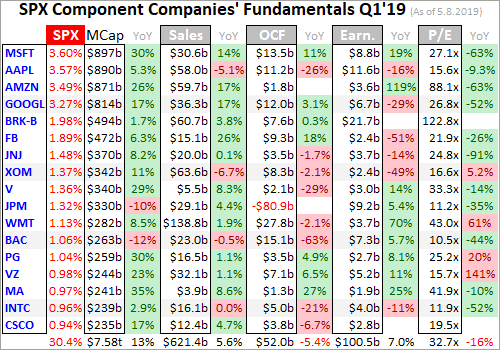
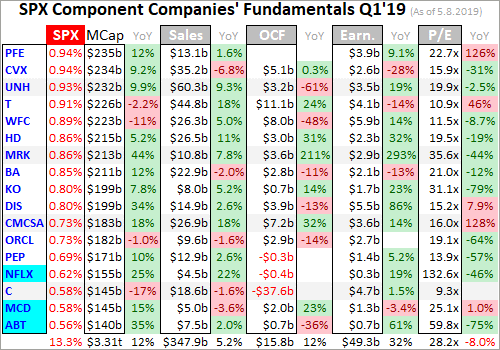
From the ends of Q1’18 to Q1’19, the S&P 500 rallied 7.3% higher. While solid, that’s not much relative to the extreme euphoria and complacency during this latest earnings season. These stock markets could really be in a massive-triple-top scenario after this record bull run, a menacing bearish omen. The SPX initially peaked at 2872.9 in late January 2018, mere weeks after those record corporate tax cuts went into effect.
Then it quickly plunged 10.2% in 0.4 months, a sharp-yet-shallow-and-short correction. But with overall SPX earnings growth exceeding 20% YoY comparing post-tax-cut quarters to pre-tax-cut ones, this key benchmark clawed back higher and hit 2930.8 in late September 2018. That was merely a 2.0% marginal gain over 7.8 months which saw some of the strongest corporate-profits surges ever from already-high levels.
From there the SPX plummeted 19.8% in 3.1 months in that severe near-bear correction largely in Q4. This trend of slightly-better record highs followed by far-worse selloffs is troubling. By late April 2019 the SPX had stretched to 2945.8, jU.S.t 2.5% above its initial peak 15.1 months earlier. Such paltry gains in a span with record corporate tax cuts and resulting torrid earnings growth should really give traders pause.
Technically these three major record highs look like a massive triple top. The big U.S. stocks’ Q1 results are critical to supporting or refuting this bearish technical picture. The SPX/SPY top 34 did enjoy superior market-cap appreciation from the ends of Q1’18 to Q1’19, averaging 12.8% gains which ran 1.7x those of the entire SPX. That exacerbated the concentration of capital in the largest SPX stocks, the mega-cap techs.
As Q1 ended, 5 of the 6 largest SPX stocks were Microsoft, Apple, Amazon, Alphabet, and Facebook. Together they accounted for a staggering 15.8% of this flagship index’s entire market cap, closing in on 1/6th! These companies are universally adored by investors, owned by the vast majority of all funds and constantly extolled in glowing terms in the financial media. Investors think mega-cap techs can do no wrong.
Last summer these incredible businesses were viewed as recession-proof, effectively impregnable. But even if there’s some truth to that, it doesn’t guarantee mega-cap-tech stock prices will weather a stock-market selloff. During that 19.8% SPX correction mostly in Q4, these 5 dominant SPX stocks and another SPX-top-34 tech darling Netflix averaged ugly 33.3% selloffs! They amplified the SPX’s decline by 1.7x.
No matter how amazing the sales growth among the mega-cap techs, they aren’t only not immune to SPX selloffs but their lofty stock prices make them more vulnerable. Overall the SPX/SPY top 34 companies reported Q1’19 revenues of $969.3b, which was 0.9% YoY higher than the top 34’s in Q1’18. That’s not great performance considering how universally-loved and -owned these companies are among nearly all funds.
Those 6 mega-cap tech stocks did far better, enjoying order-of-magnitude-better revenues growth of 9.9% YoY! Excluding them the rest of the SPX top 34 actually saw total sales slump 1.8% lower YoY, which sure doesn’t sound like a strong economy. If this trend of stalling or slowing revenue growth continues, profits growth will have to start falling sharply in future quarters. Earnings ultimately amplify sales trends.
Even more bearish, Wall Street analysts headed into Q1’19’s earnings season expecting all 500 SPX companies to enjoy 4.7% total revenues growth. But the top 34 that dominate the U.S. stock markets did much worse at 0.9% even with mega-cap techs included. That was definitely a sharp slowdown too, as the SPX top 34 saw 4.2% YoY sales growth in Q4’18. Slowing revenue growth is a real threat to the stock markets.
Remember the SPX surged dramatically in Q1, fueling quite-euphoric sentiment leading into quarter-end. At the same time traders mostly believed that a U.S.-China trade deal would soon be signed, removing the trade-war risks. High tariffs are a serious problem for the gigantic multinational companies leading the SPX, potentially heavily impacting sales. Yet revenue growth was already slowing even before this week!
Trump had twice delayed hiking U.S. tariffs on Chinese imports from 10% to 25%, a good-faith sign giving time for real trade-deal negotiations. But his patience ran out this past Sunday after China backtracked on key previoU.S. commitments. So Trump tweeted the current 10% U.S. tariffs on $200b of annual Chinese imports would surge to 25% today, and warned that 25% tariffs were coming “shortly” on another $325b!
China will retaliate as long as high U.S. tariffs remain in effect. That will really retard U.S. sales from top-34 SPX companies in that country. Beloved market-darling Apple is a great example. This second-biggest stock in the S&P 500 did $10.2b or 17.6% of its Q1’19 sales in China! The U.S.-China trade war heating up in a serious way portends even-weaker revenues going forward for the big U.S. stocks dominating the SPX.
The total operating cash flows generated by the top 34 SPX/SPY companies looked like a disaster in Q1, plummeting 64.4% YoY to $67.8b. Thankfully that is heavily skewed by a couple of the major U.S. banks. JPMorgan Chase and Citigroup reported staggering negative OCFs of $80.9b and $37.6b in Q1, due to colossal $123.1b and $30.4b negative changes in trading assets! This seems really confusing to me.
Mega-bank financials are fantastically-complex, and no one can hope to understand them unless deeply immersed in that world. I’ve been a certified public accountant for decades now, spending vast amounts of time buried in 10-Qs and 10-Ks to fuel my stock trading. Yet even with my background and experience I can’t interpret mega-bank results. It seems weird trading assets plummeted in Q1 as the SPX surged sharply.
But rather than getting bogged down in mega-bank arcania that may be impossible to comprehend by outsiders, we can just exclude the four SPX-top-34 mega-banks from our OCF analysis. They include JPMorgan Chase, Bank of America, Wells Fargo, and Citigroup. Without them, the rest of the SPX top 34 reported total OCFs of $163.2b in Q1’19. That was dead-flat ex-banks, up just 0.3% YoY from Q1’18’s OCFs.
So the big U.S. stocks’ operating-cash-flow generation really slowed too in Q1, stalling out compared to hefty 11.5% YoY growth in Q4’18. That’s another sign that the U.S. economy must be slowing despite the red-hot stock markets. That’s ominous and bearish considering the coming headwinds if the trade wars continue and if the stock markets roll over decisively. Future quarters’ business environments won’t be as good.
Earnings were a different story entirely last quarter, soaring dramatically among the SPX/SPY top 34. They totaled $149.8b, surging an enormous 36.1% YoY! But that was skewed way higher by Warren Buffett’s famous Berkshire Hathaway, the biggest SPX stock after the mega-cap techs. BRK reported a monster Q1 profit of $21.7b, compared to a $1.1b loss a year earlier. That accounted for 1/7th of the top 34’s total.
But Berkshire’s epic profits are due to the sharp stock-market rebound rally, not underlying operations. A new accounting rule that Warren Buffett hates and rails against at every opportunity requires unrealized capital gains and losses to be flushed through quarterly profits. Thus when the SPX plunged in Q4’18, BRK reported a colossal $25.4b GAAP loss. That was largely reversed in Q1’19 with its gigantic $21.7b gain.
Excluding the $16.1b of BRK’s Q1 profits that were mark-to-market stock-price gains, the SPX top 34’s total profits grew 21.5% YoY to $133.6b in Q1. That’s still impressive, but it masks some big problems on the corporate-earnings front. Those 6 elite mega-cap tech companies dominating the SPX actually saw their collective Q1 GAAP profits plunge 11.2% YoY! Apple, Alphabet, and Facebook suffered sharp declines.
Usually mega-cap tech stocks are the profits engine driving the entire SPX higher. If these market-darling companies that are universally-loved and -held struggled with earnings growth in Q1, what does that say about profits going forward? And again profits can be manipulated quarter-to-quarter by playing with all kinds of accounting estimates. So if anything corporate profits are overstated instead of understated.
One of Wall Street’s great farces is the game of comparing quarterly results to expectations instead of what they were in the comparable quarter a year earlier. Mighty Apple is a great example, reporting after the close on April 30th. Its Q1 earnings per share and sales of $2.47 and $58.0b came in ahead of Wall Street expectations of $2.37 and $57.5b. So Apple’s stock surged 4.9% the next day on those “great results”.
But that expectations bar had been lowered dramatically, which is the only reason Apple beat. On an absolute year-over-year basis compared to Q1’18, Q1’19 saw sales drop 5.1%, OCFs plummet 26.3%, and earnings plunge 16.4% YoY! That was quite weak, and couldn’t be considered good by any honest measure. In this recent Q1 earnings season, the fake expectations game obscured plenty of real weakness.
Yet overall SPX-top-34 profits growth still remained strong, with companies suffering drops offset by other companies seeing big jumps. But earnings can’t be considered in isolation, they are only relevant relative to underlying stock prices. Imagine you own a rental house and someone offers you $1000 a month to move in. The reasonableness of that earnings stream is totally dependent on the value of your property.
If your house is worth $100k, $1k a month looks great. But if it’s worth $1m, $1k a month is terrible. The profits anything generates are only measurable relative to the capital invested in that asset. The classic trailing-twelve-month price-to-earnings ratios show how expensive stock prices are relative to underlying corporate profits. Big SPX-top-34 earnings growth isn’t bullish if overall profits are low compared to stock prices.
At the end of Q1’19 proper before these Q1 results were reported, the SPX/SPY top 34 component stocks averaged TTM P/Es of 30.4x. That is definitely improving compared to the prior four quarters’ trend of 46.0x, 53.4x, 49.0x, and 39.7x. But 30.4x is still dangerously high absolutely. Over the past century-and-a-quarter or so, fair value for the U.S. stock markets was 14x. Double that at 28x is where bubble territory begins.
So the big U.S. stocks were literally trading at bubble valuations exiting Q1! Their stock prices were far too high relative to their underlying earnings production compared to almost all of U.S. stock-market history. And this wasn’t just a mega-cap-tech-stock thing, with these elite companies often being bid to really-high valuations compared to other sectors. The 6 mega-cap techs we’ve discussed indeed averaged a crazy 52.0x.
But the other 28 top-34-SPX companies remained very expensive near bubble territory even excluding the tech giants, averaging 25.8x! Even the strong Q1’19 earnings growth didn’t help much. At the end of April as those Q1 results started to work into TTM P/E calculations, the SPX top 34 averaged a slightly-higher P/E of 31.0x. Literal bubble valuations with stock markets trading near all-time record highs are ominous.
Just last Friday when the SPX closed right at its highest levels in history, I wrote a contrarian essay on these “Dangerous Stock Markets”. It explained how high valuations kill bull markets, summoning bears that are necessary to maul stock prices sideways to lower long enough for profits to catch up with lofty stock prices. These fearsome beasts are nothing to be trifled with, yet complacent traders mock them.
The SPX’s last couple bears that awoke and ravaged due to high valuations pummeled the SPX 49.1% lower in 2.6 years leading into October 2002, and 56.8% lower over 1.4 years leading into March 2009! Seeing big U.S. stocks’ prices cut in half or worse is common and expected in major bear markets. And there’s a decent chance the current bubble valuations in U.S. stock markets will soon look even more extreme.
Over the past several calendar years, earnings growth among all 500 SPX companies ran 9.3%, 16.2%, and 20.5%. This year even Wall Street analysts expect it to be flat at best. And if corporate revenues actually start shrinking due to mounting trade wars or rolling-over stock markets damaging confidence and spending, profits will amplify that downside. Declining SPX profits will proportionally boost valuations.
If the big U.S. stocks’ fundamentals deteriorate, the overdue bear reckoning after this monster bull is even more certain. Cash is king in bear markets, since its buying power grows. Investors who hold cash during a 50% bear market can double their holdings at the bottom by buying back their stocks at half-price. But cash doesn’t appreciate in value like gold, which actually grows wealth during major stock-market bears.
Gold investment demand surges as stock markets weaken, as we got a taste of in December. While the SPX plunged 9.2%, gold rallied 4.9% as investors flocked back. The gold miners’ stocks which leverage gold’s gains fared even better, with their leading index surging 10.7% higher. The last time a major SPX selloff awakened gold in the first half of 2016, it soared 30% higher fueling a massive 182% gold-stock upleg!
Absolutely essential in bear markets is cultivating excellent contrarian intelligence sources. That’s our specialty at Zeal. After decades studying the markets and trading, we really walk the contrarian walk. We buy low when few others will, so we can later sell high when few others can. While Wall Street will deny this coming stock-market bear all the way down, we will help you both understand it and prosper during it.
We’ve long published acclaimed weekly and monthly newsletters for speculators and investors. They draw on my vast experience, knowledge, wisdom, and ongoing research to explain what’s going on in the markets, why, and how to trade them with specific stocks. As of Q1 we’ve recommended and realized 1089 newsletter stock trades since 2001, averaging annualized realized gains of +15.8%! That’s nearly double the long-term stock-market average. Subscribe today for just $12 per issue!
The bottom line is the big U.S. stocks’ Q1’19 results were pretty mixed despite the surging stock markets. Revenues and operating cash flows only grew slightly, which were sharp slowdowns from big surges in previous quarters. While earnings somehow defied sales to soar dramatically again, that disconnect can’t persist. A slowdown looked to be underway even before the U.S.-China trade war flared much hotter this week.
Even the surging corporate profits weren’t enough to rescue super-expensive stock markets from extreme bubble valuations. They are what spawn major bear markets, which are necessary to maul stock prices long enough for valuations to mean revert lower. Make no mistake, these overvalued stock markets are still an accident waiting to happen. Stock investors should diversify, adding substantial gold allocations.
Adam Hamilton, CPA
May 15, 2019
Copyright 2000 – 2019 Zeal LLC (www.ZealLLC.com)
Several weeks ago we wrote about the downside risk in the gold stocks.
After the various gold stock indices formed distribution-type tops, the subsequent selling has been swift. Miners have plunged through moving averages and short-term breadth indicators quickly reached oversold extremes.
While the gold stocks are oversold, it could be a little while before we can expect a sustained rebound.
We plot GDX below along with the percentage of HUI stocks that closed above the 50-day moving average and 200-day moving average. (The HUI is essentially GDX sans royalty companies).
The breakdown from the rounding top projects down to $19.50 but strong support is unlikely to be found until $17 or the low $18s. Should GDX trade below $19.50 then the percentage of the HUI above the 200-day moving average (currently at 50%) will decrease materially.
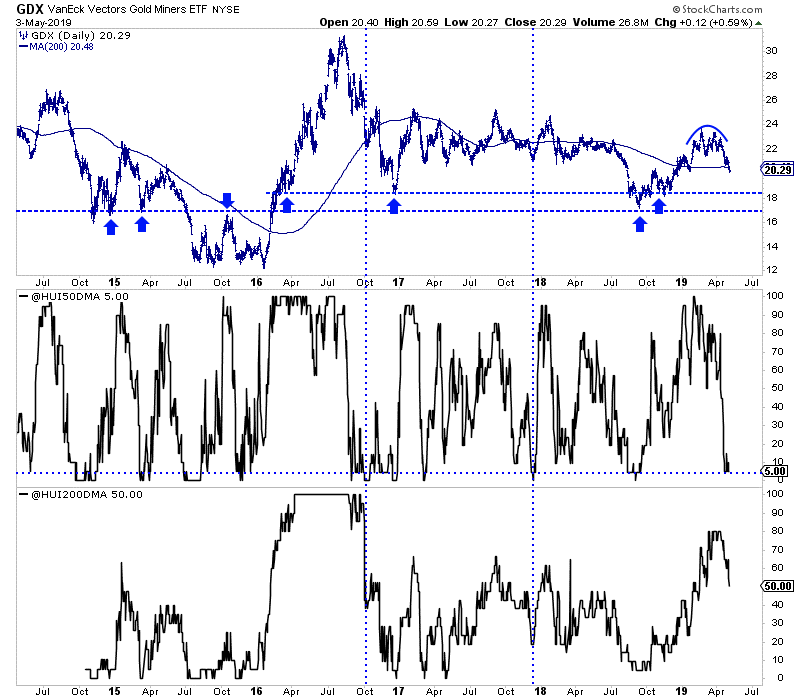
GDXJ, which closed the week at $28.41 has formed a larger distribution top that projects to a measured downside target of $26.50-$27.00. There is a confluence of strong support around $26.00.
Only 33% of GDXJ stocks are trading above the 200-day moving average. GDXJ could be closer to its low than GDX.
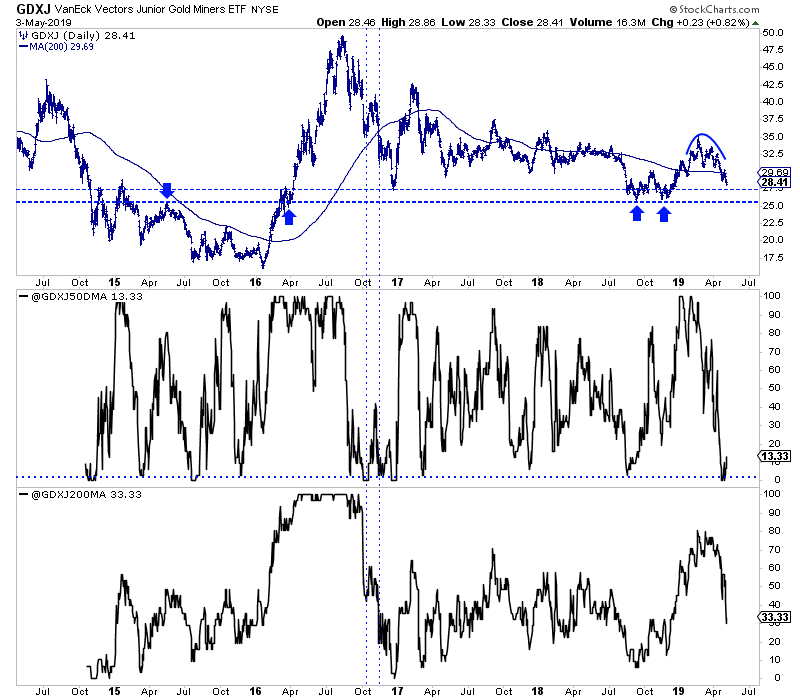
If GDX and GDXJ successfully retest their 2018 lows then their performance in relative terms could inform us on the sustainability of that rebound.
Below we plot Gold, GDX and GDXJ all against the stock market. These charts also have a chance to form double bottoms.
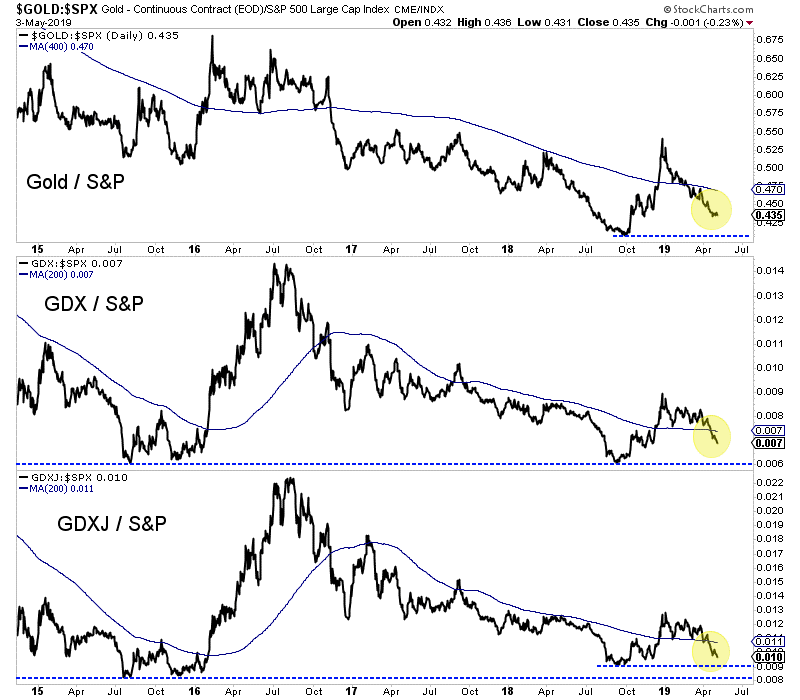
The gold stocks have broken down and have more downside potential until testing strong support levels. We don’t want to fight that breakdown until the market tests strong support amid an extreme oversold condition. That could entail GDX and GDXJ testing their 2018 lows with less than 10%-15% of the stocks trading above their 200-day moving average.
Sentiment indicators for Gold and Silver are trending in the right direction but more selling and lower prices are likely needed before those indicators reach extremes.
As far as fundamentals, there could be some potential bullish developments waiting in the background. If these things come to pass then the gold stocks could be in position to rocket higher after forming a double bottom.
The weeks and months ahead could be an opportune, low risk time to position yourself. We are looking for deep values with catalysts and anything we missed in recent months than can be bought at a discount. To learn what stocks we own and intend to buy that have 3x to 5x potential, consider learning more about our premium service.
By Jordan Roy-Byrne CMT, MFTA
May 7, 2019
As we know, Gold and the US Dollar have an inverse relationship. Gold is priced in US Dollars and the drivers of each are similar (from an inverse point of view). Over long-term periods both trend in the same direction but the magnitude of the moves can vary and be quite different.
The standard inverse relationship has not been a perfect one in recent months or years.
In the chart below we plot Gold, gold stocks and the US Dollar.
We highlight (with vertical lines) the points at which Gold tested the wall of resistance. As you can see, the relationship with the dollar hasn’t been uniform.
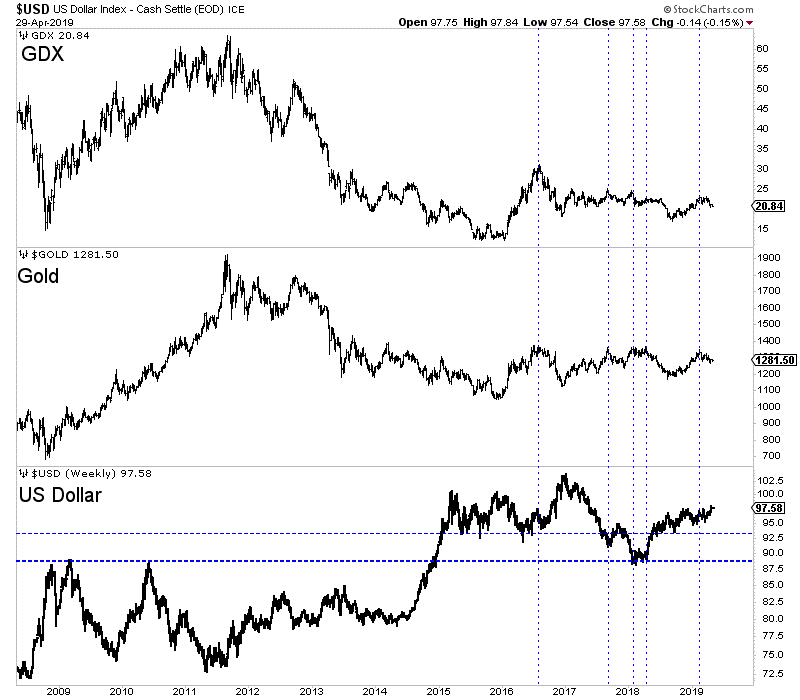
In particular, note what transpired in 2017. The dollar declined sharply and penetrated its 2016 low to the downside yet Gold didn’t make a new high and gold stocks didn’t even come close to their 2016 high.
Recently, the reverse has transpired. The US Dollar has or is breaking out to a new high yet Gold is much closer to its 52-week high rather than its 52-week low.
Gold bulls hope the breakout will reverse course and lead to a big decline. Surely, a big decline would push Gold to a massive breakout. Or would it?
Recall 2017. Gold did not breakout and gold stocks performed even worse. Gold’s fundamentals were not bullish because real interest rates increased throughout 2017. Dollar weakness simply prevented Gold and gold stocks from faring worse.
If the dollar declines again and for similar reasons as in 2017 (global recovery and global risks averted) then we should not expect Gold to breakout. If strength in US stocks and global stocks continues then Gold is not going to breakout regardless of what happens to the US dollar.
If the US Dollar were to continue rising throughout 2019 then it would eventually cause a myriad of problems that would lead to softer policy and Fed rate cuts. Gold may not breakout initially but eventually it would.
The best scenario for Gold would be a dollar decline coupled with a decrease in real interest rates, which would be driven by Fed rate cuts or a consistent rise in inflation as the Fed stands pat.
Keep an eye on the US Dollar over the weeks ahead as its fate could give us a sense of where things are going for the balance of 2019 and then we could assess how Gold may react.
The weeks or months ahead should continue to be an opportune time to position yourself in the Gold sector. We are looking for deep values and anything we missed in recent months that gives us a second chance opportunity. To learn what stocks we own and intend to buy that have 3x to 5x potential, consider learning more about our premium service.
Jordan Roy-Byrne
May 2, 2019
- Gold stocks tend to become extraordinarily volatile during weeks that feature multiple key fear trade events.
- As the month of May begins, gold stocks are faced with a FOMC meeting and the US jobs report.
- Please click here now. Double-click to enlarge this daily gold chart.
- Gold itself is quite stable ahead of these key events, in part because of steady physical market demand for India’s Akha Teej prosperity festival.
- All gold market investors should consider owning at least some physical gold bullion, even if it’s a token amount. A gold bug should view bullion the way a fiat bug views their dollars.
- Gold is money!
- A solid bull wedge is in play on the gold chart and my 14,7,7 Stochastics series oscillator is flashing a buy signal.
- Support is at $1268 and resistance is at $1288. If gold can close above $1290 on Friday after the jobs report… a significant rally is likely to occur.
- Having said that, the current burst of physical market demand is likely temporary because the soft demand season really doesn’t end until August.
- The bottom line is that gold might be making a final low for 2019 in the $1268 area, but the big upside action is unlikely to happen until the strong physical demand season begins later in the summer.
- Please click here now. US stock markets are entering a big resistance zone as the weak month of May begins, and the dollar is beginning to decline against the yen.
- This is gold-supportive.
- The stock market needs strong oil company earnings and Trump just finished a fresh oil price bashing rant. If oil is peaking here, S&P500 earnings are likely to also be peaking.
- Please click here now. The Fed is floating a new scheme to put QE in the hands of commercial banks. This may be partly to accommodate the US government’s voracious appetite for debt and it’s positive for gold.
- It’s unclear exactly how the scheme would work since it’s still in the planning stages, but if this “commercial bank QE” program moves reserves back into the commercial banking system it could help boost loans growth.
- That would boost money velocity and inflation.
- Please click here now. Double-click to enlarge this GDX daily chart.
- While gold is quite stable this week, gold stocks are volatile and struggling. On the positive side, GDX volume has softened since the strong demand season peak in mid-February, Stochastics is oversold, and the price is at trendline and Fibonacci support.
- Please click here now. Double-click to enlarge. On the negative side, there’s a potential bear flag pattern in play.
- It’s not a textbook pattern; the flagpole is not vertical and the flag itself is rough, but gold stocks have an ominous history of staging dramatic sell-offs around and during FOMC meet days.
- Traders may want to reduce size or go to the sidelines because even the best trading systems will produce a lot of whipsaw action at times like this.
- I personally keep trading through these situations because when the trend finally asserts itself, I want to be in for the big move! Also, my trade size is reasonable. Trading accounts should only be one component of an investor’s total precious metals portfolio.
- Please click here now. Double-click to enlarge this weekly CDNX “traffic lights” chart. Junior mining stock enthusiasts need to be patient. It’s likely going to take a sustained gold price of $1370 or higher to generate a long-term buy signal for these miners. They will rally nicely before that happens but it may take until later in the summer to generate the “major league” buy signal that will produce gains of hundreds of percent per share for most of the stocks.
- It’s hard to see the Fed doing anything tomorrow other than holding rates where they are now. A strong jobs report could be viewed as inflationary because the Fed seems reluctant to take on Trump and hike rates. There’s a lot of pension money in the stock market and rate hikes can really hurt that money. A May stock market swoon? Yes. A crash? No. A Friday close above $1290 for gold likely ends the current price correction and that should put gold stock investors in a great state of mind!
Special Offer For Website Readers: Please send me an Email to freereports4@gracelandupdates.com and I’ll send you my free “Prepare For Blast Off!” report. I highlight eight key miners with entry points for gold stock enthusiasts who want to prepare now for the gold price surge above $1290!
Stewart Thomson
Graceland Updates
Email:
Stewart Thomson is a retired Merrill Lynch broker. Stewart writes the Graceland Updates daily between 4am-7am. They are sent out around 8am-9am.
Risks, Disclaimers, Legal
Stewart Thomson is no longer an investment advisor. The information provided by Stewart and Graceland Updates is for general information purposes only. Before taking any action on any investment, it is imperative that you consult with multiple properly licensed, experienced and qualified investment advisors and get numerous opinions before taking any action. Your minimum risk on any investment in the world is: 100% loss of all your money. You may be taking or preparing to take leveraged positions in investments and not know it, exposing yourself to unlimited risks. This is highly concerning if you are an investor in any derivatives products. There is an approx $700 trillion OTC Derivatives Iceberg with a tiny portion written off officially. The bottom line:
Are You Prepared?
Eskay Creek, formerly the world’s highest-grade gold mine, may be headed for a re-start due to very promising exploration work completed by Skeena Resources (TSX.V: SKE).
Eskay Creek was operated by Barrick Gold until shutting down in 2008 due to a combination of high operating costs and a low gold price. Skeena picked up the option to explore the closed mine and has been working diligently on the project for the last two years.
Skeena has proved up a 4-million ounce gold equivalent resource at 4.5 grams/ton (indicated and inferred) open pit. The open pit aspect makes this a tantalizing prospect for investors.
Skeena sees a pathway to making the ultimate total resource larger and bringing the grade closer to 6 grams/ton. Work over the next year will determine the viability of re-opening the mine. Skeena believes Eskay Creek is the best open pit deposit of any junior miner in the world, and the stock price is yet to reflect this.
Jonathan Roth of CEO.ca sat down with Skeena’s CEO Walter Coles, Jr. and Skeena’s VP of Communications Kelly Earle to discuss the company’s discoveries, what the next steps are, and why investors should be paying attention.
Jonathan Roth: What attracted you to Skeena? Because obviously you had a lot of options. Why would you come to Skeena?
Kelly Earle: So, I was initially drawn to the Golden Triangle, the assets they were bringing into the fold, the possibility of acquiring two past producing mines as legendary as Snip and Eskay Creek. So that’s really what drew me in. But then what kept me here was really the team, a really young, keen team that I think is really the future of junior mining in Vancouver.
Jonathan Roth: Why don’t you unpack what you’ve discovered up at Eskay Creek?
Kelly Earle: So, at Eskay Creek, excitingly, we just announced a 4 million-ounce resource combined between indicated and inferred at 4.5 grams/ton open pit. To put that in context, most open pit mines operating today are around the one to two gram/ton mark. And ours is at 4.5 grams/ton and we see a pathway to bring it closer to six grams/ton. So, it’s a world class deposit from a once-legendary mine. Eskay Creek was the highest-grade gold producer in the world when it was in production. It’s very exciting to think that we’ve really just have found what’s left, what the remnants are. But even the remnants are extremely high grade by today’s standards.
Jonathan Roth: Barrick owned Eskay Creek and then they stopped mining at around 2007, 2008, somewhere around there?
Kelly Earle: Yes, 2008.
Jonathan Roth: So why did they stop, given the fact of what you folks have discovered?
Kelly Earle: We get this question a lot. It’s hard for people to understand: if it’s so great, if there’s 4 million ounces left there, why on earth did Barrick walk away? And it’s really just a function of the price of gold and how remote the mine was at the time.
So, when the mine was in operation, it was all diesel powered. So absolutely everything ran on diesel, which for the most part was flown in and flown out. There was road access, but it was still diesel powered. Secondly, the price of gold was significantly lower than it is today. So, the decision to shut the mine down was made in 2005. Price of gold was around $450, $500 an ounce. That meant the cutoff grade – to hit a 20 gram per ton head grade at the mill – they needed a 15 gram per ton cut-off grade, which is crazy by today’s standards.
So, anything below 15 grams per ton was just considered waste. So, if you look at it in the context of the time frame, it made sense that the mine shut down. Also, Barrick was just bringing Placer Dome on board, this was a big several hundred thousand ounce a year producer. The grades were dropping off at Eskay, the production annually was dropping off. It didn’t make sense to keep it open anymore because of how remote it was and the cost of producing it. So, in many ways we’re lucky because we’re left with the remnants that are now extremely high grade by today’s standards and the infrastructure has also improved dramatically since the mine was in production.
Jonathan Roth: The infrastructure obviously must be already there, and my understanding is that things are even easier to get in and out of there than they were say even a decade ago?
Kelly Earle: Within the last year, Highway 37 and the Northwest Transmission Line have been put in, which goes all the way up to Imperial Metals Red Chris Mine. Then within the last 10 years, there have been three hydroelectric facilities built between Snip and Eskay Creek. So, areas that were once all diesel operated for mines, we now have 4 cents a kilowatt hour power – so dramatically changes the opex.
We’ve talked to some engineers who said historically 50% of opex would have been diesel. Now with hydroelectric power, that would be more like 10 to 15%. So, it dramatically changes the cost to put it back into production. And at Eskay, the hydroelectric facility’s only seven kilometers away, down a paved road.
Jonathan Roth: This is Skeena’s CEO, Walter Coles Junior. The son of a very senior former US diplomat working in states that comprised the former Soviet Union, Coles is well versed in navigating the halls of power. Skeena’s projects are located in British Columbia, and Coles has made it a priority to maintain an excellent relationship with BC’s left leaning provincial government and local First Nations groups.
Walter Coles: For us, our experience with the NDP government has been phenomenal. From John Horgan as a premier to Michele Mungall, the mines minister; to her staff, Dave Nikolejsin, who’s a deputy mines minister. I’ll even shout out Peter Robb, who’s the assistant deputy mines minister. When we’ve had problems with delays in permitting, we go to Victoria and things are fixed right away.
Jonathan Roth: There’s been a general perception that the NDP government and British Columbia is not favorable to resource development projects. Obviously, you’ve seen the flip opposite of that?
Walter Coles: I think the facts can speak for themselves. BC has permitted more mines in Canada than any other province in the last three years. That speaks for itself. KSM last year got all their permits. The Red Mountain, IDM’s Red Mountain Mine got all of their permits. Pretium was permitted, I believe, in less than two years. I’m talking about the Brucejack Mine. Red Chris got all of, that’s Imperial Metals, was able to permit the Red Chris Mine. This is all on the Golden Triangle and all within the last three and a half years. In my view, there’s strong political support for mining in this province.
Jonathan Roth: So, what’s the game plan then moving forward?
Walter Coles: Our game plan is to aggressively advance Eskay Creek. The idea is we get the PEA done early in Q3 and we’ll immediately start, I hope, we’ll start pushing towards a feasibility study and we’ll probably start to permit Eskay Creek as well, to be able to put this mine back into production in the next couple years.
Jonathan Roth: So, you know obviously the resource market has been really tough for investors. It’s about as tough as it gets.
Walter Coles: Understatement.
Jonathan Roth: Right. So why, given the general market that’s out there, why should investors give you maybe a second or third look?
Walter Coles: It’s easy. In my mind, it comes down to Eskay and Snip. Snip is our other project, again, a past producing mine. There just aren’t deposits like this around the world. They’re very, very rare and our market cap right now today is about 40 million, 42 million Canadian. And we have 4 million ounces of very high grade, very attractive resource. It’s a combination of gold and silver, but I call it 4.5 million ounces of gold equivalent.
If you look at the valuations of other very well run companies, let’s say a Barkerville or let’s say an Osisko or let’s say an Ascot, as comparables to Skeena, all of those market caps are north of $175 million, and frankly we have more resource than any of those companies. And ours is open pit. The rest of them gotta go underground. So ours is easier mining. I would say adjusted for open pit versus underground, better grade, and we have more. And our market cap is like 15 to 20 percent of what these other companies are valued at. So, we are extremely undervalued right now. So if you’re an investor and you want to have exposure to precious metals, to gold, this is a way you can have leverage and the quality of the assets that we have right now, in my mind, would mean that your risk of losing money is probably a lot less than your risk of making a lot of money. That’s the kind of asymmetric investment opportunities all of us look for.
Jonathan Roth: So, you just mentioned a word there. You said undervalued. Why do you think Skeena’s been so undervalued for so long?
Walter Coles: Yeah, well, I would argue that our success at raising capital from some of the mining focused institutions, like mutual funds and hedge funds around the world, has come back to haunt us because there’s been a trend in the world of pulling capital out of actively managed investment funds and putting that capital into passively managed funds, like ETFs, index funds. So a lot of the mutual funds that we raise money from have faced redemptions over the last 18 months, and even though they told us they liked our project, their investors were pulling money out of their funds, so they were forced sellers of Skeena over the last year and a half. Unfortunately, in my mind, it’s like the worst in the 10 years that I’ve been involved with the sector, it’s the worst I’ve ever seen it. The consequence was we had forced sellers and there’s no bid, no buyers. So that’s taken Skeena down to the level it’s been in for the last six months. But I think we’re through all of that. I think those forced sellers are out and so I think the stock is now at an inflection point where there’s no more sellers. Now the question is: is there any stock available?
Jonathan Roth: What do you have going on now and what do you see happening over the next say six months to a year in terms of your work there?
Kelly Earle: So, we just put out the resource at Eskay that I mentioned, the 4 million ounces, and we’re working hard on metallurgy, because that is a question that we get a lot. Historically, there are a lot of deleterious elements, mercury, arsenic, that were associated. It’s a VMS deposit, volcanogenic massive sulfide deposit. You get extremely high grade, but then you also get some mercury and arsenic, so we’re working on the metallurgy now. We are very confident that it will be clean ore. We’re mining in mostly a different ore type than what was mined historically, but we need the metallurgy out and that report to show the market that it is going to be mineable. So that’s a key milestone that’s coming up for us within the next month.
Then after that, we’re going to be pushing forward on a preliminary economic assessment. So, we’re pretty excited about that. We run the numbers internally and they’re looking good. We’ve hired an engineering firm and we’ve brought an engineer on board to represent Skeena. So, we’re growing and we’re pushing towards that PEA and then while that’s all going on, we will be drilling.
I think people should give Skeena a look because of the amazing quality of Eskay Creek. I mentioned before about when I was part of Hod Maden I didn’t realize it at the time. I think Walter and I and the rest of our team are beginning to realize: this is an amazing deposit that we’re a part of. This is going to be one of the highest-grade open pit mines in North America, if not the world, when it goes back to production. It’s pretty rare that you sit on a brownfield site in a stable jurisdiction, with first nations and government support, 4 million ounces, 4.5 grams open pit. That’s a once-in-a-lifetime project to be a part of and I wholeheartedly believe that Eskay Creek will be back into production.
Walter Coles: We have something very special and it’s hard to find assets like this one. The Eskay Creek deposit is the best open pit deposit that any junior company in the entire world holds right now.
Courtesy: CEO.ca
Disclaimer
All statements in this report, other than statements of historical fact should be considered forward-looking statements. These statements relate to future events or future performance. Forward-looking statements are often, but not always identified by the use of words such as “seek”, “anticipate”, “plan”, “continue”, “estimate”, “expect”, “may”, “will”, “project”, “predict”, “potential”, “targeting”, “intend”, “could”, “might”, “should”, “believe” and similar expressions. Much of this report is comprised of statements of projection. These statements involve known and unknown risks, uncertainties and other factors that may cause actual results or events to differ materially from those anticipated in such forward-looking statements. Risks and uncertainties respecting mineral exploration companies are generally disclosed in the annual financial or other filing documents of those and similar companies as filed with the relevant securities commissions, and should be reviewed by any reader of this video.
Roth Multimedia executive producer Jonathan Roth is an online financial content producer. He is focused on researching and marketing resource and other public companies. Nothing in this video should be construed as a solicitation to buy or sell any securities mentioned anywhere in this video. This article is intended for informational and entertainment purposes only! Be advised Jonathan Roth is not a registered broker-dealer or financial advisor. Before investing in any securities, you should consult with your financial advisor and a registered broker-dealer. In many cases Jonathan Roth owns shares in the companies he features. For those reasons, please be aware that Jonathan Roth can be considered extremely biased in regards to the companies he writes about and features in his videos. Jonathan Roth does not own and never has owned any shares in Skeena Resources. He was paid for production of this video and another to be released at a later date.
Because Jonathan Roth has been paid by Skeena Resources, there is an inherent conflict of interest involved that may influence his perspective on Skeena Resources. This is why you should conduct extensive due diligence as well as seek the advice of your financial advisor and a registered broker-dealer before investing in any securities. Jonathan Roth may purchase shares of Skeena Resources for the purpose of selling them for his own profit and will buy or sell at any time without notice to anyone, including readers/viewers of this video.
Jonathan Roth shall not be liable for any damages, losses, or costs of any kind or type arising out of or in any way connected with the use of this video. You should independently investigate and fully understand all risks before investing. When investing in speculative stocks, it is possible to lose your entire investment.
Any decision to purchase or sell as a result of the opinions expressed in this report will be the full responsibility of the person authorizing such transaction, and should only be made after such person has consulted a registered financial advisor and conducted thorough due diligence. Information in this report has been obtained from sources considered to be reliable, but we do not guarantee that they are accurate or complete. Our views and opinions in this video are our own views and are based on information that we have received, which we assumed to be reliable. We do not guarantee that any of the companies mentioned in this video (specifically Skeena Resources) will perform as we expect, and any comparisons we have made to other companies may not be valid or come into effect.
Jonathan Roth does not undertake any obligation to publicly update or revise any statements made in this video & article.
Gold has failed to gain traction over the past couple months, normally a seasonally-strong time. That has really weighed on sentiment, leaving traders increasingly bearish. Gold investment demand has flagged dramatically with lofty stock markets spewing great euphoria. That’s given gold-futures speculators the run of the market, where they have sold aggressively including extreme shorting. But that’s actually very bullish.
Gold price action is driven by the collective trading of both investors and speculators. The former control vast amounts of capital, which dominates gold prices when it is migrating in or out. But investors’ interest in gold withers when stock markets are super-high. When stocks seemingly do nothing but rally, there’s no perceived need to prudently diversify stock-heavy portfolios with counter-moving gold. It falls out of favor.
Extreme stock-market euphoria is gold’s primary problem now, acting like kryptonite for gold investment. This week the flagship US S&P 500 broad-market stock index clawed back to a new all-time record high. That extended its monster rebound rally since late December’s near-bear lows to 24.8%! The farther the stock markets advance, the more gold is forgotten. Investors have relentlessly pulled capital back out of gold.
The best proxy for gold investment demand is the physical gold-bullion holdings of the world’s dominant gold exchange-traded fund, the American GLD SPDR Gold Shares. In early October soon after the S&P 500 peaked but before it started plunging in its severe 19.8% correction, GLD’s holdings slumped to a deep 2.6-year low of 730.2 metric tons. I explained these stock-market and GLD dynamics in depth last week.
Then the very day the stock markets first dropped hard, investors remembered gold. Over the next 3.8 months into late January, GLD’s holdings surged 12.8% to 823.9t on heavy capital inflows from American stock investors. That helped push gold 8.9% higher in that span. But as euphoria came roaring back as the S&P 500 rebounded sharply from its deep selloff, gold’s relative luster again faded in investors’ eyes.
Between late January and this week, they’ve dumped GLD shares much faster than gold itself was being sold. That has forced GLD’s holdings 9.2% lower in the last 2.8 months to 747.9t, helping push gold’s price down 2.7%. Over 4/5ths of gold’s stock-market-correction-driven investment surge has now been erased, leaving GLD’s holdings just 2.4% above their secular lows of early October before stocks plunged!
The gold-investment selling via GLD in recent months has been relentless, especially in February and now April. During February’s 19 trading days, 13 saw GLD draws averaging 0.4%. And as of the middle of this week, April’s 17 trading days so far have seen 12 GLD-draw days also averaging 0.4%. Gold has faced unyielding selling pressure from American stock investors as the S&P 500 levitated ever higher.
There’s an old proverb stating “when the cat’s away, the mice will play”. That concept perfectly applies to the gold market. When investors are away, the gold-futures speculators will play. Investors’ capital just dwarfs speculators’, so when gold investment demand is robust spec trading is drowned out and usually irrelevant. But when investors aren’t interested, the gold-price impact of gold-futures trading is magnified.
These traders already punch far above their weights, their capital being far more potent than investors’ on a dollar-for-dollar basis. Gold futures allow extreme leverage far beyond anything legal in the stock markets. Each gold-futures contract controls 100 troy ounces of gold, which is worth $127,500 at $1275. But gold-futures speculators are only required to keep $3,400 cash in their accounts for each gold-futures contract.
That gives them absurd maximum leverage up to 37.5x, compared to the decades-old 2.0x limit in stock markets! At 30x leverage, every dollar deployed in gold futures has literally 30x the price impact on gold as another dollar used to buy gold outright. Just $1 of gold-futures capital flows yield the same gold-price result as $30 of investment capital flows. Gold-futures trading’s impact on gold is wildly disproportionate.
Further amplifying gold-futures speculators’ outsized influence, the American gold-futures price is gold’s global reference one. So when heavy gold-futures selling blasts that headline price lower, the resulting negative psychology quickly infects the rest of the world gold markets. Gold-futures trading is effectively the tail that wags the gold-investment dog. This vexing problem shouldn’t be allowed to exist, but it does.
Over the past couple months as mounting stock-market euphoria seduced investment capital out of gold, speculators’ gold-futures selling has soared to extremes at times. That really exacerbated the counter-seasonal downside pressure on gold prices. This heavy selling is evident in the weekly Commitments of Traders reports from the CFTC, which detail speculators’ collective long and short positions in gold futures.
This chart superimposes several years of daily gold prices in blue over the weekly CoT data. Total spec long contracts are shown in greed, and total shorts in red. The falling longs and rising shorts since gold last peaked near $1341 in mid-February are a big reason for its recent weakness. But the lower specs push their longs and the higher they ramp their shorts, the more bullish gold’s near-term outlook grows.
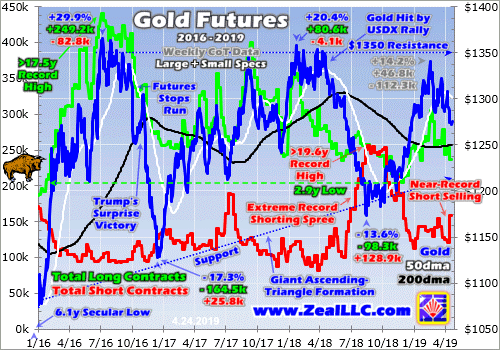
A couple weeks ago I dug deeper into gold futures’ impact on gold prices in recent years, so I’m going to focus on recent months here. On February 19th when gold surged to $1341, total spec longs and shorts were running 305.0k and 138.5k contracts. While those longs remained way below recent years’ peaks, they were still near the highest levels seen in the past year. I developed a simple metric to quantify that.
This chart shows the general rule on gold-futures trading driving gold price action. When speculators are buying by either adding new longs or covering existing shorts, gold rallies. When they are selling existing longs or adding new shorts, gold retreats. So the lower spec longs, and the higher spec shorts, the more bullish gold’s near-term outlook. The opposite is also true, higher longs and lower shorts are bearish for gold.
Gold’s biggest uplegs in recent years emerged from relatively-low spec longs and/or relatively-high spec shorts. Figuring out how low or high both sides of this trade happen to be can be done by looking at current levels compared to their trading ranges over the past year. When gold peaked at $1341 9 weeks ago, total spec longs were running 96% up into their 52-week trading range. That was certainly relatively high.
That left speculators little room to buy more gold-futures long contracts unless they expanded their total capital allocation back to bigger prior-year levels. If they didn’t, they had a lot more room to sell than to buy. That same CoT week, total spec shorts were running 32% up into their own past-year trading range. Thus the short-side guys had probable remaining room to cover 1/3rd of their shorts, which was relatively low.
If investors had been buying gold, if the mounting stock euphoria hadn’t been sucking capital out of gold, speculators’ gold-futures positioning wouldn’t have mattered much. But with investors missing in action, the gold-futures traders were ruling the roost. And they started selling heavily in the CoT week ending on Tuesday March 5th. Be aware that CoT weeks always run from Tuesday closes to Tuesday closes.
Gold began that CoT week looking great, trading at $1328. But speculators started selling gold futures, pushing gold down towards $1300. That is a hugely-important psychological level for gold, which seems to attract gold-futures stop losses like gravity. So as $1300 neared and failed, gold-futures selling ramped up massively. That CoT week ended with specs dumping 34.0k long contracts while adding 11.9k short ones!
A 20k+ contract change in either spec longs or shorts in a single CoT week is the threshold where huge begins. 20k contracts control the equivalent of 62.2 metric tons of gold, way too much for normal markets to absorb in a single week. That big bout of spec gold-futures long selling that kicked off the last couple months’ gold slump was exceptional. At that point 1053 CoT weeks had passed since early 1999, a long span.
That CoT week’s spec long selling ranked as the 20th largest ever witnessed, a rare event. And in terms of speculators’ total gold-futures selling including both longs and shorts, it was the 11th largest on record! It’s important to realize that gold-futures selling of that magnitude is unusual, unsustainable, and self-limiting. The lower spec longs and the higher spec shorts, the less gold futures these traders have left to sell.
That extreme selling blitz puking out the equivalent of 142.6t of gold in a single CoT week would probably have been the end of it without the growing stock-market euphoria. Gold usually carves a major seasonal low in mid-March before powering higher in its spring rally. But with the S&P 500 levitating and investors still selling gold on balance, sentiment stayed fairly bearish so gold-futures specs had the run of the market.
Still gold defied the surging stock markets to rally like usual, climbing back to $1322 by March 25th. The gold-futures speculators were responsible, adding 20.4k new long contracts while covering 15.4k short ones in the CoT week ending a day later. That was the equivalent of 111.3t of gold buying. But over the next CoT week, that reversed into heavy selling. That again surrounded gold plunging back under $1300.
For decades now I’ve intensely studied and closely watched the markets in real-time. I get up at 5am and follow the data and news feeds until 4pm or later. Usually when gold or the stock markets make some big intraday move, it’s explainable by news or data. Neither gold’s 1.7% plunge on March 1st, nor its later 1.4% drop on March 28th, had any apparent catalysts! But both days saw gold break back below $1300.
Running extreme leverage up to 37.5x, gold-futures speculators can’t afford to be wrong for long. A mere 2.7% gold price move against their positions would wipe out 100% of their capital risked at such leverage! So these guys have to maintain an ultra-short-term price-dominated focus, and they have to run tight stop losses or risk quick ruin. Long-side gold-futures traders have long clustered stops near that key $1300 level.
So when gold falls back through $1300 from above, mechanical stop-loss orders start triggering resulting in forced long selling. That quickly pushes gold even lower, tripping more stops to fuel cascading selling. By the time the dust settled in that CoT week ending on April 2nd with gold battered back to $1291, total spec gold-futures longs had plummeted 35.3k contracts! They weren’t short selling then, as shorts fell 2.1k.
That massive long dump was again exceptional, ranking as the 18th largest ever witnessed out of 1057 CoT weeks since early 1999 at that point. Speculators can’t maintain such crazy selling rates for long, as just 7 weeks at that pace would drive their longs to zero which will never happen. For the second time in 4 CoT weeks, extreme spec gold-futures long selling hammered gold from well above $1300 to back below.
But gold soon started recovering even while investors mesmerized by stock euphoria exited. Gold again climbed up over $1300, hitting $1308 on April 10th. This metal really wants to power higher even with investment capital fleeing to chase the lofty stock markets. Yet once again extreme gold-futures selling erupted in the latest CoT week reported before this essay was published, which ended last Tuesday April 16th.
For the third time in 7 weeks, extreme gold-futures selling flared as gold passed back down below $1300. Once again there were no significant data or news catalysts around the world, gold-futures selling just snowballed to a stunning degree. That CoT week total spec longs dropped another 17.5k contracts, close to that 20k+ huge threshold. But total spec shorts exploded an utterly-astounding 36.9k contracts higher!
That single-CoT-week shorting was so crazy it ranked as the 2nd highest ever witnessed out of the 1059 CoT weeks since early 1999! The only bigger shorting week was back in mid-November 2015, soon after the Fed telegraphed its first rate hike of the recent cycle. Yet that record shorting would soon prove very bullish for gold, birthing a major bull market. Gold surged 29.9% higher in 6.7 months in the first half of 2016.
Considered together in that latest reported CoT week ending April 16th, speculators’ total long and short selling rocketed to 54.4k contracts! That is the 5th highest on record, incredibly extreme. The 1st and 4th weighed in at 70.4k and 56.7k, and both occurred in December 2017. That record gold-futures selling also proved very bullish, as gold soon surged sharply to challenge a major bull-market breakout above $1350.
Big gold-futures selling is always bullish for gold, because those bearish bets will soon be unwound with proportional buying. This current episode won’t prove an exception, especially with near-record shorting. While making bullish long-side gold-futures trades is voluntary, short covering is mandatory. Shorting is effectively borrowing gold futures that traders don’t own, those contracts have to be repurchased and paid back.
Between gold’s latest interim high in mid-February to this extreme latest-reported CoT week, total spec longs collapsed 68.5k contracts or 22.5%. That’s a lot in a short span, leaving longs running just 32% up into their past-year trading range. That means specs easily have room to do over 2/3rds of their likely near-term long buying, and much more if higher gold prices excite traders enough to bet at previous years’ scales.
And over the last 8 reported CoT weeks, total spec shorts rose 19.5k contracts. That left them 37% up into their own past-year trading range. That’s not high, but it still leaves a lot more shorts that have to be covered with offsetting buying as gold reverses higher again. Total spec selling since February 19th ran 88.0k contracts, the equivalent of 273.9t of gold. That’s helped force gold 4.8% lower from $1341 to $1276.
The bright side of all this gold-futures selling is it is inherently self-limiting and self-correcting. The more these traders sell, the less they have left to sell. And the higher the odds they will start buying in a big way to mean revert their recent bearish bets back to normal. One of these days some catalyst will arise that will spark major spec gold-futures buying. Gold will surge sharply for weeks as buying normalizes bets.
The biggest casualty of recent months’ extreme near-record gold-futures selling was the gold miners’ stocks, which amplify moves in gold. The major gold miners of the leading GDX VanEck Vectors Gold Miners ETF tend to leverage gold’s action by 2x to 3x. That has weighed on gold-stock prices and psychology since mid-February. GDX slumped while gold-futures speculators battered the gold price lower.
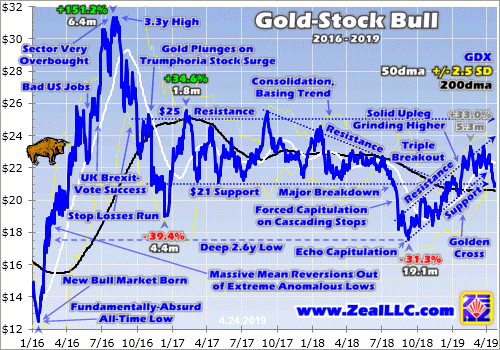
Despite that extreme gold-futures selling nearing records, and incredible stock-market euphoria stunting gold investment demand, the gold stocks have weathered this storm really well. GDX did knife back under its upleg’s support, nearing its 200-day moving average which is much-stronger support. But the major gold stocks have proven impressively resilient overall, largely consolidating high as gold swooned.
Again gold was pounded 4.8% lower over those 8 CoT weeks starting near $1341 and ending way down near $1276. At 2x to 3x normal leverage, the gold stocks would’ve plunged almost 10% to 15%. Yet over that exact span GDX merely slid 5.7%, just 1.2x gold’s loss! And GDX’s leverage was healthy before that as gold rallied, running 2.8x at best by mid-February. The gold stocks have really been holding their own.
Gold stocks are set to surge again once gold reverses decisively higher, which is increasingly likely any day now. These lofty euphoric stock markets are going to inevitably encounter some catalyst sparking significant selling, which will snowball after such a massive and long rally steeped in such epic complacency. Gold investment demand will turn on a dime as stock markets roll over, just like back in early October.
And when gold starts moving higher, the hyper-leveraged gold-futures speculators will rush to buy and pile on to its upside momentum. And after slashing their longs and ramping their shorts over the past couple months, they have major buying to do to reestablish bullish positioning relative to gold to ride its next rally. As leveraged gold-futures capital inflows force gold higher, gold stocks will really amplify its gains.
The last time major gold investment buying lined up with major gold-futures buying by the speculators was in roughly the first half of 2016. That catapulted gold 29.9% higher in 6.7 months kicking off this bull. The major gold stocks as measured by GDX soared 151.2% in essentially that same span, amplifying the big gold gains by 5.1x. Gold stocks are the place to be when traders are pouring capital back into gold!
One of my core missions at Zeal is relentlessly studying the gold-stock world to uncover the stocks with superior fundamentals and upside potential. The trading books in both our popular weekly and monthly newsletters are currently full of these better gold and silver miners. We’ve added plenty of new trades since mid-February as older ones were stopped out, which are ready to surge much higher as gold recovers.
To multiply your capital in the markets, you have to stay informed. Our newsletters are a great way, easy to read and affordable. They draw on my vast experience, knowledge, wisdom, and ongoing research to explain what’s going on in the markets, why, and how to trade them with specific stocks. As of Q1 we’ve recommended and realized 1089 newsletter stock trades since 2001, averaging annualized realized gains of +15.8%! That’s nearly double the long-term stock-market average. Subscribe today for just $12 per issue!
The bottom line is gold has been bludgeoned by extreme gold-futures selling in the past couple months, culminating in near-record shorting. That’s what forced gold lower during its usual spring-rally timeframe. With investors seduced by the lofty euphoric stock markets, gold-futures speculators have been running roughshod over gold prices. But their heavy selling is self-limiting, and will reverse into proportional buying.
Speculators’ big bearish shift in gold-futures positioning will have to be normalized, resulting in big buying that will push gold higher. That upside momentum could really grow, especially when stock markets roll over and again rekindle gold investment demand. The biggest gains as gold mean reverts back higher will come in the stocks of its miners. They’ve proven resilient as gold swooned, and are poised to surge again.
Adam Hamilton, CPA
April 30, 2019
Copyright 2000 – 2019 Zeal LLC (www.ZealLLC.com)
- The weak physical demand season continues to cause gold to drift with a clear but modest downside bias.
- Despite the swoon, most top bank analysts are extremely positive in their outlook for gold in the second half of the year.
- Please click here now. Standard Chartered analyst Suki Cooper notes a high correlation between the Fed’s actions now and in 2006. Gold does respond to a more dovish Fed, but not immediately.
- Suki also predicts U.S. GDP growth will be under 2.5% in 2019, fade to under 2% in 2020, and a downturn will begin in 2021.
- She expects the Fed to remain in pause mode and then announce a rate cut as growth and corporate profits continue to fade.
- The IMF predicts a similar fade in global growth generally, with the exception of China. India is also likely to see strong growth and that will likely be augmented with government handouts related to the election there.
- Essentially, the West will see fading growth. The Fed’s actions will be negative for the dollar and positive for the fear trade for gold. The East will see solid growth and that will be supportive for the love trade for gold.
- The big picture for gold in both the East and the West is positive.
- Please click here now. Double-click to enlarge this GDX chart.
- While the bank analysts are happy to wait out the weak season, I focus on swing trading with my guswinger.com trade alerts service. While many gold investors are a bit gloomy right now, we’ve been “riding the gravy train” with DUST-NYSE throughout most of the latest GDX downturn.
- Recent COT reports show the commercials doing aggressive buying of both gold and silver COMEX contracts. That’s positive but it doesn’t reduce account drawdowns for gold stock investors.
- Ultimately, winning trades are how to reduce drawdowns and commercial traders on the COMEX are currently covering enormous short positions at huge profits.
- Diversification plays a key role in successful investing. A modest allocation of capital to a solid swing trade program should be part of that diversification.
- To view the daily gold chart, please click here now. Double-click to enlarge.
- A potential bull wedge pattern is in play, but until there’s a bigger rally it’s not an actual textbook pattern.
- On a positive note, the blue lag line of my 14,7,7 Stochastics oscillator is almost oversold and “rallies with teeth” tend to occur when that happens.
- Chinese citizens are becoming more positive about their economy and gold demand is perking up. The Akha Teej festival in India is scheduled for May 7 and demand is picking up there too.
- The commercial trader buying on the COMEX could be related to this Chindian love trade but the intensity of the buying could also suggest that commercial traders are also anticipating the U.S. stock market could have a particularly nasty “Sell in May and go away”
- The S&P 500 index is near its highs and oil prices keep climbing. For now, oil is really in a sweet spot where it is high enough to help S&P500 earnings but not too high to hurt consumers.
- That could change quite dramatically, depending on how Iran responds to the U.S. government’s “My way or the highway” announcement to end sanctions waivers on Iranian oil exports.
- Good news for oil company earnings could quickly morph into “stagflationary concern” and this could be on the minds of the COMEX commercial traders who are buying gold and silver extremely aggressively now.
- American “Gmen” enforce these sanctions by threatening to cut nations off from the dollar-oriented US financial system unless they follow their orders. In the big picture, U.S. government “my way or the highwayism” related to Iran is simply going to accelerate the global wave of de-dollarization, which is good news for gold investors.
- Please click here now. Double-click to enlarge this GDX chart. The 50% retracement zone in the $20.50 area and the 60% retracement zone in the $20 area are where gold stock investors should look for a significant rally to begin.
- The bottom line is that physical market demand softness is likely to continue into the summer… but a big relief rally for the entire precious metals sector is imminent!
Special Offer For Website Readers: Please send me an Email to freereports4@gracelandupdates.com and I’ll send you my free “Golden Exceptions To The Rule!” report. I highlight key miners that are blasting higher even with the gold/silver price swoon and I include pinpoint buy and sell trigger points for each stock!
Thanks!!
Cheers
Stewart Thomson
Graceland Updates
Written between 4am-7am. 5-6 issues per week. Emailed at approx 9am daily.
Email:
Graceland Updates daily between 4am-7am. They are sent out around 8am-9am. The newsletter is attractively priced and the format is a unique numbered point form. Giving clarity of each point and saving valuable reading time.
Risks, Disclaimers, Legal
Stewart Thomson is no longer an investment advisor. The information provided by Stewart and Graceland Updates is for general information purposes only. Before taking any action on any investment, it is imperative that you consult with multiple properly licensed, experienced and qualified investment advisors and get numerous opinions before taking any action. Your minimum risk on any investment in the world is: 100% loss of all your money. You may be taking or preparing to take leveraged positions in investments and not know it, exposing yourself to unlimited risks. This is highly concerning if you are an investor in any derivatives products. There is an approx $700 trillion OTC Derivatives Iceberg with a tiny portion written off officially. The bottom line:
Are You Prepared?
The great euphoria emanating from these near-record-high stock markets is breathtaking. Traders are again convinced stocks do nothing but rally indefinitely. That everything-is-awesome mindset has stunted gold’s latest upleg, since there’s no perceived need for prudently diversifying stock-heavy portfolios. But that psychology can change fast, as we saw a half-year ago. Gold investment roars back as stocks roll over.
The word “euphoria” is widely misunderstood, often confused with “mania.” The latter is when stocks rocket vertically in blowoff tops, and is defined as “an excessively intense enthusiasm, interest, or desire”. The US stock markets certainly aren’t in a mania. At its latest high last Friday, the flagship U.S. S&P 500 broad-market stock index (SPX) had only edged up 1.2% over the past 14.5 months. That’s not parabolic.
The closest thing to a mania seen in recent years was the SPX’s 18.4% surge over just 5.3 months that led into its initial January 2018 peak. Traders were ecstatic about Republicans’ coming major corporate tax cuts, and aggressively piled into stocks. While euphoria accompanies manias, it is entirely different. It is simply “a strong feeling of happiness, confidence, or well-being”. That psychology is universal today.
Traders have fully persuaded themselves that these stock markets have virtually no material downside risks. Like all sentiment, that’s the direct result of recent price action. These beliefs were last seen in late September and early October. The SPX had just hit a dazzling all-time record high, extending its monster bull market to 333.2% gains over 9.5 years. That was the second-biggest and first-longest in U.S. history!
Gold was deeply out of favor near that last SPX topping too. As a rare counter-moving asset that tends to rally when stock markets weaken, gold investment demand wanes when stock euphoria grows extreme. The whole discipline of portfolio diversification is based on acknowledging that stock markets rise and fall. Since investors can’t know when the next major stock-market selloff will erupt, they keep some non-stock holdings.
But euphoria blinds traders to long centuries of financial wisdom. They tend to extrapolate present conditions out into infinity, assuming they will last indefinitely. But betting any trend will run forever is just plain foolish, as markets are forever cyclical. “Complacency” always accompanies euphoria, “a feeling of contentment or self-satisfaction, especially when coupled with an unawareness of danger or trouble”.
Soon after traders overwhelmingly believe major selloffs are extinct, the next one pummels them. The endless stock-market cycles reassert themselves with a vengeance, punishing the scoffers. The severe correction after late-September’s peak is a textbook example. Over the next 3.1 months into Christmas Eve, the SPX plunged 19.8%! That was right on the verge of confirming a new bear at its -20% threshold.
Traders were confronted with the painful truth that stock markets don’t rally forever, that major selloffs are inevitable. So gold investment demand surged as investors rushed to start diversifying their bleeding stock-dominated portfolios. Major stock-market plunges are always followed by big and sharp rebound rallies. Just 5 weeks after those deep near-bear lows, the SPX had blasted 15.0% higher by the end of January.
That’s when euphoria and complacency started to return. These perilous herd emotions strengthened with every daily SPX rally over the past several months or so. The higher the stock markets bounced, the more selloff fears faded. That left portfolio diversification and gold investment increasingly out of favor again. The result is today’s extreme euphoria resembles late September’s, traders don’t have a care in the world.
While euphoria and complacency are ethereal and unmeasurable, they can be inferred. The classic VIX fear gauge is the most-popular way. It quantifies the implied volatility options traders expect in the SPX over the next month, as expressed through their collective trades. While a high VIX reveals fear, a low one shows the direct opposite which is complacency. Last Friday the VIX slumped under 12.0 on close.
The SPX’s massive rebound rally had extended to 23.7% over 3.6 months, recovering over 19/20ths of the preceding severe-correction losses. The SPX had soared back to within just 0.8% of its record peak of 6.7 months earlier! The stocks-to-the-moon zeitgeist had returned in an extreme way. The VIX hadn’t been lower since early October, when the SPX still lingered merely 0.2% under its unprecedented crest.
So per the leading approximation, traders’ current euphoria and fear have reverted right back to their very same high and low levels just before the last major SPX selloff! That’s why gold has slumped in recent weeks. Investors forget about it when they come to believe stock markets’ downside risks have vanished. When they buy into that peaking delusion that stocks can rally indefinitely, there’s no perceived need for gold.
This psychology creates an inverse relationship between stock-market levels and gold. It becomes most-pronounced when stock markets are near record highs generating great euphoria. This chart shows how the SPX and gold have traded over the past several years or so. Ever since that mania-like SPX surge into late January 2018 on corporate-tax-cut hopes, gold has generally meandered in opposition to stock markets.
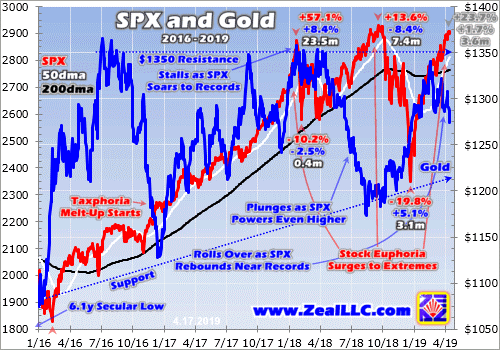
The greater stock-market euphoria, for the most part the weaker gold investment demand and thus gold prices. And of course euphoria is a direct function of how high the stock markets are. The SPX has surged to record and near-record levels 3 times over the past 15 months or so. It peaked at 2872.9 in late January 2018, 2930.8 in late September 2018, and has shot as high as 2907.4 so far in mid-April 2019.
These two confirmed major toppings along with today’s likely third averaged 2903.7, so call it 2900. The SPX is now trading just slightly above January 2018 levels, despite last year being one of the greatest in history for corporate-profits growth. The underlying earnings of the 500 elite SPX companies soared well over 20% in 2018! The SPX should’ve surged proportionally on such strong underlying fundamentals.
But it didn’t, mostly grinding sideways to lower. The U.S. stock markets were already wildly overvalued, spending most of last year trading literally in bubble territory. That’s 28x+ in trailing-twelve-month price-to-earnings-ratio terms, twice historical fair value at 14x. Stocks were already far too expensive to bid to major new highs, a dangerous problem which persists in their latest quarterly results. And 2018 was one-off.
Its four quarters were the only ones comparing pre-tax-cut and post-tax-cut results. That unprecedented discontinuity is the only reason earnings growth was so enormous last year. Profits are expected to stall out this year at best, and likely shrink. All quarterly comparisons going forward already include those big corporate tax cuts. So if the SPX couldn’t materially rally even in 2018, it’s in a world of trouble this year.
In December 2017 just before the corporate tax cuts kicked in, the 500 SPX stocks traded at a simple-average TTM P/E ratio of 30.7x. At the end of March 2019, that had merely retreated modestly to 26.3x which is still just under perilous bubble territory. Without strong double-digit earnings growth, such rich stock valuation levels won’t be sustainable for long. That’s great news for gold’s investment demand and prices.
The first time the SPX topped in January 2018, gold’s powerful upleg stalled just shy of breaking out to new bull-market highs. Gold held those strong levels until the SPX started powering higher again, which quickly rekindled euphoria dousing portfolio diversification. Gold suffered a major correction as the SPX challenged and exceeded new records into September 2018. Gold languished near lows as the SPX peaked.
Gold investment demand didn’t flare again to force gold higher until the SPX decisively rolled over from those all-time record highs. Once the stock markets started falling long enough and far enough to scare traders into remembering stocks can fall too, gold investment demand surged pushing this metal’s prices much higher. Gold was nearing another breakout before stock-market euphoria grew extreme again.
That’s why gold’s latest upleg stalled in recent weeks, why its price has slumped after nearing another major bull-market breakout. Gold has actually shown remarkable resiliency considering stock euphoria soaring right back up to early-October extremes. Last Friday when the VIX fell under 12.0 on close, gold was trading near $1291. That was way better than early October’s $1198 the last time the VIX traded that low.
Stock-market psychology’s primary impact on gold is sentimental. The higher stocks and the greater the herd belief they will keep rallying, the more gold interest and investment demand fade. But there’s also a way to measure capital flows into and out of gold from American stock investors. That is through the gold-bullion holdings of the world’s leading and dominant gold exchange-traded fund, the GLD SPDR Gold Shares.
GLD is a behemoth, holding 752.9 metric tons of physical gold bullion in trust for its shareholders this week. According to the World Gold Council, GLD is the world’s biggest gold ETF by far. At the end of Q4’18 its gold holdings were 2.8x larger than its next-biggest competitor’s. GLD commanded nearly 3/7ths of the total gold bullion held by the world’s top-10-largest physical-gold-backed ETFs, a vast amount!
GLD’s mission is to track the gold price, to give stock traders easy access to gold exposure. This is only possible if GLD can vent excess supply and demand for its shares directly into the global gold market, as the supply and demand for GLD shares is independent of gold’s own. GLD prices can’t mirror gold prices unless this ETF is able to buy and sell physical gold bullion to equalize supply and demand, which it does daily.
It also reports its total gold holdings daily, allowing traders to see whether American stock-market capital is flowing into or out of gold. When GLD’s holdings are rising, investors are buying gold. When they are falling, investors are selling gold. The capital flows into and out of GLD are heavily influenced by stock-market fortunes, stunted when euphoria grows extreme. Gold investment has suffered with the SPX so high.
Understanding how these capital flows work is important. When traders buy GLD shares faster than gold itself is being bought, GLD’s price threatens to decouple from gold to the upside. GLD’s managers avert this by shunting that excess GLD-share demand directly into gold itself. They issue enough new GLD shares to offset that differential demand, and use the proceeds to buy more physical gold bullion to hold in trust.
Conversely when GLD shares are being sold faster than gold, GLD’s price will soon break away from gold on the downside. GLD’s managers stave that off by buying back its shares to sop up that excess supply. The capital necessary to finance those repurchases is obtained by selling some of GLD’s physical-gold-bullion holdings. So rising and falling GLD holdings show stock-market capital migrating into and out of gold.
This chart superimposes GLD’s daily gold holdings in metric tons over the closing gold price. They are well-correlated with gold, showing American stock traders’ GLD trading heavily influences how gold is faring. Each calendar quarter’s gold-price percentage change, and both the percentage and absolute changes in GLD’s holdings, are noted. Over the past year in extreme SPX euphoria, GLD has driven gold.
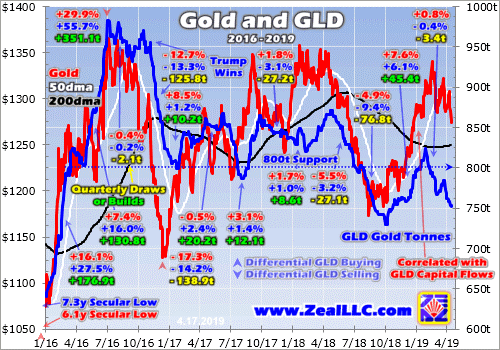
Incredibly GLD’s and thus American stock traders’ huge impact on the gold price is often not understood. Overlooking it is a grave error, greatly hobbling chances of multiplying wealth in gold. To show how dominant GLD is, consider some of the larger quarterly gold moves of this young bull born from deep 6.1-year secular lows in mid-December 2015. GLD’s holdings languished near 7.3-year lows at that same time.
In Q1’16 gold surged 16.1% after the first SPX corrections in 3.6 years made traders remember gold’s crucial role in portfolio diversification. They flooded into GLD shares at dizzying rates, catapulting its holdings 27.5% or 176.9t higher that quarter! Per the latest comprehensive fundamental data from the World Gold Council, GLD’s build accounted for 84% of the year-over-year growth in total global gold demand!
In Q2’16 that massive gold upleg continued, pushing gold another 7.4% higher. GLD’s holdings surged another 16.0% or 130.8t higher on heavy differential buying by American traders. That GLD build alone ran 106% of gold’s total YoY worldwide demand growth! Had U.S. stock-market capital not been flowing into gold via GLD, this gold bull never would’ve existed. Q4’16’s gold plunge drove home that critical point.
After Trump won the presidency that quarter, stock markets surged on hopes for big tax cuts soon with Republicans controlling the U.S. government. Euphoria soared with the SPX, leading investors to jettison gold and chase stocks. Gold plunged 12.7% that quarter, driven by a huge 13.3% or 125.8t draw in GLD’s holdings. That selling was a whopping 112% of the total YoY decline in global gold demand that quarter!
While American stock traders certainly aren’t the only gold investors, they command vast capital that has really moved gold in recent years. Gold’s price behavior in each quarter of this bull has generally been quite proportional with capital flows into and out of GLD. That’s certainly proven true in this past year as well, when SPX euphoria ran rampant other than deep in Q4’18’s severe near-bear correction in the SPX.
After that initial SPX peak in January 2018 and the subsequent sharp-yet-shallow-and-short correction, gold investment demand grew as euphoria wavered. Between mid-January to late April that year, GLD enjoyed a 5.1% holdings build. That wasn’t enough to push gold much higher, it only climbed 0.4%. Differential GLD-share trading isn’t gold’s only driver, gold-futures trading also plays a major role for different reasons.
But as the SPX powered higher out of that initial post-topping selloff, so did investors’ stock euphoria. So they again started to pull capital out of GLD faster than gold was falling, forcing a major holdings draw. Between late April to early October soon after the SPX’s second topping and new all-time record highs, GLD’s holdings plunged 16.2%. That gold-investment exodus pushed gold prices 9.0% lower in that span.
The relentless slump in GLD’s holdings reversed sharply on a very telling day. American stock traders finally started aggressively buying GLD again on October 10th, forcing a major 1.2% daily holdings build. What happened? That was the first day the SPX sold off hard after its recent record high, plunging 3.3% to shatter complacency. That budding sentiment shift was evident in the VIX, which soared 39.7% to 22.6.
The more that serious Q4’18 SPX selloff intensified, the greater gold investment demand grew. This was most evident in December, when the stock markets plunged a brutal 9.2% alone! That pain really helped investors remember the wisdom of having gold allocations in their stock-heavy portfolios. Gold surged 4.9% that month on a 3.4% GLD-holdings build. Gold investment was strong with stock euphoria gone.
Investors’ interest in gold continued well after the SPX started rebounding, as GLD’s holdings peaked in late January 2019 about 5 weeks after the SPX had bottomed. But with the SPX already soaring 15.0% off its lows, euphoria was mushrooming rapidly. Between early October to late January, GLD’s holdings surged 12.8% driving a parallel 9.7% gold rally with stock euphoria not stunting gold investment demand.
Though gold’s latest interim high of $1341 came a couple weeks later in mid-February, American stock traders’ capital outflows from gold were well underway. As the SPX powered ever higher that month, GLD suffered draws on fully 13 of its 19 trading days! That differential GLD-share selling on resurgent stock euphoria continued to this week. Since late January, GLD’s holdings have shrunk another 8.7%.
Though gold has been fairly resilient considering the lofty stock-market levels, it still slid 3.3% in that span. Gold’s upleg was stunted by stock markets’ powerful rebound rally. It rekindled the same levels of extreme euphoria and complacency seen near the SPX’s late-September record peak. With everyone once again convinced stocks can rally indefinitely with no material selloffs, gold investment demand withered.
While wearying for long-suffering contrarian investors, this is actually quite bullish for gold. Back in early October GLD’s holdings slumped to 730.2t in extreme stock-bull-peaking euphoria. Gold fell as low as $1188 as GLD’s holdings bottomed before the SPX started dropping again. Forced way back down to 752.3t this week, GLD’s holdings are only 3.0% above those deep early-October lows. Yet gold was way higher.
At $1276, gold was fully 7.4% above its own early-October low! This is a much-higher base from which to launch its next surge higher, with gold-investment buying potential via GLD shares almost fully reset! When these dangerously-overvalued stock markets inevitably roll over again, American stock traders will again remember prudently diversifying with gold. Their big capital inflows will again drive gold much higher.
That has real potential to fuel a major bull-market breakout for gold above its $1365 bull-to-date peak seen way back in July 2016. This is even more likely because gold-futures speculators aren’t very long as I discussed in last week’s essay. Just like American stock traders, they have lots of room to buy gold aggressively as it resumes marching higher. Gold investment demand only grows as gold prices climb.
Realize gold’s big problem right now is universal stock-market euphoria at extreme stock-bull-peaking levels. But that won’t last, it never does. Once the SPX inescapably starts sliding again in its next material selloff, gold demand will surge back. These lofty overvalued and overbought stock markets near record highs look exhausted. They are likely to turn back south any day, bleeding away euphoria and rekindling gold.
The biggest beneficiaries of gold uplegs are the gold miners’ stocks, which tend to leverage gold’s gains by 2x to 3x. Back in essentially the first half of 2016 when gold surged 29.9% higher in response to back-to-back SPX corrections, the leading GDX and GDXJ gold-stock ETFs soared 151.2% and 202.5% higher in roughly that same span! When gold starts powering higher again, the coming gold-stock gains will be big.
One of my core missions at Zeal is relentlessly studying the gold-stock world to uncover the stocks with superior fundamentals and upside potential. The trading books in both our popular weekly and monthly newsletters are currently full of these better gold and silver miners. Mostly added in recent months as gold stocks recovered from deep lows, our unrealized gains are still running as high as 59% this week!
To multiply your capital in the markets, you have to stay informed. Our newsletters are a great way, easy to read and affordable. They draw on my vast experience, knowledge, wisdom, and ongoing research to explain what’s going on in the markets, why, and how to trade them with specific stocks. As of Q1 we’ve recommended and realized 1089 newsletter stock trades since 2001, averaging annualized realized gains of +15.8%! That’s nearly double the long-term stock-market average. Subscribe today for just $12 per issue!
The bottom line is stock-market euphoria has stunted gold’s upleg. With U.S. stock markets once again back up challenging all-time-record highs, traders have forgotten the hard lessons from late September’s peak. They’ve deluded themselves into believing stocks can rally indefinitely, that near-bubble valuations don’t matter. Thus gold investment demand has withered, which is normal when stock markets are topping.
But once these lofty stock markets inevitably roll over decisively again, gold demand will come roaring back just like in Q4. Investors will remember the wisdom of prudently diversifying their stock-dominated portfolios with counter-moving gold, and start shifting capital back in. That will push gold prices much higher, with real potential for a major bull-market breakout. The gold stocks will amplify those gains like usual.
Adam Hamilton, CPA
April 24, 2019
Copyright 2000 – 2019 Zeal LLC (www.ZealLLC.com)
- Global stock and bond markets continue to be driven by the macros of a possible trade deal, accommodative central banks, weaker earnings, continued stock buybacks, and rising government debt.
- Gold is driven by these same macros, but it has the additional price driver of seasonal Chindian physical market demand.
- It’s currently the soft season for physical demand, but the rest of the price drivers are quite positive. Most big bank analysts have gold price targets of about $1400 for 2019.
- Unfortunately, they don’t see gold reaching their target prices until seasonal physical demand strengthens later in the year.
- Please click here now. Double-click to enlarge this key USD vs yen chart. During the September-December period in 2018, global stock markets tumbled as the Fed put pressure on the stock market with higher rates and QT on “autopilot”.
- Risk-on markets (stocks and the dollar) tumbled, and risk-off markets (yen and gold) soared. Then a dramatic about-face by the Fed in late December sent the dollar and stocks soaring.
- Note that gold continued to rise until mid-February even though stocks and the dollar rallied. That’s because of strong Chinese New Year physical market demand.
- The bottom line: When push comes to shove, it is the physical market that ultimately determines the actions the COMEX commercial traders take and that determines the price trend.
- In 2019, from February to the current time frame, risk-on markets have continued to strengthen, physical market demand continues its seasonal softness, and so gold meanders sideways with a slight downwards bias.
- Please click here now. Double-click to enlarge this chart of DIA-NYSE, a Dow proxy ETF. From a technical perspective, the U.S. stock market has meandered sideways since the U.S. government launched a wave of tariff taxes.
- Then it began crashing when the Fed became more aggressive about rate hikes and QT in the late stage of the current business cycle.
- The market can probably rally to around where it would have been without the “tariff tax tantrum”, but most mainstream analysts don’t see much more than 2% GDP growth over the long term for the U.S. economy.
- It could be said that in America there are a few thousand modestly-socialist politicians and more than 300 million capitalist citizens. Likewise, it could be said in China and India there are a few thousand fully-socialist politicians and 3 billion capitalist citizens.
- Regardless of how they vote, citizens in all three countries generally work hard to make ends meet and to build quality products… while being controlled by debt-worshipping politicians.
- Chindian citizens are in the early stages of their latest empire cycle, and U.S. citizens are in the late stages of their first empire cycle. A gold-orientation of the gargantuan Chindian population essentially guarantees that gold will quickly become a mainstream asset for global investment.
- That’s because there is only about 1% annual growth in mine supply while Chindian citizen wealth is growing at about 6%-8% each year. Gold demand growth mirrors citizen wealth growth.
- In America, the Fed’s accommodative stance can only buy the government limited time. The rate of annual U.S. government debt growth is very similar to Chindian citizen wealth growth.
- On that note, please click here now. Double-click to enlarge. I’m predicting that the gold price drivers of the U.S. government debt behemoth and the Chindian wealth trade are set to collide… in this weekly chart inverse H&S neckline zone at about $1450.
- That should push gold towards the $2000 area neckline zone of an even bigger inverse H&S pattern that targets the $3000 price area.
- Please click here now. Double-click to enlarge this short-term GDX chart. I’ve highlighted my guswinger.com buy and sell signals on the chart. I buy NUGT when there’s a GDX buy signal and buy DUST when there is a GDX sell signal.
- This proprietary system is mechanical and investors are almost always in a trade. The current daily chart price action in GDX is boring at best and can be demoralizing, but for swing traders, almost every day is exciting! The bottom line:
- During the strong season, core positions will make the most money for investors in the gold market. During the weak season (now), a solid short-term trading plan reduces negative emotion, limits drawdowns, and puts money in the bank.
- Please click here now. Double-click to enlarge this daily gold chart. Some investors may be concerned about the fourth touching of the $1288 June futures and $1280 cash market floor, but my question to them is:
- Is this a floor, or is it a sponge? The gold market now is vastly different (both fundamentally and technically) than it was when the price touched the $1523 area for the fourth time in 2013. Investors should think about modest price softness on a $1280 area sponge rather than possible sharp weakness at a $1280 floor. The $1450-$1400 price zone will become a beautiful floor as the gargantuan Chindian wealth trade and U.S. government debt behemoth of doom collide!
Stewart Thomson
Graceland Updates
Email:
Stewart Thomson is a retired Merrill Lynch broker. Stewart writes the Graceland Updates daily between 4am-7am. They are sent out around 8am-9am. The newsletter is attractively priced and the format is a unique numbered point form. Giving clarity of each point and saving valuable reading time.
Risks, Disclaimers, Legal
Stewart Thomson is no longer an investment advisor. The information provided by Stewart and Graceland Updates is for general information purposes only. Before taking any action on any investment, it is imperative that you consult with multiple properly licensed, experienced and qualified investment advisors and get numerous opinions before taking any action. Your minimum risk on any investment in the world is: 100% loss of all your money. You may be taking or preparing to take leveraged positions in investments and not know it, exposing yourself to unlimited risks. This is highly concerning if you are an investor in any derivatives products. There is an approx $700 trillion OTC Derivatives Iceberg with a tiny portion written off officially. The bottom line:
Are You Prepared?
The big picture fundamentals for precious metals have been trending more bullish in recent months as expectations for the Federal Reserve went from a few rate hikes in 2019 to an expectation of a rate cut within the next 12 months. That is aligned with the peak in the 2-year yield and growing concerns over slowing growth globally.
However, that doesn’t preclude a temporary improvement in the economy and markets. China is stimulating again. Global equities have recovered and the S&P 500 is on the cusp of a new high.
All of this means a Fed rate cut in the next 12 months is less likely. Not unlikely but less likely.
Precious Metals have been trading on Fed rate expectations for a while. Higher highs in equities and some stabilization in the economy will chip away at expectations for a rate cut and as a result, some bearish price action is showing up in the precious metals sector.
Below we plot the daily line charts of the gold and silver stocks.
They have formed bearish patterns with the silver stocks (SIL) leading to the downside followed by GDXJ while GDX has held up the best. These charts need to hold their early March low to avoid a break to the downside.
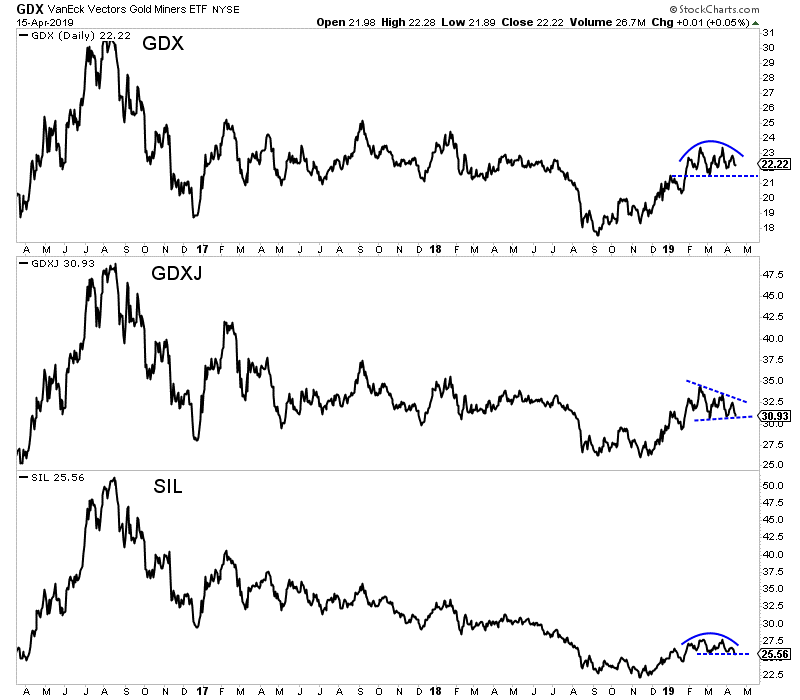
Turning to the metals, we find Silver has been leading the entire complex lower. It has found temporary support just below $15.00.
Meanwhile, Gold has formed a bearish pattern and if it loses support at $1280 will likely dump to its 200-day moving average at $1253 and probably lower.
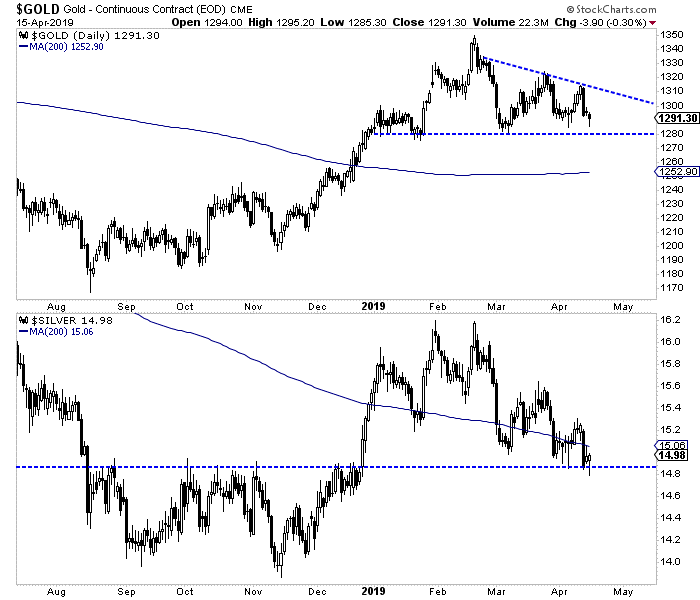
Circling back to the gold stocks, I do want to note the weekly candle charts because they illustrate the big picture prognosis.
We can see that for GDX and GDXJ the critical levels are clearly $23 and $34. The gold stocks have failed to break resistance for now but it’s clear that a weekly close above those levels would signal a bull market.
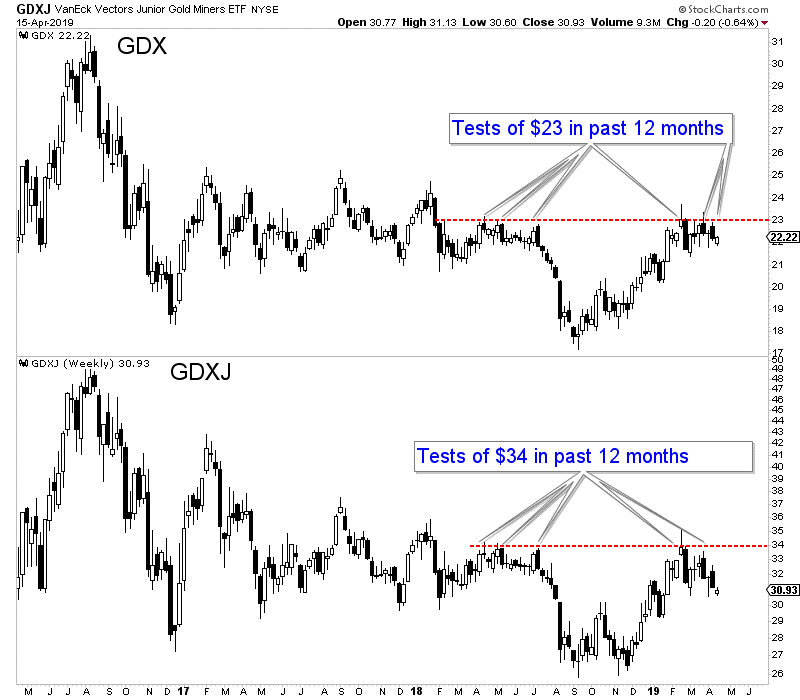
If the miners and Gold break lower then it’s no reason to throw in the towel. We would not be surprised if the next low the miners make could be the last one before a bull run begins.
In the meantime, the question is will it be a higher low or will the miners form huge double bottoms at $18 and $26?
The weeks and months ahead should be an especially opportune time to position yourself in this sector. We will be looking for anything we missed in recent months that gives us a second chance opportunity. To learn what stocks we own and intend to buy that have 3x to 5x potential, consider learning more about our premium service.
There are more than a handful of things I can cite as leading indicators for the Gold price.
Ratios such as Gold against the stock market and Gold against foreign currencies are generally good leading indicators. The gold stocks and Silver can function as leading indicators at times.
The yield curve and bonds can also be leading indicators.
But there is one thing I’ve never mentioned, nor written about. It makes sense in the current context though. That’s Platinum.
Platinum has a brief but clear history as a leading indicator for Gold.
Platinum outperformed and led Gold higher immediately after the two most recent major lows: 1985 and 1999-2001.
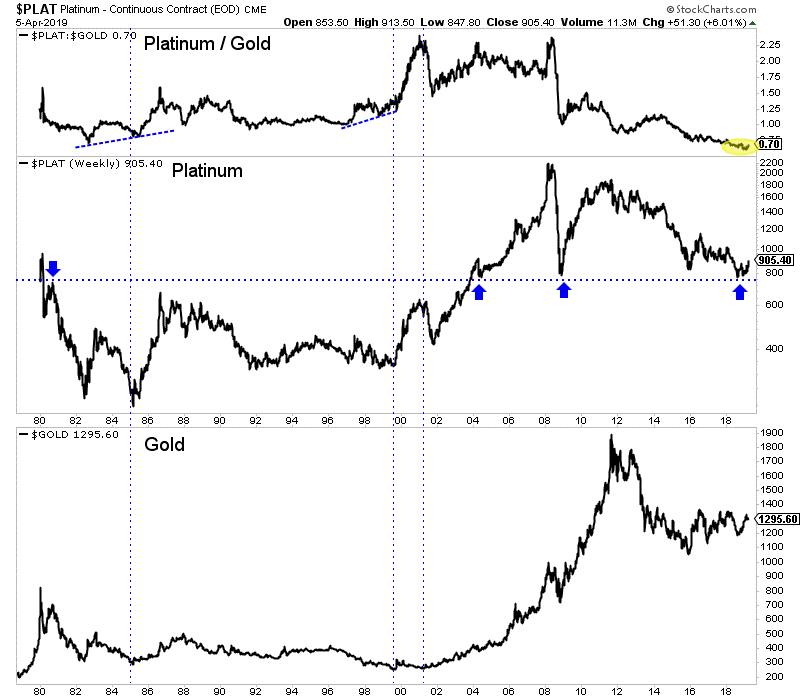
We also want to note the 1966-1968 period when Platinum tripled in price. Silver doubled and Gold of course was still fixed in price. In any event, Platinum’s huge move in the late 1960s was a leading indicator for Gold’s forthcoming surge.
Since the February highs Platinum has made a higher high while Gold has corrected. Platinum looks like it has a reasonable shot to make a new 52-week high this year while Gold would need to fight through the wall of resistance to make a new 52-week high.
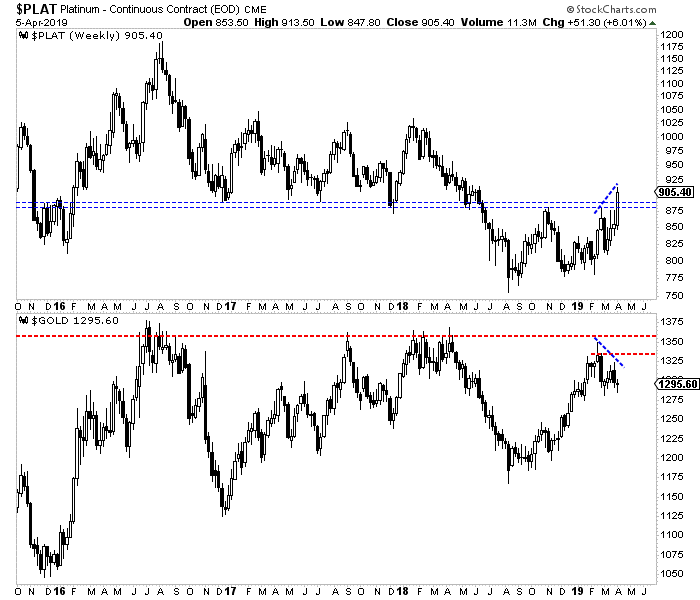
According to BMG Group, a study by Wainright Economics showed that Platinum is the leading indicator of inflation. While Gold and Silver lead by a year, Platinum leads by 16 months.
Whatever the reason, history is clear. Around major bottoms in precious metals, Platinum tends to outperform and lead Gold. Since February Platinum has strongly outperformed Gold while registering an important positive divergence.
We will certainly keep abreast of the other leading indicators such as relative performance of the miners, Fed policy, a steepening yield curve and precious metals performance against the stock market. We will also keep an eye on Platinum as continued outperformance would be a strongly bullish signal for Gold for 2020 and beyond.
The weeks and months ahead should continue to be an especially opportune time to position yourself in this sector. To learn what stocks we are buying and have 3x to 5x potential, consider learning more about our premium service.
April 11, 2019
Jordan Roy-Byrne
- Chinese economic growth is probably the main driver of both physical gold demand and the global bull market in stocks.
- Please click here now. I’m invested in China through ETFs, bank stocks, and… gold!
- With the possible exception of HSBC, most analysts in the West appear to be underestimating the resilience of a billion Chinese citizens working maniacally in the private sector.
- I’ll go even further than HSBC and predict that Chinese GDP growth could re-touch the 7% area if a trade deal is announced.
- Please click here now. Double-click to enlarge. The FXI-NYSE Chinese stock market ETF is breaking out of a powerful inverse H&S bottom pattern. The technical action fits with the growing GDP fundamentals, and key Chinese gold jewellery stocks are racing to fresh highs for the year.
- My guswinger.com leveraged ETF swing trade service focuses on YINN-NYSE for Chinese stock market action. YINN is a triple-leveraged ETF. Its price should soar if even a fraction of the positive Chinese growth scenario laid out by HSBC and myself comes to pass.
- Please click here now. Double-click to enlarge. While gold is doing extremely well so far in the weak demand season, a trade deal and/or a Chinese GDP surge could end this weak season earlier than usual.
- Most big bank analysts see gold at $1400 or higher within 12 months. That $1400 price would turn many gold miners into gargantuan cash cows.
- Mining stock dividends would soar and make global money managers embrace the sector in a much more consistent way than they have in the past.
- Please click here now. If Chinese growth can reach the 7% area, Indian growth should reach 8%. India’s central bank has started its own gold buy program and all the silly government attacks on the Indian gold sector have ended.
- Most gold analysts look for signs of a weakening global economy to propel gold higher. In contrast, I look for signs of strength in the private sector and signs of weakness in the US government sector. Both are present now.
- The U.S. government is a walking tombstone. Its debt cannot be paid. It’s a gargantuan glutton that is clearly out of control. The government and its central bank recklessly smash savers by demanding ultra-low rates and QE. It does so because its own grotesque appetite for borrowed money is insatiable.
- Interestingly, Trump has just nominated gold standard enthusiast Herman Cain as a potential Fed governor. Trump says that Herman “gets it”.
- Does Trump mean Herman understands that only a gold standard can end the insane growth of the U.S. government?
- I think so. The current bottom line for gold is that all Chindian growth lights are green and all U.S. government debt lights are red. This is the perfect environment for creating rallies in the gold price that are sustained.
- Please click here now. Double-click to enlarge. The price action of the TLT-NYSE bond market ETF supports my theme of strength in global stock markets and gold, and weakness in bonds.
- Sometimes gold rallies when interest rates decline and sometimes it rallies when they rise. If there’s enough fear in either scenario, gold will rally strongly.
- Gold soared in 2009 after rates were dramatically lowered with QE and fear of system collapse was rampant.
- Gold soared in 1979 as rates went ballistic and fear of hyperinflation was rampant.
- Libertarians are obviously eager to watch the U.S. government incinerate in a rocketing rates bond market fireball, but I think the coming swoon in bond prices will be more mundane.
- Simply put, the U.S. government debt fireball lies ahead, but in the medium-term gold is likely to rally to $1400 mostly because of the fundamentals of strong Chinese growth.
- Please click here now. Double-click to enlarge this solid-looking GDX chart.
- I’ve been adamant that the weak season sideways action for GDX and associated miners won’t end until there’s a Friday close of $23 or better.
- Will this be the week that it happens? Well, it feels imminent and the good news for investors is that the symmetrical triangle now in play for GDX has an upside price target of about $26!
Special Offer For Website Readers: Please send me an Email to freereports4@gracelandupdates.com and I’ll send you my free “The Golden Surge!” report. I highlight eight key gold and silver miners with similar technical patterns to GDX that can stage much bigger rallies as GDX breaks out to upside!
Stewart Thomson
Graceland Updates
Written between 4am-7am. 5-6 issues per week. Emailed at approx 9am daily.
Email:
Risks, Disclaimers, Legal
Stewart Thomson is no longer an investment advisor. The information provided by Stewart and Graceland Updates is for general information purposes only. Before taking any action on any investment, it is imperative that you consult with multiple properly licensed, experienced and qualified investment advisors and get numerous opinions before taking any action. Your minimum risk on any investment in the world is: 100% loss of all your money. You may be taking or preparing to take leveraged positions in investments and not know it, exposing yourself to unlimited risks. This is highly concerning if you are an investor in any derivatives products. There is an approx $700 trillion OTC Derivatives Iceberg with a tiny portion written off officially. The bottom line:
Are You Prepared?
The gold miners’ stocks are still marching, grinding higher on balance in a solid upleg. While interest in this sector has faded since late February, it is nicely set up for a strong rally. After consolidating high and establishing a sturdy base, the gold miners are likely to soon report greatly-improved first-quarter results. Couple that with gold itself powering higher, and the slumbering gold stocks should surge substantially.
The gold stocks are mired in something of a psychological limbo these days. They aren’t exactly out of favor, but there’s little enthusiasm for this sector. Investors and speculators have largely lost interest for technical, sentimental, and fundamental reasons. It’s been 6 weeks since this gold-stock upleg surged to material new highs. The major gold miners have been mostly grinding sideways since, consolidating and basing.
Contributing heavily to traders’ apathy is gold’s own price action in that recent span. Gold overwhelmingly drives gold-mining profits, making these stocks leveraged plays on gold. Gold’s own latest upleg high of $1341 came back in mid-February right before gold stocks topped. Over the next 12 trading days gold fell 4.1% to $1285 during its usual pre-spring-rally-pullback period. Slumps invariably sap traders’ enthusiasm.
Gold’s seasonal spring rally launched right on schedule after that. By late March this metal had gained back 2/3rds of its pullback losses. The gold stocks surged right back up to challenge their late-February highs on that, but couldn’t break out decisively. Then gold rolled over again during these last couple weeks, revisiting those pre-spring-rally lows. That spooked gold-stock traders, so they sold in sympathy.
Gold’s problem is the great complacency and euphoria spewing forth from the massive rally in the general stock markets. Largely in Q4, the flagship S&P 500 broad-market stock index (SPX) plunged 19.8% from an all-time record peak to deep near-bear lows. But since then it has soared 22.2% higher in what looks like a monster bear-market rally. The SPX has regained an incredible 9/10ths of its severe-correction loss!
Gold is the ultimate portfolio diversifier, tending to rally when stock markets fall. Gold investment demand surges as traders rush to diversify stock-dominated portfolios. December was a key case in point, as gold powered 4.9% higher while the SPX plunged 9.2%. But complacency mushrooms after stock markets rally strongly, and prudent money management is quickly forgotten. So capital inflows into gold wither again.
While sideways-at-best technicals and deteriorating sentiment are the main reasons this gold-stock upleg has stalled, fundamentals played a role too. The major gold miners of the leading gold-stock investment vehicle, the GDX VanEck Vectors Gold Miners ETF, reported their Q4’18 operating and financial results between early February to mid-March. And they proved fairly lackluster due to lower prevailing gold prices.
Yet despite these considerable headwinds, the gold stocks are still marching higher on balance. This chart looks at GDX over the past several years or so. Despite the apathy traders feel, this young gold-stock upleg remains solid. The gold miners’ stocks are still gradually grinding higher in a well-defined uptrend channel. They are well-positioned to surge on any good news, which is likely right around the corner.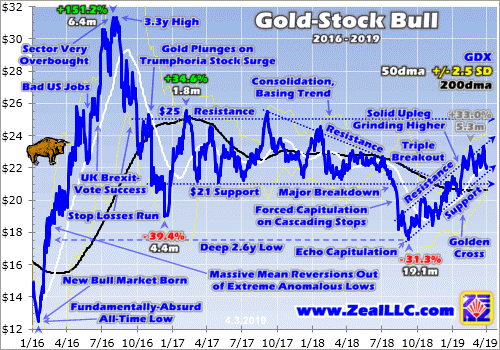
While indifference reigns in this small contrarian sector today, that’s actually a major improvement! Back in early September GDX plunged to a deep 2.6-year secular low. Gold stocks had just been crushed on cascading selling as stop losses were sequentially tripped. That brutal forced capitulation was the direct result of gold getting hammered by all-time-record gold-futures short selling. This sector was loathed then.
Those extreme gold-stock lows weren’t fundamentally righteous, so a big mean-reversion rebound higher was inevitable. That very week in my essay I argued “The technicals and sentiment spawned by capitulations are so extreme they usually birth massive uplegs and entire bull markets.” As contrarians we aggressively bought gold stocks and recommended our newsletter subscribers load up near those lows.
The gold stocks indeed bounced and started recovering, gradually fleshing out the solid uptrend channel in this chart. GDX rallied to cross multiple major technical milestones. A simultaneous triple breakout above three major resistance zones was soon followed by a major Golden Cross buy signal. Triggered by a 50-day moving average climbing back above a 200dma after a major low, these herald big runs higher.
GDX rallied 33.0% over 5.3 months, regaining recent years’ large consolidation trend between $21 support and $25 resistance. At its recent highs of $23.36 on February 20th and $23.35 on March 26th, GDX edged into the upper half of this range for the first time in 12.6 months! The best gold-stock levels in over a year were something to celebrate, technical proof things are changing in this long-neglected sector.
Even better, GDX leveraged gold’s own gains over this upleg-to-date span by 2.8x. That’s strong, on the high side of the usual historical 2x-to-3x range. Gold-stock gains hadn’t outpaced gold’s to such a degree in years, yet again showing this gold-stock upleg is impressive and robust. GDX’s recent high consolidation was just a normal and healthy mid-upleg drift entirely within its uptrend channel, nothing to fear.
Uplegs naturally flow and ebb, surging two steps higher before slumping one step back. This rhythm is essential to keep sentiment balanced, which helps maximize uplegs’ ultimate durations and gains. Once gold stocks blast higher fast enough to rekindle greed, that has to be bled away by subsequent selloffs or drifts. Without these retreats, too much buying too fast burns out uplegs prematurely truncating their potential.
So technically the major gold stocks are looking a lot better today than most traders give them credit for. The consolidating pullback since late February has done its work brilliantly, heavily dampening sentiment while gold-stock prices remain relatively close to upleg highs. Without this critical perspective, it’s not too surprising traders are so indifferent. But enthusiasm can return fast with the right catalyst, and some are coming.
Without any doubt gold stocks will catch a strong bid when gold’s spring rally resumes. In December as gold rallied 4.9% while the stock markets burned, GDX blasted 10.5% higher. In late January gold surged 3.1% higher in a week, fueling GDX soaring 10.7% in that short span! All gold-stock traders really care about is gold, and rightly so. Once gold gets moving again, the gold stocks are going to surge sharply higher.
There are two big catalysts that could start pushing gold considerably higher any day now. Gold-futures speculators drive much of gold’s short-term price action, and closely watch the US dollar’s fortunes for trading cues. The US Dollar Index (USDX) hit a major 20.5-month high in early March, and is likely to roll over soon. The Fed just kneecapped the US dollar by slashing its rate-hike outlook and prematurely killing QT!
Any meaningful dollar selling will drive big gold-futures buying, pushing the yellow metal higher. A good example of this just happened in mid-March. After hitting that major high, the USDX retreated 1.8% over the next couple weeks or so. Gold bottomed the very day the dollar topped, then rallied 2.2% in that span on gold-futures buying. GDX amplified that with a solid 3.9% advance. Gold stocks rally on a weaker dollar.
The US stock markets are way overextended and overvalued, also ready to roll over imminently. This week the monster likely-bear rally in the SPX had carried it back within just 2.0% of late September’s all-time record peak! But such lofty levels aren’t fundamentally-justified. The 500 elite SPX stocks left March trading at average trailing-twelve-month price-to earnings ratios way up at 26.4x, near bubble territory.
And even the Wall Street perma-bulls universally expect SPX earnings growth to be flat at best in 2019. This is a colossal slowdown from 2018’s 20%+ driven by Republicans’ massive corporate tax cuts. Very-expensive valuations aren’t sustainable without surging profits. As the general stock markets start selling off again, investors will resume returning to gold. Their capital inflows will drive its price higher, boosting the miners.
A great proxy for gold investment demand is the physical gold bullion held in trust for shareholders of the world’s largest and dominant gold ETF, the GLD SPDR Gold Shares. Back in early October with the SPX still just under record highs and complacency extreme, GLD’s holdings fell to a deep 2.6-year secular low. They started climbing again the very day the SPX first plunged, as American stock investors remembered gold.
Their big differential-buying pressure on GLD’s shares drove its holdings up 12.8% to 823.9 metric tons by late January. That helped push gold 8.9% higher over that span, which GDX leveraged with a nice 17.8% gain. Gold buying, whether from gold-futures speculators watching a flagging USDX or American stock investors worried about a rolling-over SPX, will push its price higher. That will bring traders back to gold stocks.
Gold’s upleg resuming is the key to reigniting gold stocks’ own upleg. But the major gold miners’ nearing Q1’19 earnings season should provide further fundamental justification for big gold-stock buying. Odds are their results will show big improvements over Q4’18, which should catch investors’ and speculators’ attention and entice them back. The main reason is higher prevailing gold prices really boosting earnings.
Every quarter I dive deeply into the major gold miners’ latest fundamentals. Several weeks ago I looked at the just-reported Q4’18 results from the top 34 GDX components. Those were lackluster, with lower production, higher costs, and lower prevailing gold prices. While gold averaged $1228 per ounce in Q4, the major gold miners’ average all-in sustaining costs rose to $889 per ounce. Profits were the difference at $339.
Q1 is going to look far better, which most gold-stock traders likely haven’t figured out yet given the apathy for this drifting sector. Thanks to the SPX’s severe near-bear correction largely in Q4, resurgent gold investment demand catapulted it a major 6.2% higher quarter-on-quarter to average over $1303 in Q1. The considerably-higher prevailing gold prices should combine with flat-to-lower AISCs to greatly boost earnings.
All-in sustaining costs generally don’t change much regardless of gold’s action. They are largely fixed as mines are being planned. Operating them generally requires similar levels of spending on infrastructure and employees quarter after quarter. Over the past 4 quarters, the GDX-top-34 gold miners’ AISCs have averaged $884, $856, $877, and $889 per ounce. That works out to a tight mean of $877, close to $875.
If the major gold miners produced gold last quarter at $877 per ounce, that implies $426 profits given the $1303 average prevailing gold prices in Q1. That would make for utterly-enormous 25.7% QoQ growth in gold-mining profits! Such massive earnings growth would really catch investors’ attention, especially with general stocks’ profits expected to be flat at best. Gold-stock fundamentals radically improve with higher gold.
And all this is happening during one of gold stocks’ strongest times of the year seasonally, their powerful spring rally. I explained this next chart in depth about a month ago in my latest spring-rally essay, and it’s important to remember. Gold stocks have powered sharply higher on average between mid-March to early June in modern bull-market years. We’re talking 12.2% average gains in the benchmark HUI gold-stock index!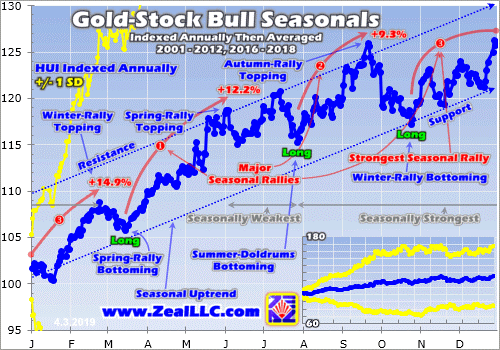
Not only is gold stocks’ spring rally underway, but it’s this sector’s second-strongest seasonal advance of the year. Even if much-stronger fundamentals weren’t likely, even if gold wasn’t due to continue powering higher on a weakening U.S. dollar and rolling-over stock markets, gold stocks tend to rally considerably in the spring. Greatly-improving earnings and stronger gold prices will really amplify this seasonal strength.
Strong seasonals act like tailwinds, boosting gold-stock uplegs fueled by improving technicals, sentiment, and fundamentals. When all these forces align, the gold-stock gains can be enormous. The last major spring rally happened in 2016, part of a monster gold-stock upleg where GDX skyrocketed 151.2% higher in just 6.4 months driven by a parallel strong gold upleg. GDX blasted 37.7% higher in that spring-rally span!
Although traders’ apathetic view on gold stocks in recent weeks is understandable, it isn’t justified at all. This sector has big potential to run much higher in the next couple months, which most traders aren’t yet ready for. The time to get deployed is of course before gold stocks surge higher again, when they can still be bought at relatively-low prices. This consolidation-drift window won’t last long, as gold is due to rally.
While investors and speculators can ride gold stocks’ next move higher in GDX, that is suboptimal. The largest gold miners dominating its weightings are really struggling with depleting production, retarding this entire ETF’s upside potential. Far-better gains will be won in the smaller mid-tier and junior gold miners. Plenty of them have superior fundamentals to the large majors, growing their outputs and driving down costs.
One of my core missions at Zeal is relentlessly studying the gold-stock world to uncover the stocks with superior fundamentals and upside potential. The trading books in both our popular weekly and monthly newsletters are currently full of these better gold and silver miners. Mostly added in recent months as gold stocks recovered from deep lows, our unrealized gains are already running as high as 66% this week!
To multiply your capital in the markets, you have to stay informed. Our newsletters are a great way, easy to read and affordable. They draw on my vast experience, knowledge, wisdom, and ongoing research to explain what’s going on in the markets, why, and how to trade them with specific stocks. As of Q4 we’ve recommended and realized 1076 newsletter stock trades since 2001, averaging annualized realized gains of +16.1%! That’s nearly double the long-term stock-market average. Subscribe today for just $12 per issue!
The bottom line is gold stocks are still marching higher despite the pall of apathy hanging over them. This upleg that excited traders back in February remains intact, with this sector simply pulling back within its uptrend. That has rebalanced sentiment, bleeding away greed. This basing has left gold stocks ready to rally to new upleg highs again, fueled by better gold prices greatly improving gold-mining fundamentals.
Gold-mining earnings are set to surge quarter-on-quarter due to gold’s own upleg powering higher. It too is on the verge of accelerating again as buyers return. A weaker U.S. dollar and rolling-over stock markets will motivate speculators and investors to buy gold again. And naturally the gold miners’ stocks will really leverage those gains like usual. Especially this time of year in the midst of their strong spring-rally season.
Adam Hamilton, CPA
April 9, 2019
Copyright 2000 – 2019 Zeal LLC (www.ZealLLC.com)
- There’s a time for gold stocks to rally… and a time for consolidation and retracement. Please click here now. We have joy, we have fun, we have gold price seasonality in the sun?
- To view seasonality on the daily gold chart, please click here now. Double-click to enlarge.
- The COMEX price of gold is determined mainly by commercial bank traders and hedge funds reacting to physical market supply versus demand. Currently, mine supply is relatively constant, central banks are net buyers, and the scrap market is stable.
- With supply essentially fixed, the seasonal ebb and flow of demand is mainly what moves the price.
- Roughly speaking, physical market demand strengthens from August until February and it weakens from February to August.
- It’s April now, so higher price enthusiasts need patience.
- Events related to the “fear trade” in the West can upset the seasonality apple cart, but a U.S.-China trade deal seems imminent, there is still some time left in the U.S. business cycle’s bull run, and the Fed’s recent actions are likely to reinvigorate stock buybacks.
- Unfortunately, in the short and medium term, there’s not much related to the Western fear trade that would “juice” gold ETF or COMEX contract demand enough to make up for the current seasonal physical market slackness.
- Trump is a business-oriented president, and the private sector in America is quite healthy. He’s supporting that health. In contrast, the government sector (in America and most of the Western world) is a horrifying mess.
- Trump, like his presidential predecessors, has lorded over a massive rise in government spending and debt. Unfortunately for Trump, he just happens to be president when the government’s ability to borrow ever-more money will soon meet a brick wall. Legendary hedge fund manager Ray Dalio believes the government may have only two years of “sand in the hourglass” before the demand for U.S. T-bonds fails to match the supply.
- I’ve suggested the U.S. government could stagger forwards for another 3-4 years before a bond market supernova event occurs. Regardless, the bottom line is that the next financial markets meltdown is set to be a government crisis much more than a private sector crisis. The government’s dollar is like a corporation’s stock, and it will burn as its bond market burns.
- I’ve also predicted that unlike the late 1930s crisis that was followed by U.S. war with Germany, Japan, and Italy, this crisis could cause a war within America, pitting the rich against the poor. It could get quite ugly, especially for citizens with no gold.
- An institutional gold buying frenzy would occur in even the mildest version of this projected scenario. A collapse of the U.S. bond market would smash other Western government bond markets too.
- In a government bond market crisis, all roads lead to gold!
- Also, QE doesn’t work in this type of crisis, because it’s no longer a booster shot for private sector stocks, businesses, and bonds.
- In 2008-2014, QE was mostly deflationary. When it’s used again, it will be used to fill a demand gap for government bonds. In that situation, QE is highly inflationary and could even become “hyperinflationary”.
- Please click here now. Double-click to enlarge this GDX chart. The weak demand season for gold has only been underway since February, so patience is required.
- Regardless, the price action of GDX and its leading component stocks has been impressive. Most of the strong season gains are holding and the price action is essentially sideways now.
- More “bump and grind” trading is expected but the gold mining stocks market is generally very healthy.
- How should investors deal with the weak demand season for gold in regards to GDX and gold stocks in general? Well, for one possible solution, please click here now. Double-click to enlarge this hourly bars swing trades chart for GDX.
- My guswinger.com trade alert service can help investors ease the weak season doldrums. I use triple-leveraged ETFs like NUGT, JNUG, DUST, & JDST… so nobody gets bored! I also take all the trades myself, but only after I send them by cell phone text and email to all the happy subscribers.
- I also recommend items like bitcoin (which is up about 15% this morning), and I’m introducing bond market trades for my main gracelandupdates.com newsletter. That’s partly to get everyone ready for the coming U.S. government bond market supernova explosion. It’s also to help investors understand the more mundane bond market price drivers so they get modestly and consistently richer while waiting for “the big bang”.
- Please click here now. Double-click to enlarge. TLT-NYSE is a bond market ETF. The next signal will be a sell, which means interest rates will rise in the short term. That’s likely because institutional investors see a U.S.-China trade deal as imminent, and so they are moving money from bonds to stocks.
- Because investors are taking more risk now, fear trade demand for gold is softening at a time when love trade demand is seasonally soft. This is just short-term noise. A bond market supernova event lies ahead. During normal times, higher rates are usually mildly negative for gold. During extraordinary times featuring a U.S. government bond market wipeout, rates soar but an institutional buying frenzy means that gold market investors need to prepare for vastly higher prices!
Special Offer For Website Readers: Please send me an Email to freereports4@gracelandupdates.com and I’ll send you my free “Riding The Range!” GDXJ and SILJ report. I highlight how to play the weak season range for these ETFs and for six exciting junior miners!
Stewart Thomson
Graceland Updates
Email:
Stewart Thomson is a retired Merrill Lynch broker. Stewart writes the Graceland Updates daily between 4am-7am. They are sent out around 8am-9am. The newsletter is attractively priced and the format is a unique numbered point form. Giving clarity of each point and saving valuable reading time.
Risks, Disclaimers, Legal
Stewart Thomson is no longer an investment advisor. The information provided by Stewart and Graceland Updates is for general information purposes only. Before taking any action on any investment, it is imperative that you consult with multiple properly licensed, experienced and qualified investment advisors and get numerous opinions before taking any action. Your minimum risk on any investment in the world is: 100% loss of all your money. You may be taking or preparing to take leveraged positions in investments and not know it, exposing yourself to unlimited risks. This is highly concerning if you are an investor in any derivatives products. There is an approx $700 trillion OTC Derivatives Iceberg with a tiny portion written off officially. The bottom line:
Are You Prepared?
Stop me if you’ve heard this before. Precious Metals disappointed again.
The miners were leading the metals but the metals broke down from bear flag patterns and that took the miners lower, suggesting an interim top is in place.
The technicals suggest weakness could be ahead for the sector but the fundamentals are finally turning bullish.
Before we get to fundamentals, let’s look at the technicals. The weekly candle chart of GDX and GDXJ is below.
After last week’s failure to break weekly resistance, GDX now has resistance at $23 and GDXJ has resistance at $34.
The near-term trend is probably lower but if the Fed is going to cut rates later this year, I’d expect the miners to eventually make a higher low which could also look like the right shoulder of an irregular head and shoulders bottoming pattern.
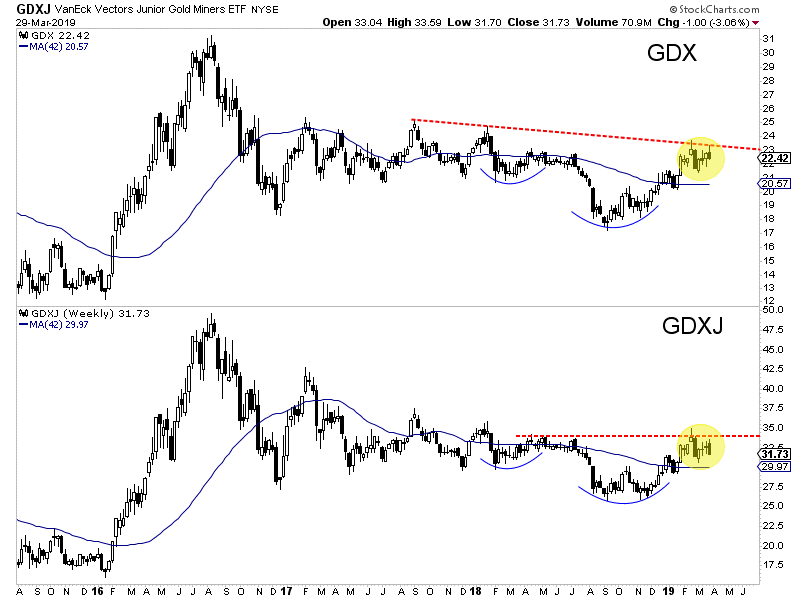
As we noted last week, it wasn’t until after the first rate cut (in the previous two occurrences) that precious metals began to outperform.
The chart below shows the pattern that leads to strong performance in gold stocks. The 2-year yield starts to decline, the Fed pauses, the yield curve steepens, the Fed cuts and then gold stocks perform.
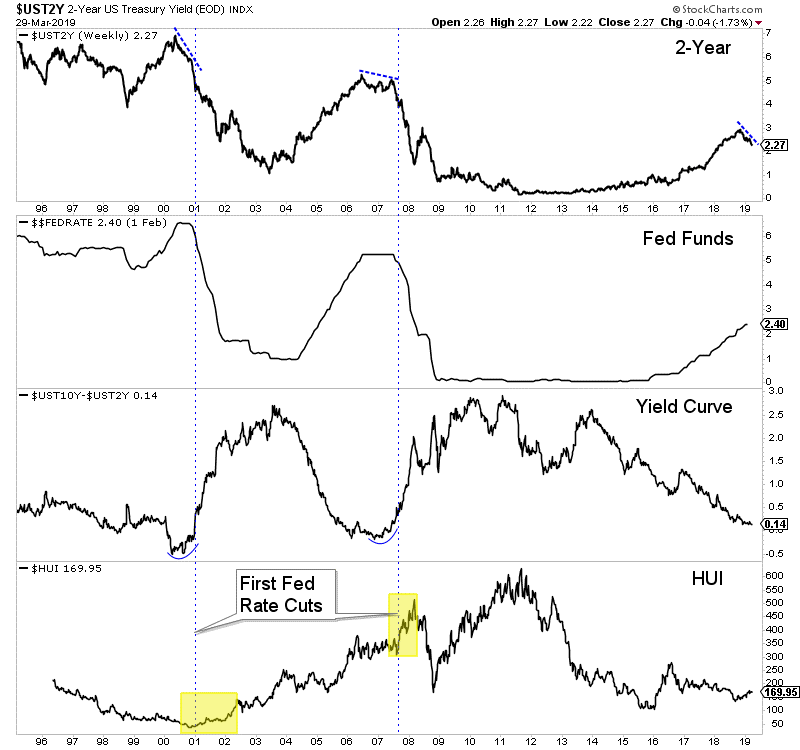
With the current context and history, we can make the case that gold stocks and Gold will not officially move into a bull market until the Fed makes its first rate cut. Fed funds futures are now essentially discounting a rate cut by December and showing nearly a 30% chance of two rate cuts by January 2020.
Bonds are overbought (and yields are oversold) and so these markets could see a counter trend move which would align with weakness in precious metals.
However, precious metals bulls should not be dissuaded by weakness as a rate cut is likely coming within the next 12 months and probably sooner. The weeks and months ahead could prove to be an especially opportune time to position in advance of the first cut and a confirmed new bull market in gold stocks. To learn what stocks we are buying and think have 3x to 5x potential, consider learning more about our premium service.
April 3, 2019
Jordan Roy-Byrne
- Please click here now. Double-click to enlarge this long-term gold chart. Fundamental and technical analysis are both strongly supporting gold’s rally towards the key $1400 area.
- Having said that, COMEX price action mainly reflects action in the physical market and this is the weak season for gold.
- Investors need patience. News in the West that “should” push gold $100/ounce higher is in play, but modest physical market demand in China and India means that rallies are modest.
- Please click here now. If this news was happening during the Chinese New Year Jan-Feb peak physical demand time frame, gold would be staging a “barn burner” rally.
- Instead, it’s contained in a $1280-$1350 consolidation range.
- Please click here now. Double-click to enlarge this daily gold chart.
- The bottom line: Gold is on a journey to the $1400-$1420 price zone, but it’s not a rocket ride. It’s more of what I call a “bull era plod”.
- The other fact to keep in mind is that the inversion of the US yield curve with artificially low rates isn’t suggesting that American economic growth is “cratering”.
- Growth is slowing down, but it’s too early to predict that a recession is imminent. A US-China trade deal could provide some medium-term support for stock markets without being negative for gold.
- Central bank gold accumulation is another positive factor, but it’s currently only about 50-60 tons a month. In the weak season Chindian demand often drops from 200+ tons a month to about 60-80.
- Central bank and Western fear trade demand is decent, but isn’t making up for the shortfall caused by the drop in Chindian demand. That’s being reflected in commercial trader action on the COMEX.
- Gold is rallying strongly from the $1280 zone because Chindian dealers are buyers there. They are fading their buying in the $1310-$1320 area, leaving Western money managers to do the heavy lifting. That’s no easy task with Chindia quiet.
- To put it simply, Western financial news is gold-supportive in content, but until Chindian buying resumes in size gold will be more of a trader’s market than the start of a “huge bull run”.
- The good news is that $1280-$1350 gold is a great price for the miners, and many are surging to one fresh high after another!
- Please click here now. Double-click to enlarge this fabulous GDX chart.
- I’ve suggested that a Friday close of $23 or higher for GDX and $14 for Barrick (GOLD-NYSE) would open the door to a much more significant rally for most gold and silver mining stocks.
- GDX closed above $23 yesterday and Barrick closed above $14. It’s not Friday yet, but this is a very positive sign!
- I don’t expect gold to move above $1350 until Chindian demand begins to strengthen in August… unless there’s a major economic shock in the West.
- Having said that, when it does rise to $1400-$1420, I expect a massive bull run to occur in the miners.
- The logic for this outlook is that most analysts have underestimated the profits that miners will make at $1400+, and global stock markets are likely to swoon again in the Aug-Oct crash season.
- In Sept 2018, gold was in the $1200 range. If it is in the $1400 area in Sept 2019 with stock markets swooning, institutional money managers could engage in a gold stock buying frenzy!
- A September rate cut from the Fed to calm the panic would likely enhance the frenzy.
- Please click here now. Double-click to enlarge this silver stock ETF chart.
- Note the recent rise of the key TRIX indicator above the zero line. That’s the sign of a technically healthy market. A sustained bull run for silver stocks would be signalled by a Friday SIL-NYSE close above $30!
Special Offer For Website Readers: Please send me an Email to freereports4@gracelandupdates.com and I’ll send you my free “Barrick & Agnico Lead The Juniors Higher!” report. I highlight money making tactics for Barrick, Agnico, and key juniors that are joining the upside fun!
Thanks!!
Cheers
Stewart Thomson
Email:
Graceland Updates daily between 4am-7am. They are sent out around 8am-9am. The newsletter is attractively priced and the format is a unique numbered point form. Giving clarity of each point and saving valuable reading time.
Risks, Disclaimers, Legal
Stewart Thomson is no longer an investment advisor. The information provided by Stewart and Graceland Updates is for general information purposes only. Before taking any action on any investment, it is imperative that you consult with multiple properly licensed, experienced and qualified investment advisors and get numerous opinions before taking any action. Your minimum risk on any investment in the world is: 100% loss of all your money. You may be taking or preparing to take leveraged positions in investments and not know it, exposing yourself to unlimited risks. This is highly concerning if you are an investor in any derivatives products. There is an approx $700 trillion OTC Derivatives Iceberg with a tiny portion written off officially. The bottom line:
Are You Prepared?
Since last spring we’ve written over and over again about a Fed rate cut being the catalyst for a bull move in gold stocks.
The history is almost bulletproof. Many lows in gold stocks over the past 60 years coincided with the end of rate hikes.
At present the Federal Reserve is in pause mode and the market is on the cusp of pricing in a rate cut. Friday, Fed funds futures showed a 56% chance of a rate cut by January 2020.
However, precious metals have yet to make new 52-week highs. The gold stocks (GDX & GDXJ) are much closer to doing so than the metals.
Simply waiting for the Fed to cut rates risks missing out on some upside. As market timers, we have to anticipate it.
Is there a leading indicator for the Fed moving from a pause to a cut?
Take a look at the chart below in which we plot data from the last two instances of new rate cut cycles: 2001 and 2007. The vertical lines highlight the Fed’s first cut in those two cycles.
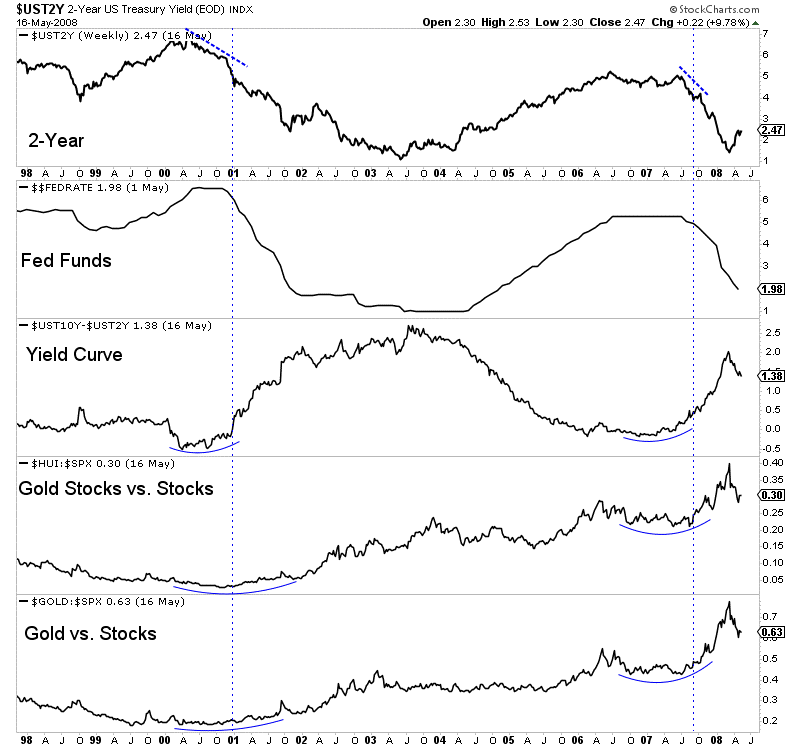
There are several observations to make.
First, Gold and gold stock relative performance accelerated after the rate hikes.
Second, the 10-year and 2-year yield spread began to steepen prior to that outperformance and prior to the rate cuts. And that’s because the 2-year yield, which is a proxy for the Fed funds rate, was trending lower in advance of the first cut.
In short, the sharp decline in the 2-year yield preceded the Fed moving from a pause to a cut. Prior to both the 2001 and 2007 cuts, the 2-year yield had declined by over 1%.
How does this compare to today?
The yield curve has yet to steepen and precious metals have not begun or confirmed outperformance against the stock market.
However, the positive sign for precious metals is the 2-year yield has already declined from nearly 3% down to 2.24% as we pen this.
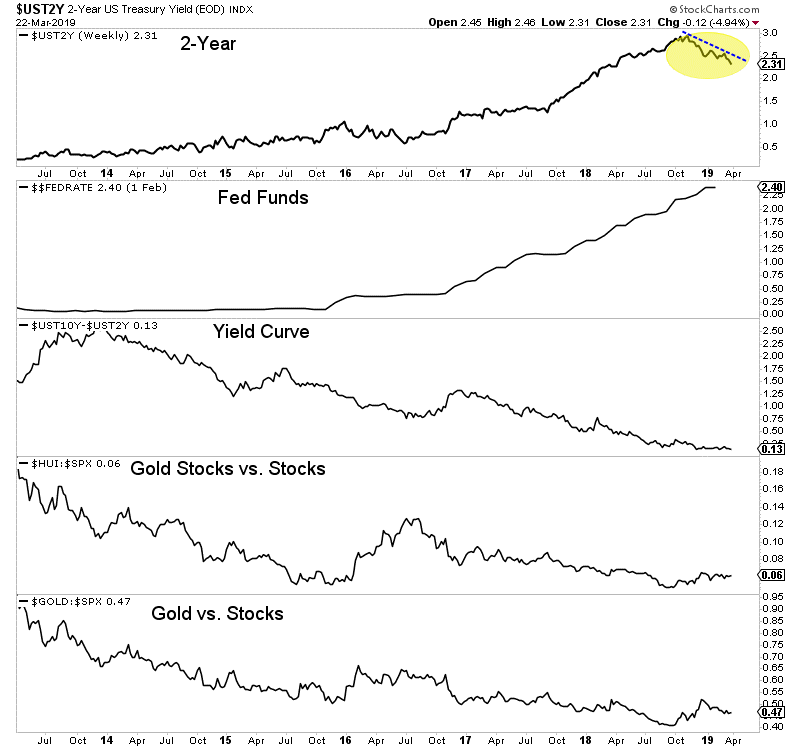
Every cycle is different and each has its own nuances but we cannot ignore the current decline in the 2-year yield. The closer it gets to 2.00%, the more the market will price in a rate cut.
With its decline to 2.24% today (Monday) the market has now priced in a 73% chance of a rate cut by January 2020. Not surprisingly, precious metals are trading higher.
If the 2-year yield continues to decline then precious metals (and gold stocks especially) should build more and more evidence that they are in a new bull market. To learn what stocks we are buying and think have 3x to 5x potential, consider learning more about our premium service.
Here are today’s videos and charts (double-click to enlarge):
SFS Key Charts, Signals, & Video Analysis
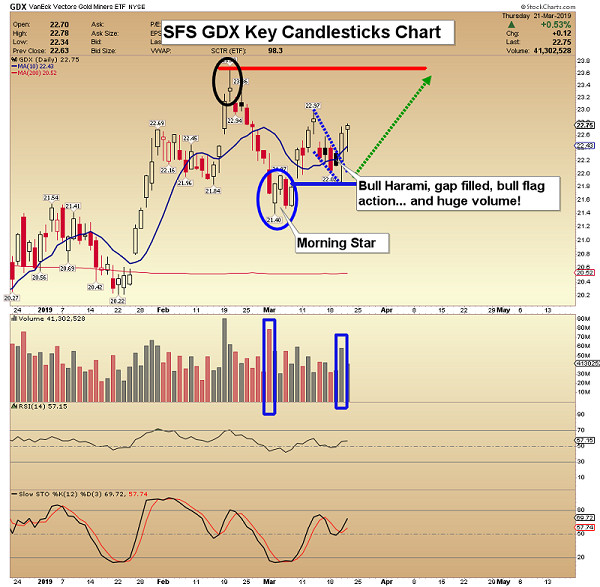
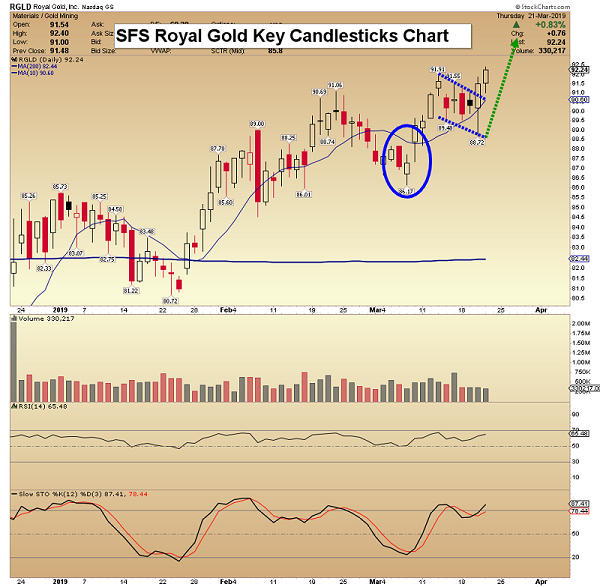
SF60 Key Charts, Signals, & Video Analysis
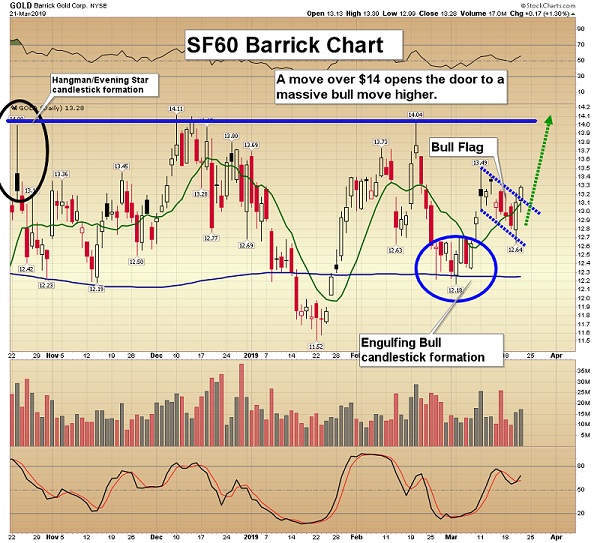
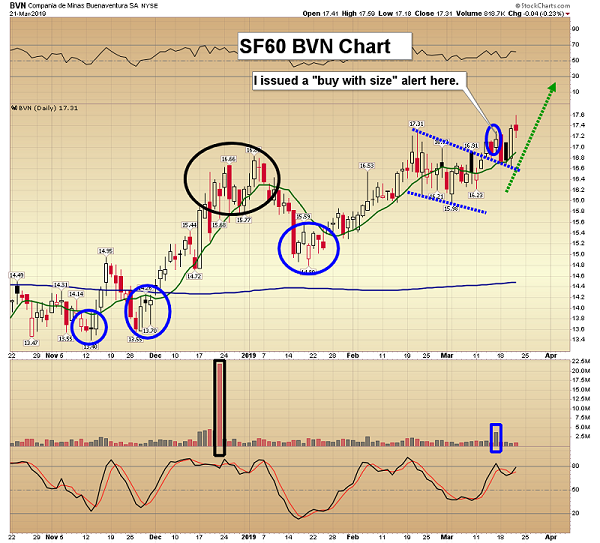
SF Trader Key Charts, Signals, & Video Analysis
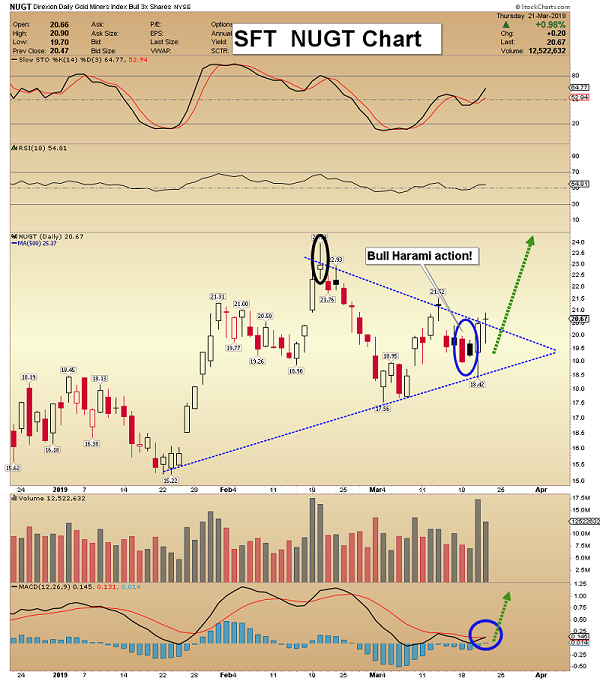
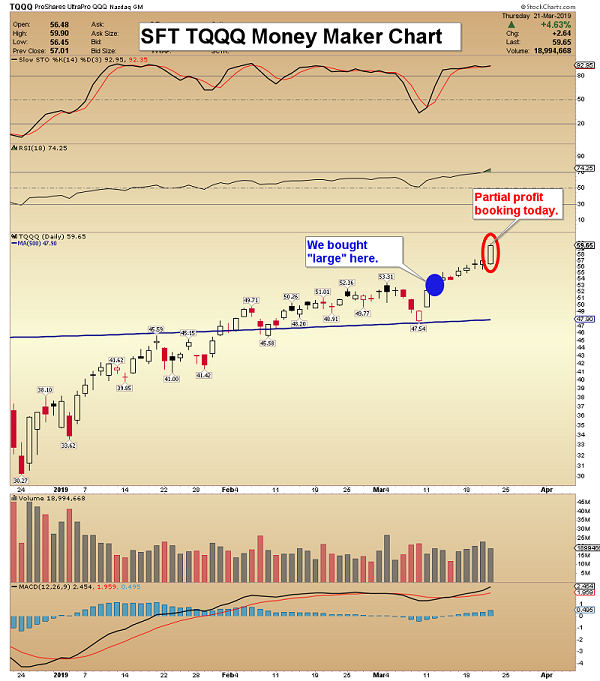
SFJ Key Charts, Signals, & Video Analysis
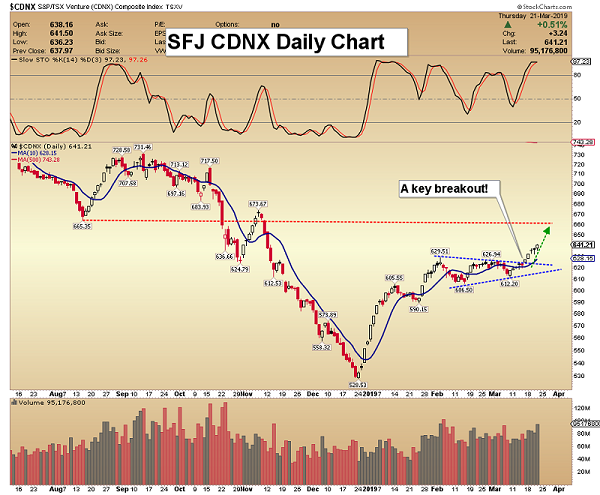
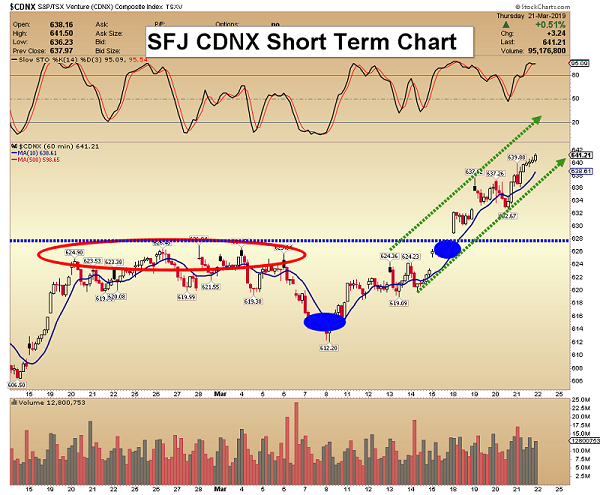
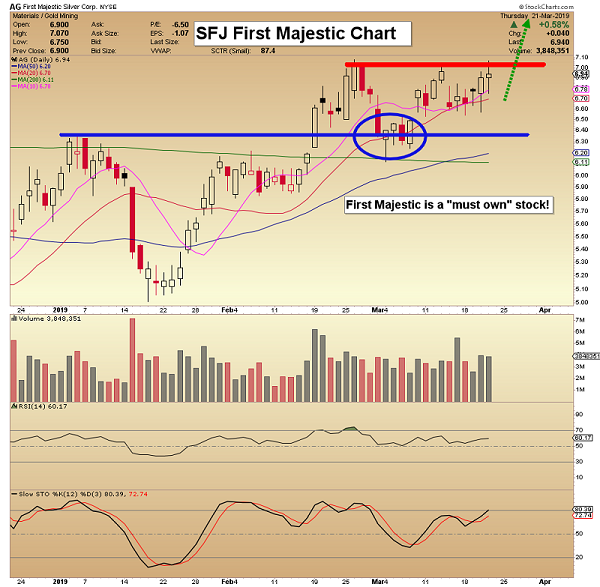
March 26, 2019
Morris Hubbartt
Unique Introduction For Website Readers: Send me an email to signals@superforcesignals.com and I’ll send you my free “Candlesticks Of Thunder!” junior gold stocks video report. I’ll also include 3 of my next Super Force Surge Signals free of charge, as I send them to paid subscribers. Thank you!
Stay alert for our Super Force alerts, sent by email to subscribers, for both the daily charts on Super Force Signals at www.superforcesignals.com and for the 60 minute charts at www.superforce60.com
About Super Force Signals:
Our Super Force signals are created thru our proprietary blend of the highest quality technical analysis and many years of successful business building. We are two business owners with excellent synergy. We understand risk and reward. Our subscribers are generally successful business owners, people like yourself with speculative funds, looking for serious management of your risk and reward in the market.
Frank Johnson: Executive Editor, Macro Risk Manager.
Morris Hubbartt: Chief Market Analyst, Trading Risk Specialist.
Email:
The mid-tier gold miners’ stocks have been rallying on balance in recent months, carving a solid young upleg. They’ve mostly finished reporting their latest fourth-quarter results, revealing how they are faring fundamentally. Their operating and financial performance is very important for investors, as the mid-tier realm is where most of the gold-stock sector’s gains accrue. They fared really well in a challenging quarter.
Four times a year publicly-traded companies release treasure troves of valuable information in the form of quarterly reports. Required by the U.S. Securities and Exchange Commission, these 10-Qs and 10-Ks contain the best fundamental data available to traders. They dispel all the sentiment distortions inevitably surrounding prevailing stock-price levels, revealing corporations’ underlying hard fundamental realities.
While 10-Qs with filing deadlines of 40 days after quarter-ends are required for normal quarters, 10-K annual reports are instead mandated after quarters ending fiscal years. Most gold miners logically run their accounting on calendar years, so they issue 10-Ks after Q4s. Since these annual reports are larger and must be audited by independent CPAs, their filing deadlines are extended to 60 days after quarter-ends.
The global nature of the gold-mining industry complicates efforts to gather this all-important fundamental data. Many mid-tier gold miners trade in Australia, South Africa, Canada, the United Kingdom, and other countries with quite-different reporting requirements. These include half-year reporting rather than quarterly, long 90-day filing deadlines after year-ends, and dissimilar presentations of operating and financial results.
The definitive list of mid-tier gold miners to analyze comes from the GDXJ VanEck Vectors Junior Gold Miners ETF. Despite its misleading name, GDXJ is largely dominated by mid-tier gold miners and not juniors. GDXJ is the world’s second-largest gold-stock ETF, with $4.1b of net assets this week. That is only behind its big-brother GDX VanEck Vectors Gold Miners ETF that includes the major gold miners.
Major gold miners are those that produce over 1m ounces of gold annually. The mid-tier gold miners are smaller, producing between 300k to 1m ounces each year. Below 300k is the junior realm. Translated into quarterly terms, majors mine 250k+ ounces, mid-tiers 75k to 250k, and juniors less than 75k. GDXJ was originally launched as a real junior-gold-stock ETF as its name implies, but it was forced to change its mission.
Gold stocks soared in price and popularity in the first half of 2016, ignited by a new bull market in gold. The metal itself awoke from deep secular lows and surged 29.9% higher in just 6.7 months. GDXJ and GDX skyrocketed 202.5% and 151.2% higher in roughly that same span, greatly leveraging gold’s gains. As capital flooded into GDXJ to own junior gold stocks, this ETF risked running afoul of Canadian securities laws.
Canada is the center of the junior-gold universe, where most juniors trade. Once any investor including an ETF buys up a 20%+ stake in a Canadian stock, it is legally deemed a takeover offer. This may have been relevant to a single corporate buyer amassing 20%+, but GDXJ’s legions of investors certainly weren’t trying to take over small gold miners. GDXJ diversified away from juniors to comply with that archaic rule.
Smaller juniors by market capitalization were abandoned entirely, cutting them off from the sizable flows of ETF capital. Larger juniors were kept, but with their weightings within GDXJ greatly demoted. Most of its ranks were filled with mid-tier gold miners, as well as a handful of smaller majors. That was frustrating, but ultimately beneficial. Mid-tier gold miners are in the sweet spot for stock-price-appreciation potential!
Major gold miners are increasingly struggling with declining production, they can’t find or buy enough new gold to offset their depletion. And the stock-price inertia from their large market capitalizations is hard to overcome. The mid-tiers can and are boosting their gold output, fueling big growth in operating cash flows and profitability. With much-lower market caps, capital inflows drive their stock prices higher much faster.
Every quarter I dive into the latest results from the top 34 GDXJ components. That’s simply an arbitrary number that fits neatly into the tables below, but a commanding sample. These companies represented 82.1% of GDXJ’s total weighting this week, even though it contained a whopping 71 stocks! 6 of the top 34 were majors mining 250k+ ounces, 17 mid-tiers at 75k to 250k, 8 “juniors” under 75k, and 3 explorers with zero.
These majors accounted for 19.8% of GDXJ’s total weighting, and really have no place in a “Junior Gold Miners ETF” when they could instead be exclusively in GDX. These mid-tiers weighed in at 44.3% of GDXJ. The “juniors” among the top 34 represented just 14.8% of GDXJ’s total. But only 4 of them at a mere 6.1% of GDXJ are true junior golds, meaning they derive over half their revenues from actually mining gold.
The rest are primary silver miners, gold-royalty companies, and gold streamers. GDXJ is overwhelmingly a mid-tier gold miners ETF, with sizable small-major exposure. Investors and speculators need to realize it is not a junior-gold investment vehicle as advertised. GDXJ also has major overlap with GDX. Fully 28 of these top 34 GDXJ gold miners are included in GDX too, with 23 of them also among GDX’s top 34 stocks.
The GDXJ top 34 accounting for 82.1% of its total weighting also represent 36.6% of GDX’s own total weighting! The GDXJ top 34 clustered between the 11th- to 40th-highest weightings in GDX. Thus over 4/5ths of GDXJ is made up by almost 3/8ths of GDX. But GDXJ is far superior, excluding the large gold majors struggling with production growth. GDXJ gives much-higher weightings to better mid-tier miners.
The average Q4’18 gold production among GDXJ’s top 34 was 164k ounces, just over half as big as the GDX top 34’s 302k average. Despite these two ETFs’ extensive common holdings, GDXJ is increasingly outperforming GDX. GDXJ holds many of the world’s best mid-tier gold miners with big upside potential as gold’s own bull gradually powers higher. Thus it is important to analyze GDXJ miners’ latest results.
So after every quarterly earnings season I wade through all available operational and financial results and dump key data into a big spreadsheet for analysis. Some highlights make it into these tables. Any blank fields mean a company hadn’t reported that data as of this Wednesday. The first couple columns show each GDXJ component’s symbol and weighting within this ETF as of this week. Not all are US symbols.
19 of the GDXJ top 34 primarily trade in the US, 5 in Australia, 8 in Canada, and 2 in the U.K. So some symbols are listings from companies’ main foreign stock exchanges. That’s followed by each gold miner’s Q4’18 production in ounces, which is mostly in pure-gold terms excluding byproducts often found in gold ore like silver and base metals. Then production’s absolute year-over-year change from Q4’17 is shown.
Next comes gold miners’ most-important fundamental data for investors, cash costs and all-in sustaining costs per ounce mined. The latter directly drives profitability which ultimately determines stock prices. These key costs are also followed by YoY changes. Last but not least the annual changes are shown in operating cash flows generated, hard GAAP earnings, revenues, and cash on hand with a couple exceptions.
Percentage changes aren’t relevant or meaningful if data shifted from positive to negative or vice versa, or if derived from two negative numbers. So in those cases I included raw underlying data rather than weird or misleading percentage changes. In cases where foreign GDXJ components only released half-year data, I used that and split it in half where appropriate. That offers a decent approximation of Q4’18 results.
Symbols highlighted in light blue newly climbed into the ranks of GDXJ’s top 34 over this past year. And symbols highlighted in yellow show the rare GDXJ-top-34 components that aren’t also in GDX. If both conditions are true blue-yellow checkerboarding is used. Finally production bold-faced in blue shows the handful of junior gold miners in GDXJ’s higher ranks, under 75k ounces quarterly with over half of sales from gold.
This whole dataset together compared with past quarters offers a fantastic high-level read on how mid-tier gold miners as an industry are faring fundamentally. While Q4’18 proved challenging with lower average gold prices, the GDXJ miners generally weathered it well. These elite mid-tier miners did much better last quarter than the major-dominated GDX elites. Their profits and stock prices are ready to soar with higher gold.
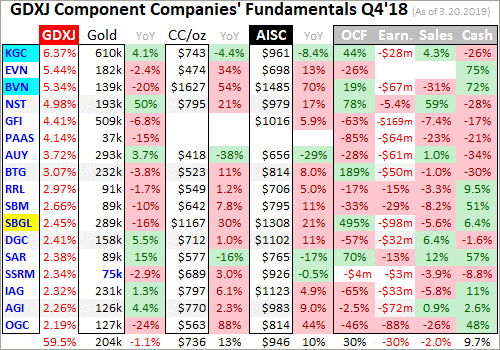
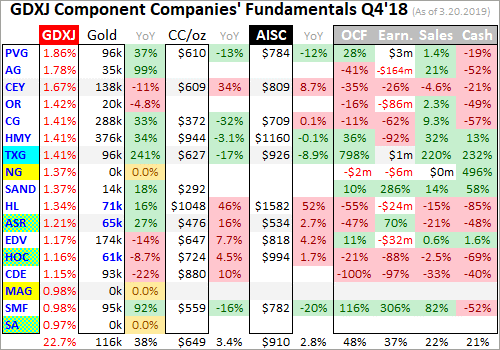
GDXJ’s managers have continued to fine-tune its ranks over this past year, making some good changes. For some inexplicable reason, one of the world’s largest gold miners AngloGold Ashanti was one of this ETF’s top holdings as discussed last quarter. AU was finally kicked out and replaced with a smaller major gold miner Kinross Gold and a mid-tier Buenaventura. Together they now account for 11.7% of GDXJ’s weighting.
Reshuffling at the top makes year-over-year changes less comparable, particularly given KGC’s larger size relative to most of the rest of the GDXJ top 34. Neither it nor BVN were included in GDXJ a year ago, and are new additions since Q3’18 results. Both are sizable GDX components, probably added to GDXJ to keep the weightings down in its smaller Canadian components. 4 other stocks climbed into the top 34.
Torex, Alacer, Hochschild, and Seabridge were already in GDXJ a year ago but weighted below the top 34. GDXJ is largely-but-not-entirely market-cap weighted, so it’s normal for components to rise into or fall out of the top 34 as their stock prices move higher or lower. All the following comparisons between Q4’18 and Q4’17 are across the two slightly-different GDXJ-top-34 sets, not the exact companies shown above.
Production has always been the lifeblood of the gold-mining industry. Gold miners have no control over prevailing gold prices, their product sells for whatever the markets offer. Thus growing production is the only manageable way to boost revenues, leading to amplified gains in operating cash flows and profits. Higher production generates more capital to invest in expanding existing mines and building or buying new ones.
Gold-stock investors have long prized production growth above everything else, as it is inexorably linked to company growth and thus stock-price-appreciation potential. The top 34 GDXJ gold miners excelled in that department, growing their aggregate output by a big 12.8% YoY to 5.1m ounces! That’s really impressive, trouncing both the major gold miners dominating GDX as well as the entire world’s gold-mining industry.
Last week I analyzed the GDX majors’ Q4’18 results, which revealed they are still struggling with serious challenges. The GDX top 34’s total production fell 3.9% YoY when adjusted for a mega-merger. That was worse than total global output slumping 0.9% YoY according to the World Gold Council. So GDXJ’s mostly-mid-tier gold miners really stand out. They are bucking the industry trend with strong production growth.
Again GDXJ’s top 34 components start at the 11th-highest weighting within GDX. Most of the production problems occurred above that threshold, in GDX’s top 10 components which include the world’s largest major gold miners. Their immense average production of 630k ounces in Q4’18 was nearly 4x the 164k average among GDXJ’s top 34! Those GDX top 10 also accounted for a dominant 59.1% of its total weighting.
GDXJ excluding these depleting giants and reallocating their heavy weightings across smaller majors and mid-tier gold miners makes all the difference. The big majors’ waning production and large market caps act as an anchor retarding GDX’s upside. GDXJ doesn’t share that burden, which helped its top 34 show such strong production growth. There’s no reason to own the large majors with their serious challenges.
Also interesting on the GDXJ production front last quarter was silver. This “Junior Gold Miners ETF” also includes major silver miners, both primary and byproduct ones. The GDXJ top 34’s silver mined rocketed 53.8% higher YoY to 31.2m ounces! For comparison the GDX top 34’s total reported output of 28.8m ounces actually slumped 1.5% YoY. The smaller GDXJ mid-tiers are way better than majors at growing their outputs.
The mid-tier gold miners continue to prove all-important production growth is doable off smaller bases. With a handful of mines or less to operate, mid-tiers can focus on expanding them or building a new mine to boost their output beyond depletion. But the majors are increasingly failing to do this with the super-high production bases they operate at. As long as the majors are struggling, it’s prudent to avoid them.
GDXJ investors would be better served if this ETF contained no major gold miners producing over 250k ounces a quarter on average. They still command nearly 1/5th of its weighting, which could be far better reallocated in mid-tiers and juniors. If VanEck kept the major gold miners in GDX where they should be, it could give GDXJ much-better upside potential. That would make this ETF more popular and successful.
In gold mining, production and costs are generally inversely related. Gold-mining costs are largely fixed quarter after quarter, with actual mining requiring about the same levels of infrastructure, equipment, and employees. So the higher production, the more ounces to spread mining’s big fixed costs across. Thus with sharply-higher YoY production in Q4’18, the GDXJ top 34 should’ve seen proportionally-lower costs.
There are two major ways to measure gold-mining costs, classic cash costs per ounce and the superior all-in sustaining costs per ounce. Both are useful metrics. Cash costs are the acid test of gold-miner survivability in lower-gold-price environments, revealing the worst-case gold levels necessary to keep the mines running. All-in sustaining costs show where gold needs to trade to maintain current mining tempos indefinitely.
Cash costs naturally encompass all cash expenses necessary to produce each ounce of gold, including all direct production costs, mine-level administration, smelting, refining, transport, regulatory, royalty, and tax expenses. In Q4’18 these top-34-GDXJ-component gold miners that reported cash costs averaged $698 per ounce. That was up a sharp 10.8% YoY, and considerably worse than the GDX top 34’s $655 average.
Those were the highest GDXJ cash costs seen since at least Q2’16, when I started this research thread. But even $698 is far lower than prevailing gold prices, showing the mid-tier gold miners face no existential threat. And GDXJ’s high cash costs last quarter aren’t righteous anyway, as they were skewed higher by an extreme outlier. One of the new GDXJ companies Buenaventura reported crazy cash costs of $1627 per ounce!
Excluding that wild anomaly, the rest of the GDXJ top 34 averaged cash costs of $662 which was right in line with Q3’18’s $663. They’d be even lower without Sibanye-Stillwater, a troubled South-African major gold miner that saw cash costs soar 30.1% YoY to an ugly $1167. If that too is excluded the overall average falls to $642. So for the most part the mid-tier gold miners’ cash costs remain really low relative to gold.
Way more important than cash costs are the far-superior all-in sustaining costs. They were introduced by the World Gold Council in June 2013 to give investors a much-better understanding of what it really costs to maintain gold mines as ongoing concerns. AISCs include all direct cash costs, but then add on everything else that is necessary to maintain and replenish operations at current gold-production levels.
These additional expenses include exploration for new gold to mine to replace depleting deposits, mine-development and construction expenses, remediation, and mine reclamation. They also include the corporate-level administration expenses necessary to oversee gold mines. All-in sustaining costs are the most-important gold-mining cost metric by far for investors, revealing gold miners’ true operating profitability.
The GDXJ top 34 reporting AISCs averaged $932 per ounce in Q4’18, which was also up a sizable 7.1% YoY. That was also barely the highest seen since at least Q2’16, contradicting the big production growth these miners achieved. But once again this was heavily skewed by extreme outliers, including both BVN and SBGL. Hecla also reported a stunning 52.3% YoY surge in its gold AISCs to a nosebleed $1582 per ounce!
Both BVN and SBGL reported sharply-lower YoY production, helping explain their huge cost surges. HL’s is more temporary, as it expects 2019 gold AISCs to average a still-high-but-much-lower $1250. Without these abnormal situations, the rest of the GDXJ top 34 averaged excellent AISCs of just $863 per ounce. That would be down 0.8% YoY, and is close to the GDX majors’ $837 average also excluding BVN and HL.
Yet even at that skewed artificially-high $932 per ounce, the elite GDXJ gold miners have great potential to enjoy surging profits and hence stock prices. Gold was relatively weak last quarter, averaging $1228 which was 3.8% lower YoY. That implied the mid-tier gold miners as an industry were earning $296 per ounce. That’s still a 24% profit margin, proving Q4’18’s major GDXJ lows weren’t fundamentally righteous.
Gold is faring much better in this almost-over Q1’19, averaging $1303 which is up a big 6.1% quarter-on-quarter. Assuming GDXJ-top-34 AISCs are flat, these elite mid-tier gold miners are earning around $371 per ounce this quarter. That implies enormous 25.3% QoQ profits growth! We won’t know for sure until after Q1’s earnings season, near mid-May. But the mid-tiers’ fundamentals should’ve greatly improved.
Bigger profits driven by higher gold prices are sure to attract investors back to the still-beaten-down gold-stock sector in a big way. The gold miners will stand out even more with earnings growth expected to be scarce in the general stock markets this year. If gold continues marching higher on balance as it ought to, and GDXJ average AISCs retreat as BVN and HL get anomalous costs under control, GDXJ profits will soar.
The GDXJ top 34’s hard accounting results in Q4’18 were mixed, but way better than GDX on all fronts. These elite mid-tier gold miners reported total sales of $7.4b last quarter, up a strong 12.1% YoY. That is right in line with their 12.8% YoY total gold production growth. That huge 53.8% YoY surge in their silver output helped offset the 3.8% YoY decline in average gold prices. The mid-tier gold miners’ revenues are strong.
Compare that to the GDX top 34, which saw sales plunge 10.3% YoY in Q4 due to 3.9%-lower merger-adjusted gold output. Those strong GDXJ-top-34 revenues kept operating-cash-flow generation solid, totaling $2.2b which was down 9.2% YoY. That again crushed the majors in the GDX top 34, which saw OCFs plummet 30.4% YoY. The divergence between how mid-tiers and majors are faring these days is gaping.
The elite GDXJ mid-tier gold miners also invested in growing their production, so their collective total cash on hand slid 14.3% YoY to $5.9b. The GDX majors saw a similar 14.6% YoY decline in their cash, yet they certainly didn’t spend enough to offset their depleting mines. The only real blemish on the GDXJ top 34’s Q4 results came in hard GAAP profits. Their aggregate bottom line collapsed to a $732m loss last quarter!
That was far worse than Q4’17’s $26m loss. Much of this was due to big non-cash impairment charges, writedowns of the carrying value of gold mines and deposits due to lower gold prices and forecasts. If gold miners expect lower gold prices going forward, they have to flush the resulting expected economic losses through current-quarter results when those impairments are perceived. That hammered overall results.
Honestly the Q4’18 impairments seemed pretty unnecessary, with average gold prices merely down 3.8% YoY. 2018’s full-year average gold price actually rose 0.8% YoY. Major impairments usually happen in years gold plunges sharply, like 2013’s brutal 27.9% plummeting. Something like that really changes the economic assumptions underlying gold mines. But gold only slumped 1.6% last year, which is utterly trivial.
Some of the bigger impairment charges came from First Majestic Silver and Osisko Gold, which wrote off $168m and $166m. This primary silver miner and gold-royalty company aren’t even mid-tier gold miners. And the perpetually-troubled South African majors Gold Fields and Sibanye-Stillwater which have long tainted GDXJ reported big half-year losses implying $169m and $98m in Q4. These alone total $601m of losses.
That accounted for nearly 5/6ths of the GDXJ top 34’s total GAAP losses last quarter. While many of the elite mid-tier gold miners reported small losses, the great majority of the surge in losses came from a handful of stocks. Overall the GDXJ GAAP profits looked relatively decent compared to the majors. GDX’s top 34 reported a staggering $6.0b in accounting losses in Q4’18! The mid-tiers are thrashing the majors.
GDXJ’s mostly-mid-tier component list of great gold miners is really faring well, especially compared to the struggling large gold miners. Investors looking to ride this gold-stock bull should avoid the world’s biggest gold producers and instead deploy their capital in the mid-tier realm. The best gains will be won in individual smaller gold miners with superior fundamentals, plenty of which are included within GDXJ.
Despite being the world’s leading gold-stock ETF, GDX needs to be avoided. The major gold miners that dominate its weightings are struggling too much fundamentally, unable to grow their production. Capital will instead flow into the mid-tiers, juniors, and maybe a few smaller majors still able to boost their output and thus earnings going forward. None of this is new, but the major and mid-tier disconnect continues to worsen.
Again back in essentially the first half of 2016, GDXJ skyrocketed 202.5% higher on a 29.9% gold upleg in roughly the same span! While GDX somewhat kept pace then at +151.2%, it is lagging GDXJ more and more as its weightings are more concentrated in stagnant gold mega-miners. The recent big mergers are going to worsen that investor-hostile trend. Investors should buy better individual gold stocks, or GDXJ.
One of my core missions at Zeal is relentlessly studying the gold-stock world to uncover the stocks with superior fundamentals and upside potential. The trading books in both our popular weekly and monthly newsletters are currently full of these better gold and silver miners. Mostly added in recent months as gold stocks recovered from deep lows, our unrealized gains are already running as high as 74% this week!
If you want to multiply your capital in the markets, you have to stay informed. Our newsletters are a great way, easy to read and affordable. They draw on my vast experience, knowledge, wisdom, and ongoing research to explain what’s going on in the markets, why, and how to trade them with specific stocks. As of Q4 we’ve recommended and realized 1076 newsletter stock trades since 2001, averaging annualized realized gains of +16.1%! That’s nearly double the long-term stock-market average. Subscribe today for just $12 per issue!
The bottom line is the mid-tier gold miners are thriving fundamentally. They are still rapidly growing their production while majors suffer sharp output declines. The mid-tiers are holding the line on costs, which portends strong leveraged profits growth as gold continues grinding higher on balance. The performance gap between the smaller mid-tier and junior gold miners and larger major ones is big and still mounting.
Investors and speculators really need to pay attention to this intra-sector disconnect. Gold and its miners’ stocks should power far higher in coming years as the lofty general stock markets roll over. But the vast majority of the gains will be concentrated in growing gold miners, not shrinking ones. This means the mid-tier and junior gold miners will far outperform the majors. The smaller miners have superior fundamentals.
Adam Hamilton, CPA
March 25, 2019
Copyright 2000 – 2019 Zeal LLC (www.ZealLLC.com)
In recent weeks we noted the bullish outlook for the stock market.
Friday the S&P 500 as well as ACWX (global equity ETF ex US stocks) closed above resistance and made higher highs.
Not surprisingly, as US and global equities have avoided a bear market (for the time being), precious metals have weakened. It’s not a surprise that as Gold failed to breakout both the S&P 500 and global equities (ACWX) held their 200-day moving averages and then made a higher high.
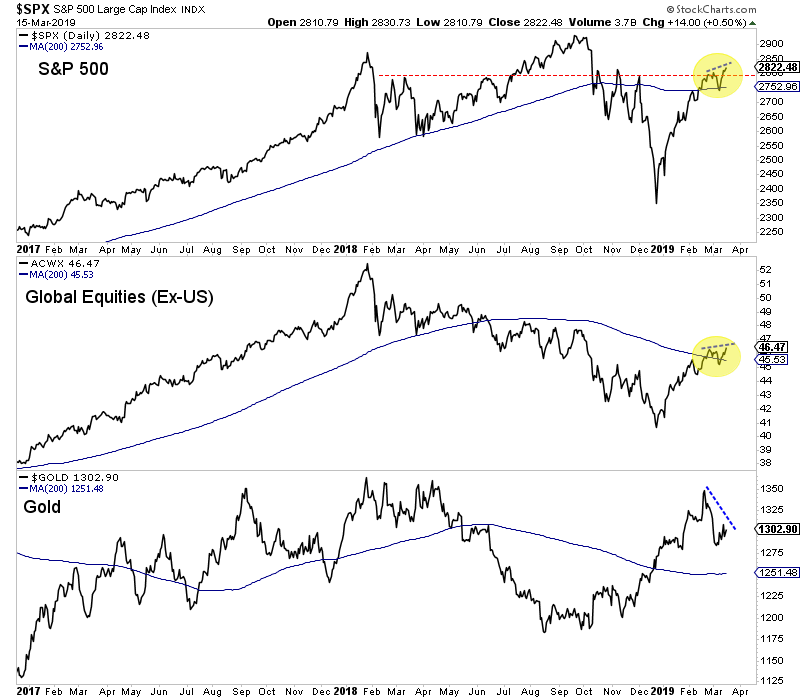
The very recent underperformance in Gold and precious metals is better illustrated in the ratio charts below.
Gold against stocks made a very strong move in the fourth quarter but instead of digesting or consolidating that move, the ratios have steadily declined. The same could be said for the GDX ratios as they have formed rounding tops.
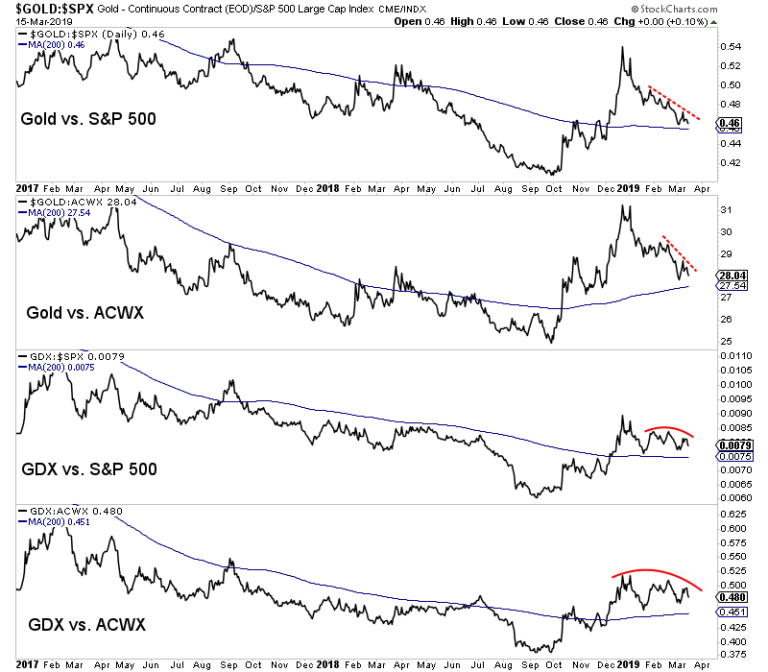
The implication is obviously not favorable for precious metals because outperformance of the stock market is a necessity for a bull market and especially so, given the current context.
That being said, one positive for the precious metals complex is the miners are outperforming the metals. Last week the GDX to Gold ratio hit a seven and a half month high.
Another positive is breadth has not deteriorated yet. The GDX advance decline line is only a tiny bit off the recent high and 73% of the HUI and 65% of GDXJ are above the 200-day moving averages.
Ultimately and to continue to beat the dead horse, a bull market in precious metals cannot begin without outperformance against the stock market. That will likely coincide with the Fed moving from pause mode to rate cuts.
The immediate outlook is bullish for stocks and therefore do not expect Gold to breakout or begin a bull market. It’s unclear if renewed stock market strength will lead to a larger topping pattern or if its an indication that growth will stabilize for the rest of 2019.
Regardless, until Gold outperforms stocks and the Fed is ready to cut, we are focused on the companies that can perform without a rising Gold price. To learn which juniors have 3x to 5x potential over the next 12 to 18 months, consider learning more about our premium service.
The major gold miners are grinding higher in a solid upleg, fueling growing interest in this small contrarian sector. They’ve mostly finished reporting their fourth-quarter results, revealing how they are really faring fundamentally. Collectively the world’s biggest gold miners continue to face serious challenges, which often stem from declining production. That makes stock picking more important than ever for investment success.
Four times a year publicly-traded companies release treasure troves of valuable information in the form of quarterly reports. Required by the U.S. Securities and Exchange Commission, these 10-Qs and 10-Ks contain the best fundamental data available to traders. They dispel all the sentiment distortions inevitably surrounding prevailing stock-price levels, revealing corporations’ underlying hard fundamental realities.
While 10-Qs with filing deadlines of 40 days after quarter-ends are required for normal quarters, 10-K annual reports are instead mandated after quarters ending fiscal years. Most gold miners logically run their accounting on calendar years, so they issue 10-Ks after Q4s. Since these annual reports are larger and must be audited by independent CPAs, their filing deadlines are extended to 60 days after quarter-ends.
The definitive list of major gold-mining stocks to analyze comes from the world’s most-popular gold-stock investment vehicle, the GDX VanEck Vectors Gold Miners ETF. Launched way back in May 2006, it has an insurmountable first-mover lead. GDX’s net assets running $10.6b this week were a staggering 47.1x larger than the next-biggest 1x-long major-gold-miners ETF! GDX is effectively this sector’s blue-chip index.
It currently includes 45 component stocks, which are weighted in proportion to their market capitalizations. This list is dominated by the world’s largest gold miners, and their collective importance to this industry cannot be overstated. Every quarter I dive into the latest operating and financial results from GDX’s top 34 companies. That’s simply an arbitrary number that fits neatly into the tables below, but a commanding sample.
As of this week these elite gold miners accounted for fully 94.1% of GDX’s total weighting. Last quarter they combined to mine 300.8 metric tons of gold. That was 35.2% of the aggregate world total in Q4’18 according to the World Gold Council, which publishes comprehensive global gold supply-and-demand data quarterly. So for anyone deploying capital in gold or its miners’ stocks, watching GDX miners is imperative.
The largest primary gold miners dominating GDX’s ranks are scattered around the world. 21 of the top 34 mainly trade in US stock markets, 6 in Australia, 5 in Canada, and 1 each in China and the United Kingdom. GDX’s geopolitical diversity is good for investors, but makes it more difficult to analyze and compare the biggest gold miners’ results. Financial-reporting requirements really vary from country to country.
In Australia, South Africa, and the UK, companies report in half-year increments instead of quarterly. The big gold miners often publish quarterly updates, but their data is limited. In cases where half-year data is all that is made available, I split it in half for a Q4 approximation. While Canada has quarterly reporting, the deadlines are looser than in the States. Some Canadian gold miners drag their feet in getting results out.
While it is challenging bringing all the quarterly data together for the diverse GDX-top-34 gold miners, analyzing it in the aggregate to see how they are doing is essential. So each quarter I wade through all available operational and financial reports and dump the data into a big spreadsheet for analysis. The highlights make it into these tables. Blank fields mean a company hadn’t reported that data as of this Wednesday.
The first couple columns of these tables show each GDX component’s symbol and weighting within this ETF as of this week. While most of these stocks trade on U.S. exchanges, some symbols are listings from companies’ primary foreign stock exchanges. That’s followed by each gold miner’s Q4’18 production in ounces, which is mostly in pure-gold terms. That excludes byproduct metals often present in gold ore.
Those are usually silver and base metals like copper, which are valuable. They are sold to offset some of the considerable expenses of gold mining, lowering per-ounce costs and thus raising overall profitability. In cases where companies didn’t separate out gold and lumped all production into gold-equivalent ounces, those GEOs are included instead. Then production’s absolute year-over-year change from Q4’17 is shown.
Next comes gold miners’ most-important fundamental data for investors, cash costs and all-in sustaining costs per ounce mined. The latter directly drives profitability which ultimately determines stock prices. These key costs are also followed by YoY changes. Last but not least the annual changes are shown in operating cash flows generated, hard GAAP earnings, revenues, and cash on hand with a couple exceptions.
Percentage changes aren’t relevant or meaningful if data shifted from positive to negative or vice versa, or if derived from two negative numbers. So in those cases I included raw underlying data rather than weird or misleading percentage changes. Companies with symbols highlighted in light-blue have newly climbed into the elite ranks of GDX’s top 34 over this past year. This entire dataset together is quite valuable.
It offers a fantastic high-level read on how the major gold miners are faring fundamentally as an industry. Unfortunately they were generally struggling on multiple fronts in Q4’18. The more quarterly reports I read and data I gathered, the more apparent it became that many if not most of the world’s biggest gold miners continue to face serious challenges. That makes GDX itself way less attractive to gold-stock investors.
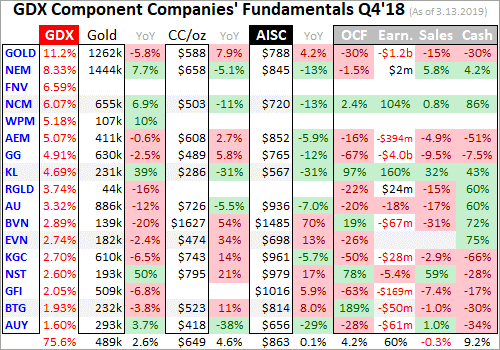
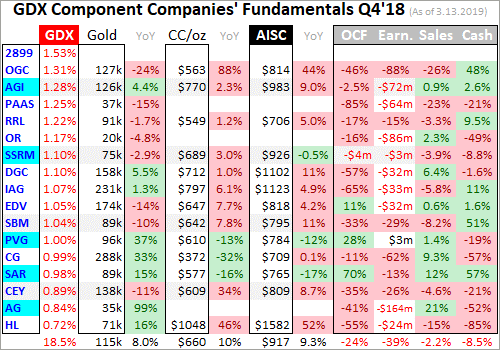
GDX’s holdings grew much more concentrated over this past year, with the top 34’s total weighting rising from 90.5% in Q4’17 to 94.1% in Q4’18. That is partially due to increased merger-and-acquisition activity driven by big gold miners trying to replace depleting production. For years many have proven unable to replenish mined gold organically, leaving buying other companies the only option to maintain mining tempos.
Production has always been the lifeblood of the gold-mining industry. Gold miners have no control over prevailing gold prices, their product sells for whatever the markets offer. Thus growing production is the only manageable way to boost revenues, leading to amplified gains in operating cash flows and profits. Higher production generates more capital to invest in expanding existing mines and building or buying new ones.
Gold-stock investors have long prized production growth above everything else, as it is inexorably linked to company growth and thus stock-price-appreciation potential. But for some years now the major gold miners have been struggling to grow production. Large economically-viable gold deposits are getting increasingly harder to find and more expensive to exploit, with the low-hanging fruit long since picked.
More and more gold-industry experts believe peak gold is nearing, after which global mine production will start declining. For many years now new deposit discoveries and mine builds have failed to keep pace with depletion at existing mines. So production growth is slowing. According to the World Gold Council’s latest fundamental data, global mine production only edged 0.8% higher in 2018 compared to 5.3% in 2013!
GDX’s major gold miners are the biggest in the world, with access to many billions of dollars of capital to expand their operations. Yet even with those vast resources by his sector’s standards, the top 34 have still failed to grow their production. In Q4’18 they collectively produced 9.7m ounces of gold, plunging a colossal 7.5% YoY from Q4’17’s 10.5m! That is shockingly bad, and the root of the major gold miners’ problems.
Total world gold production per the WGC merely slipped 0.9% YoY last quarter. Incidentally that was just the second YoY quarterly decline in the past 32 quarters, adding more fuel to peak-gold theories. Across all of them growth averaged 2.5% YoY. Seeing the top 34 GDX gold miners’ production plunge at 8.3x the world rate in Q4’18 is very concerning. Many major gold miners are stagnating, retarding GDX’s potential.
Just over half of GDX’s top 34 gold miners, fully 18 of them, suffered average production declines of 8.9% YoY! The worst in terms of impact came from GDX’s largest component Barrick Gold. GOLD’s gold mined fell 5.8% YoY in Q4’18, representing 1/10th of the total drop among the GDX top 34. Barrick is so desperate to buy production to offset its serious depletion that it recently purchased major gold miner Randgold.
That deal completed on January 1st, 2019, so GOLD’s Q4’18 results don’t yet reflect it. Randgold mined 374.6k ounces last quarter, which was actually up an impressive 9.9% YoY. That helps explain some of the big production drop among the GDX top 34. Randgold’s production was included in the GDX top 34 in Q4’17, but of course its stock no longer exists this week when I downloaded GDX’s current component list.
Adding Randgold’s Q4’18 production in cuts the GDX top 34’s production decline to 3.9% YoY. Going the other way and instead removing it from Q4’17’s total leaves the top 34’s mined gold down 4.4% YoY. But that’s still much worse than that overall 0.9% YoY decline in global gold mine production last quarter. As I explained in depth in a mid-February essay, gold-stock mega-mergers won’t solve this depletion problem.
Before Q4’18, Randgold suffered 4 quarters in a row of falling production averaging declines of 7.4% YoY. Barrick’s quarterly production has fallen for 6 quarters in a row, averaging hefty 13.4% YoY drops! Merging depleting major gold miners together doesn’t magically boost their collective production. It just masks production declines for a single year, the first 4 quarters comparing post-merger results with pre-merger ones.
Once those great cross-merger YoY comparisons pass, the relentless depletion in both companies’ gold mines will quickly become apparent again. The larger any gold miner, the harder it is to grow and even just maintain production levels. Because exploration budgets largely collapsed since 2013 when gold plunged and crushed gold stocks, the global pipeline of bigger economic gold deposits to mine has mostly dried up.
GDX’s top-two components have always been Barrick Gold and Newmont Gold. This week together they accounted for 19.5% of its total weighting and a whopping 28.0% of the top 34’s total Q4’18 gold mined! Had Barrick’s and Randgold’s merger been consummated in Q4, GOLD’s production would’ve soared over 1.8m ounces. Newmont didn’t want Barrick to surpass it, so in January it announced it was buying Goldcorp.
GG produced 630k ounces of gold in Q4, which will be added onto Newmont’s production going forward once this deal is done. Had Newmont and Goldcorp been together in Q4’18, this gold-mining behemoth would’ve produced nearly 2.1m ounces! Those levels are staggering, and will really increase these two mega-miners’ dominance over this sector and GDX. These mergers’ pro-forma impact on GDX is massive.
Using Q4’s numbers, Newmont and Barrick would’ve accounted for a colossal 38.8% of the GDX top 34’s entire gold mined including Randgold. Their collective weighting in this leading gold-stock ETF would shoot over a quarter. So the overall GDX future performance will be more dominated by Newmont and Barrick than ever before. If they can’t grow production from such stratospheric levels, they’ll retard GDX’s upside.
With gold deposits increasingly harder to discover, and taking even longer to get permitted and brought into production at ever-higher costs, the biggest gold miners are going to find it impossible to even maintain their outputs. Any production growth is going to come from smaller gold miners, and their stocks will soar to reflect it. Unfortunately the impact on GDX will be muted, since its weightings are tyrannized by the giants.
Kirkland Lake Gold has been one of the best-performing gold stocks over this past year. In 2018 its stock rocketed 69.9% higher as GDX fell 9.3%! The reason investors flocked to KL is it has rapidly grown its gold output, which soared 38.8% YoY in Q4’18. That greatly boosted its sales, operating cash flows, and profits. More gold produced spreads out the big fixed costs of mining across more ounces, amplifying earnings.
No matter how awesome KL’s management has proved, such production growth was only possible from a relatively-low base. KL produced 167k ounces of gold in Q4’17, compared with around 8x that from each Newmont and Barrick. The biggest gains in gold-stock prices won’t come from super-major-dominated GDX, but from smaller mid-tier gold miners. Investors will continue to prize and richly reward production growth.
Peak gold is likely bearish for the largest gold miners that drive GDX. Capital inflows from investors will wane along with their shrinking production. But lower gold mined supply on balance going forward is wildly bullish for the mid-tier and junior gold miners growing their production! The resulting higher gold prices will catapult their profits and thus stock prices far higher, attracting investors fleeing the struggling majors.
The only way to reap these massive gains is directly investing in the best individual gold miners. Their fundamentals are far superior to their sector’s as a whole. While buying GDX is easy, the lion’s share of that capital is funneled into the major gold miners with slowing production. Their underperformance will dilute away any outperformance among mid-tier miners in this ETF, leading to way-inferior overall gains.
Given the sharply-lower gold production by the GDX top 34 in Q4’18, per-ounce mining costs should’ve risen proportionally. Gold-mining costs are largely fixed quarter after quarter, with actual mining requiring the same levels of infrastructure, equipment, and employees. So the lower production, the fewer ounces to spread mining’s big fixed costs across. These elite gold miners indeed reported higher costs last quarter.
There are two major ways to measure gold-mining costs, classic cash costs per ounce and the superior all-in sustaining costs per ounce. Both are useful metrics. Cash costs are the acid test of gold-miner survivability in lower-gold-price environments, revealing the worst-case gold levels necessary to keep the mines running. All-in sustaining costs show where gold needs to trade to maintain current mining tempos indefinitely.
Cash costs naturally encompass all cash expenses necessary to produce each ounce of gold, including all direct production costs, mine-level administration, smelting, refining, transport, regulatory, royalty, and tax expenses. In Q4’18 these top 34 GDX-component gold miners that reported cash costs averaged $655 per ounce. That was up a sharp 9.1% YoY, among the highest quarterly cash costs seen in years.
That still shows the major gold miners face no existential threat as long as gold stays over $650, which is about half current levels. And Q4’s cash costs are artificially high due to two anomalies. Buenaventura and Hecla both reported cash costs rocketing to extremes of $1627 and $1048! Excluding these outliers, the rest of the GDX top 34 averaged cash costs of $598, which was right in line with Q4’17’s overall $600 read.
Way more important than cash costs are the far-superior all-in sustaining costs. They were introduced by the World Gold Council in June 2013 to give investors a much-better understanding of what it really costs to maintain gold mines as ongoing concerns. AISCs include all direct cash costs, but then add on everything else that is necessary to maintain and replenish operations at current gold-production levels.
These additional expenses include exploration for new gold to mine to replace depleting deposits, mine-development and construction expenses, remediation, and mine reclamation. They also include the corporate-level administration expenses necessary to oversee gold mines. All-in sustaining costs are the most-important gold-mining cost metric by far for investors, revealing gold miners’ true operating profitability.
The GDX top 34 gold miners reported average AISCs of $889 in Q4’18, up 3.6% YoY. That is inversely proportional to the 4%ish YoY drop in their gold production when Randgold is accounted for. While $889 is the highest seen since at least Q2’16 when I started doing this quarterly research, it is still roughly in line with the past four quarters’ averages of $858, $884, $856, and $877. And like cash costs this is skewed high.
Buenaventura and Hecla also reported anomalous super-high AISCs of $1485 and $1582. Excluding them, the rest of the GDX top 34 averaged much-lower all-in sustaining costs of $837 per ounce in Q4’18. So much to their credit, the major gold miners are ruthlessly managing their costs as their production slumps. That’s bullish for their coming earnings growth as gold continues grinding higher in this bull market.
Gold-mining profits really leverage higher gold prices, and big earnings growth attracts in investors to bid up stock prices. In Q4’18 gold averaged about $1228 per ounce. At the GDX top 34’s average AISC of $889, that implies the major gold miners as an industry were earning profits of $339 per ounce. Those are going to grow considerably this quarter. The almost-over Q1’19 has seen average gold prices near $1303.
AISCs are likely to decline from Q4’s high levels in this current Q1, but let’s assume they remain stable at $889. That implies the major gold miners are earning about $414 per ounce this quarter. In other words a mere 6.1% quarter-on-quarter rally in average gold prices could drive a major 22.1% QoQ jump in the major gold miners’ profits! That’s why major gold stocks tend to amplify gold uplegs by 2x to 3x or so.
It is encouraging the gold miners’ costs remain well-positioned to fuel big profits growth in a higher-gold-price environment despite their intractable production slumps. Investors love chasing earnings growth, which is looking to be scarce in the general stock markets this year. The good gold miners’ stocks are likely to see big capital inflows as gold continues climbing, driving them and to a lesser extent GDX higher.
Unfortunately the hard accounting results in Q4’18 were far worse than AISCs. Q4’18’s average gold price was 3.8% lower year-over-year, which combined with the 4%ish-lower gold production including Randgold among the GDX top 34 to really weaken financial performance. Overall quarterly revenues among these elite major gold miners fell 10.3% YoY to $12.8b. Operating cash flows amplified that drop.
Total OCFs among these GDX stocks collapsed 30.4% YoY to $3.7b in Q4’18. That means less capital available to finance mine expansions and new mine builds, exacerbating the production struggles. Yet overall corporate treasuries fared relatively better with a 14.6% YoY decline to total cash balances near $12.1b for all these miners. All this was understandable, but hard GAAP accounting profits were a total disaster.
Warren Buffett once famously joked about airline stocks, saying he would’ve done investors a huge favor if he could’ve shot down the Wright brothers’ maiden flight in 1903 killing that whole industry before it was born. His point was the airlines never earned profits over the long-term, so they weren’t worth investors’ time. The major gold stocks’ Q4 losses made it look like they could never earn any money either, terrible.
Last quarter the top 34 GDX gold miners, the biggest and supposedly best in the world, lost a staggering $6.0b collectively! That compared to relatively-minor total losses under $0.1b in Q4’17. At $1228 gold the major gold miners should’ve been earning solid profits. Yet they were hemorrhaging money in an accounting sense fast enough to make drunken sailors blush. So what the heck happened in this sector?
The problem was colossal non-cash impairment charges, gold miners writing down the value of mines on their books for a variety of reasons. These were mainly lower forecast gold prices reducing the economic reserves at those mines. While an accounting fiction, these perceived losses must still be flushed through income statements when they are believed to happen. The list of impairments disclosed in quarterlies was long.
GOLD reported about $1.1b in impairment charges in Q4’18, AEM $390m, AUY $151m, AG $168m, and the list goes on. But the writeoff king last quarter was Goldcorp, reporting an inconceivable $4.7b in impairment charges across multiple mines! Newmont’s offer for Goldcorp valued its mines much lower than their carried book value, forcing GG to write off the enormous differences in what may be its last solo quarter.
Together Barrick and Goldcorp wrote off $5.8b in assets in Q4’18, 97% of the GDX top 34’s total GAAP losses last quarter! This is yet another reason gold-stock mega-mergers are bad news for this entire sector. They give the managements of these giant gold miners cover for flushing away what were likely poor past decisions in allocating capital. Smaller miners focused on fewer mines seem to suffer fewer impairments.
I’ve extensively studied and actively traded gold-mining stocks for decades now, and these latest writeoffs seem really fishy. Major impairments are understandable in years gold plunges sharply, like 2013 when it plummeted 27.9%. That really changes the economic assumptions underlying the value of gold mines on balance sheets. But 2018 saw nothing like that, with gold slumping a trivial 1.6%. Big impairments made no sense.
While the average gold price slumped 3.8% YoY in Q4’18, that isn’t even material. And in full-year terms, 2018’s average gold price was actually 0.8% higher YoY. Huge writedowns on a flat gold year don’t look righteous at all. Gold-mining-company managements have a serious credibility problem with gold-stock investors, and pulling stunts like this worsen it. These guys need to start managing for their shareholders.
The major gold miners’ Q4’18 results were disappointing overall. Huge sky-is-falling impairments along with sharply-lower production driving much-weaker sales and operating-cash-flow generation sure made GDX look like an iffy investment at best. Offsetting that negativity somewhat was good control over their all-in sustaining costs, which only moved modestly higher and would’ve fallen without a couple anomalous reads.
The key takeaway here is avoid GDX. The world’s leading gold-stock ETF is increasingly burdened with giant gold miners struggling too much fundamentally. Their high weightings within this ETF are certain to retard its future performance. It’s far better to deploy capital in great smaller individual gold miners with superior fundamentals. Plenty of these companies are included in GDX, but have relatively-low weightings.
GDX’s little-brother ETF GDXJ is another option. While advertised as a “Junior Gold Miners ETF”, it is really a mid-tier gold miners ETF. It includes most of the better GDX components, with higher weightings since the largest gold miners are excluded. I wrote an entire essay in mid-January explaining why GDXJ is superior to GDX, and my next essay a week from now will delve into the GDXJ gold miners’ Q4’18 results.
Back in essentially the first half of 2016, GDXJ rocketed 202.5% higher on a 29.9% gold upleg in roughly the same span! While GDX somewhat kept pace then at +151.2%, it is lagging GDXJ more and more as its weightings are more concentrated in stagnant gold mega-miners. The recent big mergers are going to worsen that investor-hostile trend. Investors should buy better individual gold stocks, or GDXJ, instead of GDX.
One of my core missions at Zeal is relentlessly studying the gold-stock world to uncover the stocks with superior fundamentals and upside potential. The trading books in both our popular weekly and monthly newsletters are currently full of these better gold and silver miners. Mostly added in recent months as gold stocks recovered from deep lows, our unrealized gains are already running as high as 75%+ this week!
If you want to multiply your capital in the markets, you have to stay informed. Our newsletters are a great way, easy to read and affordable. They draw on my vast experience, knowledge, wisdom, and ongoing research to explain what’s going on in the markets, why, and how to trade them with specific stocks. As of Q4 we’ve recommended and realized 1076 newsletter stock trades since 2001, averaging annualized realized gains of +16.1%! That’s nearly double the long-term stock-market average. Subscribe today for just $12 per issue!
The bottom line is the major gold miners are still struggling fundamentally. Their production shrinkage is accelerating, pushing costs proportionally higher. That led to weaker sales and operating cash flows in Q4. And accounting profits cratered into a dark abyss on enormous and suspicious impairment charges by big gold miners involved in mega-mergers. These poor results are retarding GDX’s upside potential.
But smaller mid-tier and junior gold miners with superior fundamentals are bucking this trend to enjoy big stock-price gains. They are still able to grow production off way-smaller bases, boosting their earnings and attracting investment capital. They will continue amplifying gold’s uplegs, multiplying wealth for their contrarian investors. Gold-stock upside potential remains huge outside of the increasingly-problematic majors.
Adam Hamilton, CPA
March 18, 2019
Copyright 2000 – 2019 Zeal LLC (www.ZealLLC.com)
A lack of exploration and discovery near Hemlo has created an opportunity for one Canadian company with a deep connection to the region to make the next discovery and the regional connection between two possible gold systems.
by Nicholas LePan
The winters in Northern Ontario pause most exploration programs, however for one company, the deep chill provides an opportunity to follow up on an impressive drill hole in the shadow of Hemlo’s headframe, one of Canada’s largest gold discoveries.
Over the winter, Canadian Orebodies Inc. (TSX-V: CORE) has been building ice pads on a lake in preparation for a 1000-metre-plus drilling program. The drill program seeks to explore the extension of recently drilled high-grade gold-bearing veins on the Black Raven property. The ice pads allow the drill to target the right angle to follow up on results received from the fall 2018 drilling program.
On Dec. 11, 2018, the company announced that drilling had intercepted 133.2 g/t Au over 2.0 metres, which included 443.0 g/t Au over 0.6 metres (see press release), in a vein which the company has dubbed the Super G vein in the Smoke Lake Gold System. These results were the confirmation the company needed; the Super G vein is part of a much larger mineralized system, which comprises multiple mineralized stacked layers with potential for high-grade gold in every structure.
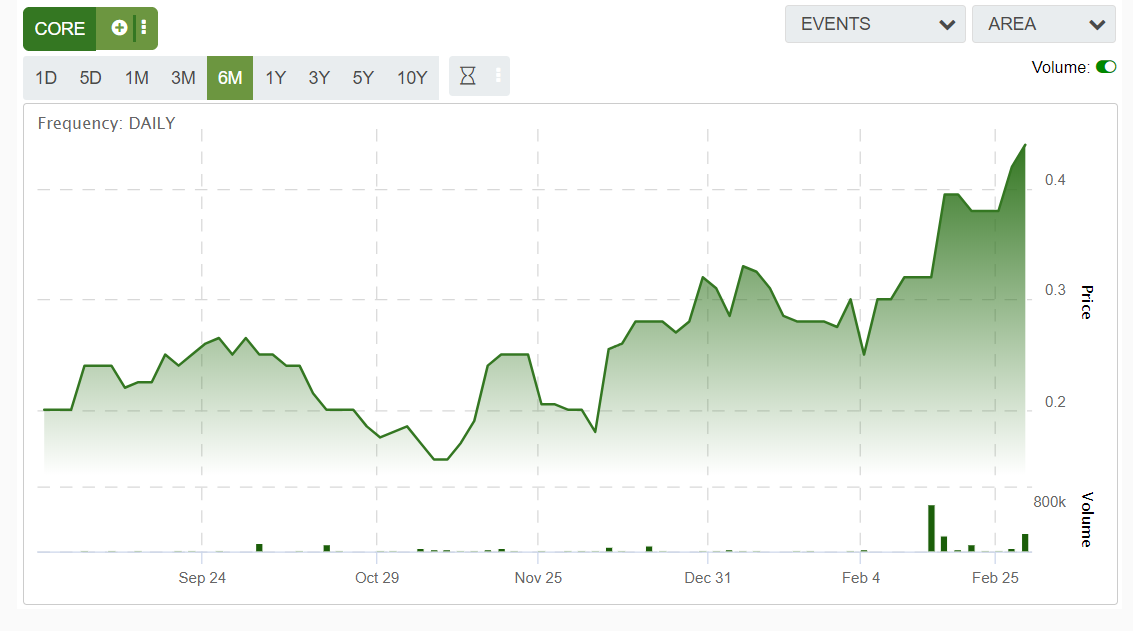
This hole was the highest grade reported on the property and it sparked interest from the market. Since that time, anticipation of further drilling has driven up share prices from 18 cents before the results to currently 34 cents per share.
Gordon McKinnon, President of Canadian Orebodies, stated:
“Our intersection from hole BR-2018-002 produced one of the highest-grade gold intercepts in the Hemlo Greenstone Belt outside of the Hemlo Mines complex, which was discovered in 1981. Looking into 2019, the combination of this season’s results, with the historic drilling results, will greatly improve our exploration model to expand the high-grade gold zones known in the system and to discover new ones.”
The significance of this new drill program is not be understated. There has been very little discovery since Hemlo, largely in part due to a lack of systematic exploration. Typically, the presence of one large orebody indicates the region has the geological potential to host further deposits, it is just a matter of getting the trend right and doing the drilling.
The main target of the 2019 drilling program is the Super G Structure of the Smoke Lake Gold System. Part of the program will target the up-dip and lateral extensions of the high-grade zone intersected in BR-2018-002.
The emerging picture suggests that the stacking of high and low grade gold zones is forming the Smoke Lake Gold System. The company is comparing its results to the width and grade of results from Amex Exploration’s (TSX-V: AMX) Eastern Gold Zone on its Perron Project.
Potential upside from the ongoing drill program could come from the extension of the discovered high-grade zone in the Super G Structure and extensions in its mineralization footprint. This could lead to the discovery of new high-grade zones in the other structures forming the Smoke Lake Gold System.
This work is going toward a larger regional picture of the potential for gold mineralization on the company’s land package. In 2017, drilling at the company’s Wire Lake project suggested that higher grade gold mineralization surrounded by a halo of lower grade mineralization can be hosted in the Wire Lake Gold System, with a headline result of 7.56 g/t gold over 4.9 metres in WL-2017-001 including 57.3 g/t gold over 0.5 metres (see release).
New geochemical data suggests that the Wire Lake Gold system is possibly related to the Smoke Lake Gold System, based on similarities between the alteration and mineralization in the two systems. If confirmed this would add an additional 5 kilometers to the Wire Lake Gold System which is already confirmed over a strike length of 3 kilometres, creating an even larger target in a underexplored greenstone belt.
This is just the beginning for the Canadian Orebodies team led by Gordon McKinnon. Calling on his family tradition, McKinnon has built a team that knows the region well and is looking to prove the continuity of his father’s success, who played a key role in the discovery of Hemlo.
On the board is John Harvey, who served as President and CEO of Hemlo Gold Mines Inc. from 1989 to 1991. Serving as an advisor to the company is Robert Middleton, who led the Rosario Resources team that discovered the Bell Creek Mine in Timmins, Ontario and, in 1982, he played a role in drilling the discovery hole at the Goliath Mine in Hemlo, Ontario.
Alongside this proven team is a series of successful shareholders such as Robert Cudney of Northfield Capital, who sold Gold Eagle Mines to Goldcorp for $1.5 billion, Sean Roosen’s Osisko Mining, Rob McEwen and Rick Rule. With these shareholders, the company has access to capital despite the company already being in a well-funded position with $2.2 million and ~58 million shares fully diluted.
The company is expecting the program to wrap in late March with assays shortly after that. These results could prove that there are more Hemlos in Ontario.
About Canadian Orebodies Inc.
Canadian Orebodies is a Canadian-based mineral exploration company with a portfolio of properties in Ontario and Nunavut. Canadian Orebodies is focused on generating shareholder value through the advancement of its two Hemlo area projects: Wire Lake and the North Limb.
By Nicholas LePan
March 14, 2019
The author of this article was compensated in cash and does not hold any securities in Canadian Orebodies.
- With little fanfare, gold is staging a nice consolidation in the $1280-$1350 price zone.
- Please click here now. Double-click to enlarge. A breakout from this $70 trading range would usher in a fresh target of $1400 and perhaps $1420.
- Note the superb position of the 14,7,7 series Stochastics oscillator at the bottom of the chart.
- Its great positioning is just one of many reasons why $1280 could be the launch pad for the next significant rally.
- Fundamentals make charts, and there are no long-term fundamentals more bullish for gold than the relentless growth of Chindian demand versus limited global mine supply growth.
- On that note, please click here now. Most American investors are wasting time begging the U.S. stock market to go higher, while the nation’s top institutional analysts are wisely focused on the incredibly bullish developments taking place in the Asian markets.
- Chinese government stimulus, rising demand for copper, and rising corporate earnings across Asia are all creating a stock market rally that could become a serious barn burner.
- That’s good news for physical market gold demand, which is good news for Western gold stock investors!
- Please click here now. The U.S. stock market situation is also positive for gold.
- Most U.S. stocks would have already melted far below their December lows if the Fed had not changed course so suddenly on rate hikes and quantitative tightening.
- U.S. first quarter GDP and earnings growth are likely abysmal, even after a major corporate tax cut, tariffs, ultra-low interest rates, and a mountain of stock market buybacks.
- Morgan Stanley analysts believe U.S. corporate earnings growth will fall to 1% in 2019 and I’ll suggest it would be negative if not for the stock market buybacks.
- Without the Fed’s backstop and the corporate buybacks, the U.S. stock market would probably be in free-fall right now.
- GDP growth in China is 6%+ and in India it is 7%+. The bottom line: Weakening growth in the West and solid growth in Asia is a win-win situation for gold.
- Please click here now. Double-click to enlarge this FXI-NYSE chart.
- The Chinese stock market just completed a textbook pullback to the neckline of a double bottom pattern after an upside breakout.
- With heavyweights like Morgan Stanley backing the rally, the Chinese stock market is likely headed much higher, and Asian investors will celebrate the upside action by purchasing gold.
- It’s mathematics as simple as 1+1=2.
- Central bank buying is another important factor for gold demand… and it’s accelerating.
- Please click here now. China’s central bank has resumed its monthly gold buying, and now India’s central bank seems to be buying consistently too!
- Please click here now. Double-click to enlarge this GDX chart.
- The bounce from the $21.50 support zone feels “perky”.
- Most intermediate and senior miners have made significant progress in cutting their AISC (all-in sustaining costs).
- A rally in bullion to above $1400 would turn many of these miners into “cash cows” and open the door to sustained institutional interest in the sector. That’s the main reason why I’m adamant that the entire $23 – $18 price zone for GDX is such an important buying area for investors!
Special Offer For Website Readers: Please send me an Email to freereports4@gracelandupdates.com and I’ll send you my free “Gold Portfolio With Silver Lining!” report. I highlight an ideal mix of gold and silver stocks for investors to profit as the gold price rally resumes!
Thanks!!
Stewart Thomson
March 13, 2019
Email:
Stewart Thomson is a retired Merrill Lynch broker. Stewart writes the Graceland Updates daily between 4am-7am. They are sent out around 8am-9am. The newsletter is attractively priced and the format is a unique numbered point form. Giving clarity of each point and saving valuable reading time.
Risks, Disclaimers, Legal
Stewart Thomson is no longer an investment advisor. The information provided by Stewart and Graceland Updates is for general information purposes only. Before taking any action on any investment, it is imperative that you consult with multiple properly licensed, experienced and qualified investment advisors and get numerous opinions before taking any action. Your minimum risk on any investment in the world is: 100% loss of all your money. You may be taking or preparing to take leveraged positions in investments and not know it, exposing yourself to unlimited risks. This is highly concerning if you are an investor in any derivatives products. There is an approx $700 trillion OTC Derivatives Iceberg with a tiny portion written off officially. The bottom line:
Are You Prepared?
It’s important to understand Gold’s fundamentals as it will help us confirm a new bull market.
To this point, Gold’s rallies have failed to make higher highs and higher lows because, although there has been improvement in fundamentals, the fundamentals have not turned bullish yet.
The technical trigger will be Gold and gold stock outperformance of the stock market which will likely lead to the fundamental catalyst of Fed rate cuts. The start of rate cuts will indicate declining real interest rates which is the key driver of bull markets in Gold.
With that said, here are some things that do not impact the price of Gold.
Geopolitics
This was borne out of the 1970s because geopolitical developments then did impact Gold. They affected Oil prices which impacts inflation. Random geopolitical events have no immediate impact on Gold unless they directly impact the fundamentals. Unless an event has immediate and sustained consequences for energy prices, it should be ignored and deemed short-term noise.
Central Bank Buying
This sounds impressive and important. Central Banks are powerful entities who help manage economies. Surely, they know something? According to Bloomberg, Central Banks are buying Gold at the fastest clip in almost 50 years!
The truth is Central Banks don’t have any inside information and their buying or selling cannot be used for market timing purposes. The chart below shows that the 2001-2011 run began with record central bank selling. Central Banks have been consistent buyers since the 2011 peak. If anything at all, the information is a contrary indicator.
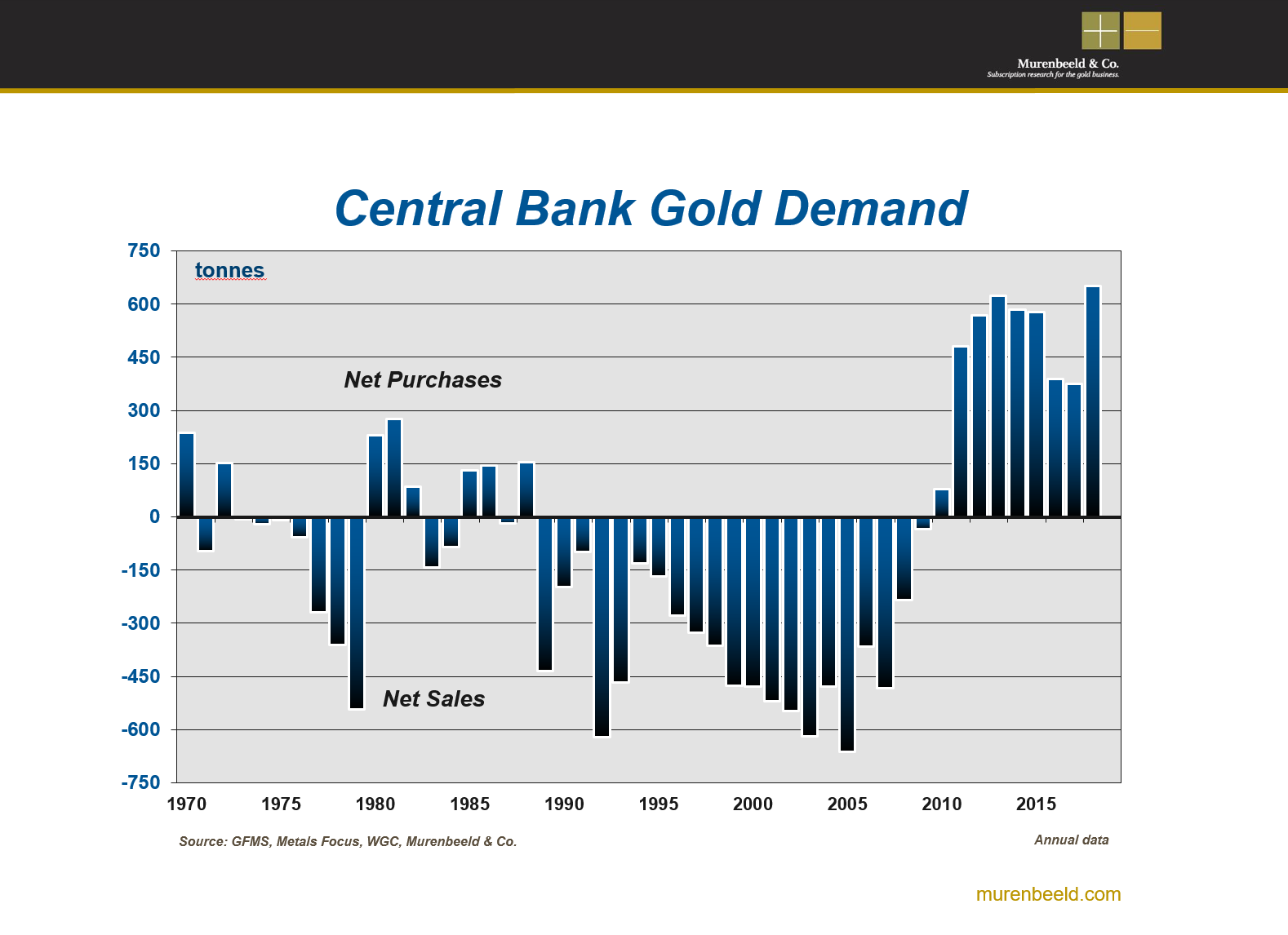
Supply & Demand
Gold is not like the other commodities. It acts far more like a currency as its drivers are inflation, interest rates and the U.S. Dollar.
The price of Gold doesn’t respond to changes in supply and demand. The chart below from Nick Laird shows that demand actually surged in the 1980s and 1990s, creating a rising deficit throughout the late 1980s and entire 1990s. But that was a time when the price trended sideways to lower.
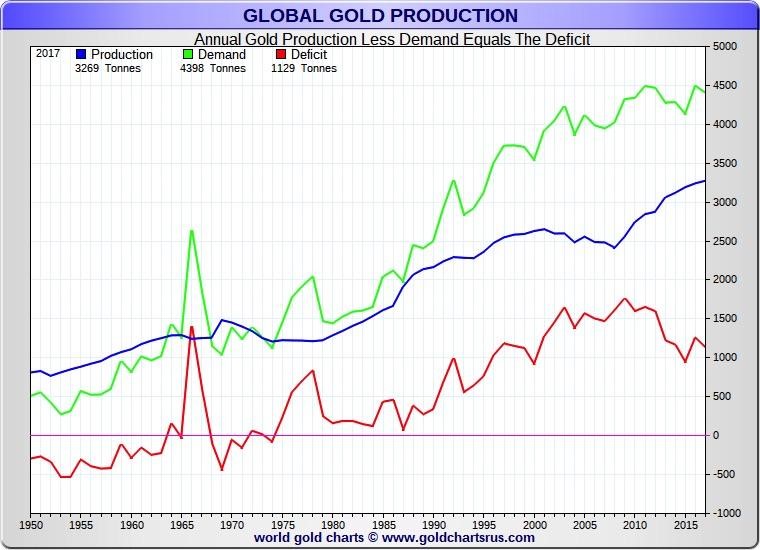
Part of the reason for that is jewelry demand is the largest component of Gold demand and it trends inversely to the Gold price.
It’s also important to note, Gold isn’t consumed like other commodities. Its supply grows in perpetuity. This is another reason its not impacted by supply and demand.
It’s also another reason why “Peak Gold” if true, will not impact the Gold price.
To sum things up, its ultimately inflation and interest rates which drive Gold because they drive real interest rates. Investment demand usually mirrors the trend in real interest rates and it impacts the price trend more than any other form of demand.
Other factors such as geopolitics, jewelry demand, Central Bank buying, Peak Gold and physical demand (which, if you read most gold bugs is always red hot) don’t impact the primary trend in the Gold price.
While Peak Gold or production difficulties do not affect the Gold price, they are hugely bullish for the companies that are making high margin discoveries or adding value to high margin deposits. Capital is flowing to the companies that are making these discoveries regardless of the trend in metals prices. When Gold fundamentals turn bullish, that is when massive amounts of capital will flow into juniors, creating a historic bull market. To learn which juniors have 3x to 5x potential over the next 12 to 18 months, consider learning more about our premium service.
The recent rally showed quite a bit of promise.
Gold stocks surged past their long-term moving averages while breadth indicators surpassed all prior bear market peaks (excluding 2016). 71% of the HUI and 81% of GDXJ closed above the 200-day moving average.
GDX and GDXJ looked to be on their way to $25 and $37, with Gold approaching $1360/oz and those breadth figures on the way to hitting 90%.
However, the stock market rebound pushed past its initial resistance and precious metals reversed course yet again before hitting those targets.
Other than 1985-1987 there has never been a bull market in precious metals without their simultaneous outperformance of the stock market.
Gold stocks and Gold especially have trended lower against the stock market since the end of December. The price action suggests this relative weakness should continue over the days and weeks ahead. If the ratios in the chart below lose the 200-day moving average then the next strong support becomes the 2018 autumn lows.
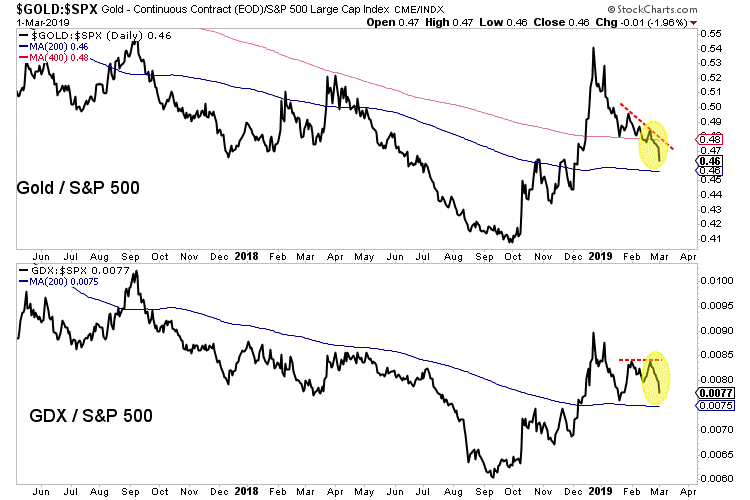
It was also disappointing that Gold peaked prior to touching $1360/oz. This leaves a noticeable lower high on the chart.
Meanwhile, Silver did not confirm Gold’s rise in February. It formed a double top as twice it failed at a confluence of resistance at $16.00/oz.
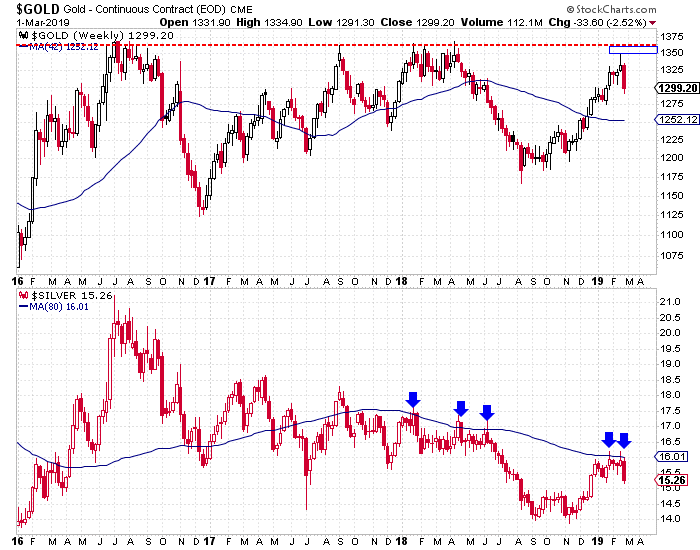
Turning to the gold stocks, we find the price action of the past two weeks is similar to the peaks in summer 2017 and January 2018.
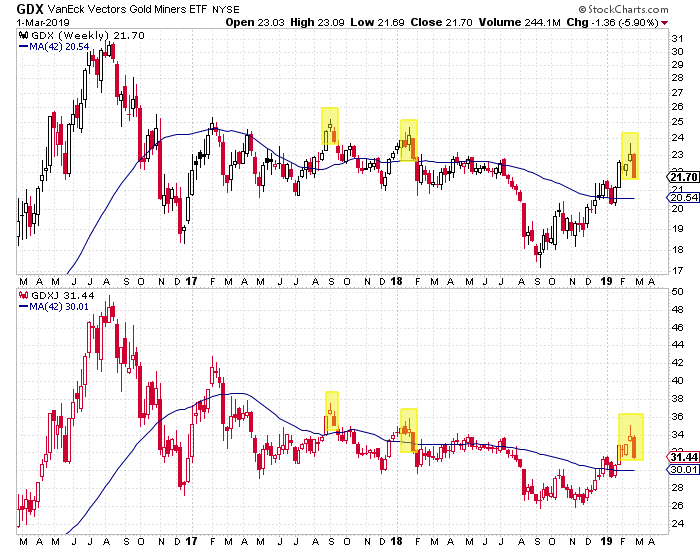
February 2019 figures to mark at least an interim peak in precious metals. The next key support for Gold and the gold stocks are the 200-day moving averages.
If the gold stocks can maintain recent breadth gains then the 200-day moving averages could mark an important low within a fledgling uptrend. If not, then a retest of the 2018 lows (especially in the gold stocks and Silver) becomes a stronger possibility.
As we noted last week, the near-term outlook for the stock market is bullish and in the current context that is negative for precious metals which cannot breakout or begin a bull market until the Fed turns from a pause to rate cuts.
Plenty of values remain in the mining equities and we should see more come about as spring beckons. To learn which juniors have 3x and 5x potential over the next 12-18 months, consider learning more about our premium service.
- The U.S. stock market and bullion swooned yesterday, but the GDX gold stocks ETF was up!
- Gold stocks continue to perform impressively. Rallies look impulsive and corrections feel solid.
- Please click here now. Double-click to enlarge this daily gold chart. Gold has pulled back by about 30% after staging an enormous $170/ounce rally.
- In the scenario shown on this chart, gold could trade down to the 50% retracement area and support zone at $1250-$1260.
- From there, the rally would resume and gold should surge to my next $1400 target zone.
- The next U.S. jobs report is on Friday, and that report is likely to help indicate whether gold range trades or pulls back to $1260 or so before that rally to $1400 takes place.
- Please click here now. Double-click to enlarge. My alternative scenario has the current area as the correction low, and a range trade between $1275 and $1350 would occur over the next few months.
- Even though gold has corrected by about $70 from the $1350 zone, some individual miners have barely corrected at all. This is another sign of a very healthy market.
- Over the weekend, some readers told me they were worried that Goldman Sachs’ influential analysts may be about to lower their $1425 gold price target back down to $1050.
- With thanks to the forexLive team, I’d like to put that worry to rest. For the good news, please click here now. Not only are Goldman’s analysts still positive about gold…
- They are raising their target prices!
- The Western gold community can relax and enjoy this price pullback because there’s nothing to fear and everything is fundamentally solid.
- Please click here now. There’s an important double bottom pattern in play on this FXI-NYSE Chinese stock market chart.
- I’ll also note that it closed higher yesterday while the American Dow fell hard. Tariffs progress, government stimulus, and bigger weighting in international indexes should push the FXI higher.
- In turn, that’s going to put Chinese citizens in a positive mood and make them eager to buy more gold.
- Please click here now. Double-click to enlarge this superb SIL silver stocks ETF chart.
- All silver stock enthusiasts should feel confident and happy when looking at this chart. That’s because the slope of the current uptrend is solid and sustainable.
- Violent rallies like the one in 2016 are not sustainable. They cause a lot of investor price chasing as they peak and tend to end very badly.
- The fundamentals of this market are much different from 2016. That’s why key research analysts at firms like Goldman are so positive on gold. Where gold goes, silver tends to follow.
- Silver can outperform gold without leading it. What I mean by that statement is that gold can be the first metal to make a new intermediate trend high, but the percentage gains for that move are bigger for silver. When silver leads gold, the market tends to be more speculative and that’s not healthy.
- Gains that are sustained come from a market where gold leads the trending action, and that’s what is happening now.
- Please click here now. Monster bank BMO says that the combination of falling mine supply and rising jewellery demand will provide a “tailwind” for the price of gold, propelling it higher into 2021.
- Some bank analysts feel mine supply will decline, some see it static, and some see it rising, but only slightly, but almost all of them see demand bigger than supply. Government debt and de-dollarization are likely to become much more significant drivers of demand by 2021 than they are now. Both the fear trade and the love trade should be solid tailwinds for gold in the years ahead.
- Please click here now. Double-click to enlarge. GDX bounced nicely off the $21.50 support zone yesterday. More gyration is likely, but I think GDX will rise above $24 before gold moves over $1350. This market is solid. Gold stocks look like tourists in a bus climbing up a mountain of fiat at a leisurely pace. My suggestion: Enjoy the ride!
Special Offer For Website Readers: Please send me an Email to freereports4@gracelandupdates.com and I’ll send you my “Golden Ten Baggers!” report. I highlight key gold stocks trading under $10 that are poised for ten bagger gains as gold moves to $1400! I include buy and sell tactics to help investors manage the action professionally!
Thanks!!
Stewart Thomson
Email:
Stewart Thomson is a retired Merrill Lynch broker. Stewart writes the Graceland Updates daily between 4am-7am. They are sent out around 8am-9am. The newsletter is attractively priced and the format is a unique numbered point form. Giving clarity of each point and saving valuable reading time.
Risks, Disclaimers, Legal
Stewart Thomson is no longer an investment advisor. The information provided by Stewart and Graceland Updates is for general information purposes only. Before taking any action on any investment, it is imperative that you consult with multiple properly licensed, experienced and qualified investment advisors and get numerous opinions before taking any action. Your minimum risk on any investment in the world is: 100% loss of all your money. You may be taking or preparing to take leveraged positions in investments and not know it, exposing yourself to unlimited risks. This is highly concerning if you are an investor in any derivatives products. There is an approx $700 trillion OTC Derivatives Iceberg with a tiny portion written off officially. The bottom line:
Are You Prepared?
The battle for Cornerstone Capital Resources Inc. (TSXV-CGP, OTC-CTNXF) is heating up following a preliminary takeover bid from joint venture partner SolGold. However, Cornerstone is likely to reject the overture, based on its latest press release on the matter and on comments by Glen McKay, a co-founder and former president and CEO of the junior mining exploration company.
Cornerstone has a joint venture agreement with SolGold on the Cascabel project in Ecuador, which is believed to be one of the world’s largest gold-copper deposits. SolGold is the operator of the Cascabel project and owns a majority stake. Larger gold players are also involved, with both BHP Billiton and Newcrest Mining holding minority positions in SolGold.
In a February 8 press release, Cornerstone noted that SolGold had issued a press release of its own on January 31, announcing its intention to commence an offer to acquire all of the issued and outstanding common shares of Cornerstone in an all-stock transaction, providing 0.55 of a SolGold share for every one Cornerstone share tendered.
“As previously announced by Cornerstone, shareholders of the company that collectively own over 50% of the company’s outstanding shares have notified Cornerstone that they will not support the terms announced by SolGold,” the Cornerstone release stated. “As a result, if SolGold proceeds to make a formal offer on these terms, the company believes that SolGold’s offer would be incapable of being successfully completed.”
The Board of Directors of Cornerstone said it had assessed the SolGold proposal with its financial advisor and believes that the proposal significantly undervalues Cornerstone. The Cascabel Project is owned by SolGold’s 85% owned Ecuador subsidiary Exploraciones Novomining S.A. (ENSA). The remaining 15% of ENSA is currently held by Cornerstone. In addition, Cornerstone owns approximately 9.2% of the outstanding shares of SolGold. In effect, Cornerstone has a combined direct and indirect 23% interest in the Cascabel concession.

Cornerstone said it was disappointed by SolGold’s latest press release, stating that it contains “numerous inaccurate and misleading statements and baseless innuendo.” Still, Cornerstone said it remains open to constructively discussing with SolGold and other potential bidders any value enhancing transaction that would garner the support of Cornerstone’s shareholders.
In an interview, Cornerstone co-founder and former chief executive Glen McKay called the SolGold preliminary offer a poor bid, or an offer so far below the current value that under most circumstances it will be rejected. McKay is a major shareholder and a special advisor to Cornerstone. “I know that we can identify 60% of shareholders who have been surveyed and unanimously we are going to reject the offer, if SolGold comes with it,” McKay said. “They may still come with an offer, but it will be a waste of their money to do so and will be really embarrassing for SolGold.” An additional factor is that SolGold is mostly an illiquid stock so that even if Cornerstone accepted the deal there would be little chance of current CGP shareholders being able to monetize their new shares of SolGold in the short term.
The price SolGold is offering is not based on the fair value of the Cascabel project, McKay said. In addition, he says there are a number of issues with the joint venture agreement between SolGold and Cornerstone that have not been fulfilled.
This may not be an issue in the future, if BHP Billiton or Newcrest or some other suitor comes in with an offer for both companies and consolidates them. But for now, McKay says SolGold is not in a position of strength and the deal as it stands is “not going to happen.”
Stressing that he can’t predict the future, McKay nonetheless believes that another bid for Cornerstone will take place, perhaps as soon as this year. Although BHP Billiton has signed a deal which rules out a takeover bid until November, Newcrest Mining is under no such restriction.
Newcrest has signed two major joint venture agreements with Cornerstone in the last couple of months, McKay notes, including an agreement on the Cana Brava project in Ecuador and the Miocene property in Chile.
McKay sees the two deals as an indication that Newcrest is positioning itself for a bid so that they are in a good place in terms of their relationship with Cornerstone. “If I had to make a bet, I would say that Newcrest is the front runner and it may be that they will do it as a partnership,” he says. “I think something will happen before the end of 2019. We’re hoping that another interested player comes in and starts a bidding war.”
With consolidation on the rise in the metals sector, a SolGold-Cornerstone merger perhaps makes sense, although SolGold may have to sweeten its offer to cement the deal. But Cornerstone’s initial negative response suggests even that won’t be enough. For now, interested observers will have to be content to wait for another missive from SolGold to see if the offer changes or is simply shelved.
Whatever the outcome, McKay believes that Cornerstone will spin off its other assets before a sale of its interest in Cascabel due to the potential of other properties that are under other JVs such as the Bramaderos project in Ecuador. Malcolm Norris, the CEO of Cornerstone partner (Sunstone) on the project was the CEO of SolGold in 2012 when Cornerstone completed a JV deal on Cascabel. Norris and Cornerstone VP Exploration Yvan Crepeau are due the credit for the discovery of Cascabel, McKay says. They are hoping to replicate that success on Bramaderos.
If you would like to receive our free newsletter via email, simply enter your email address below & click subscribe.
CONNECT WITH US
Tweets
Tweet with hash tag #miningfeeds or @miningfeeds and your tweets will be displayed across this site.
MOST ACTIVE MINING STOCKS
Daily Gainers
 Lincoln Minerals Limited Lincoln Minerals Limited |
LML.AX | +125.00% |
      |
GCR.AX | +33.33% |
      |
CASA.V | +30.00% |
      |
AHN.AX | +22.22% |
      |
ADD.AX | +22.22% |
      |
AZM.V | +21.98% |
      |
NSE.V | +21.05% |
      |
DYG.V | +18.42% |
      |
AAZ.V | +18.18% |
      |
GLA.AX | +17.65% |

 Follow us on Twitter
Follow us on Twitter Become our facebook fan
Become our facebook fan







